兰往-Ladésee Hotel:凝固的窗框,偶然的风景
The Fixed Window Frames, The Ever-changing Scenery
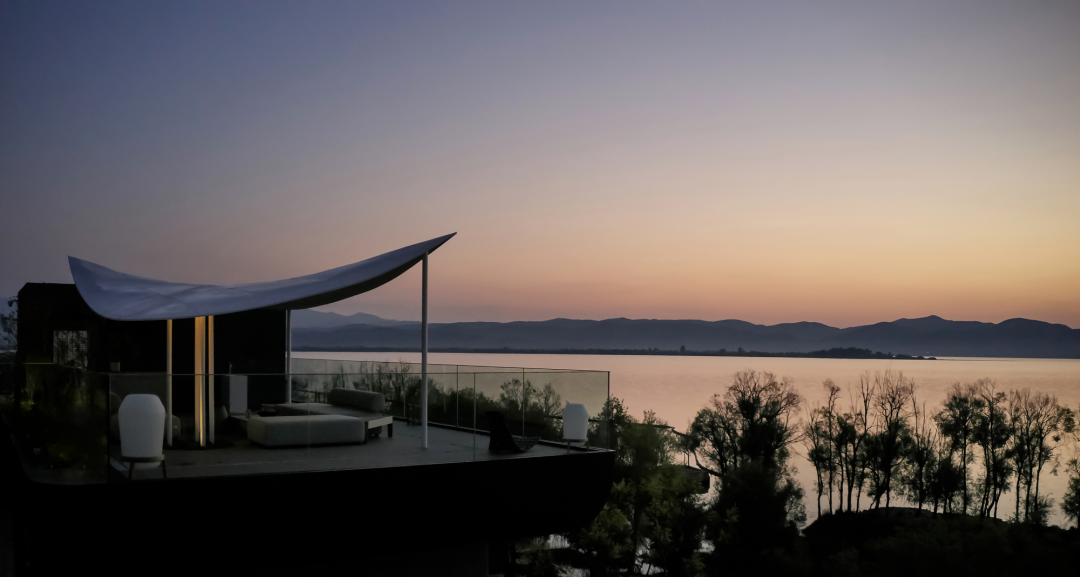
苍山。洱海。
环海路。桃源村。
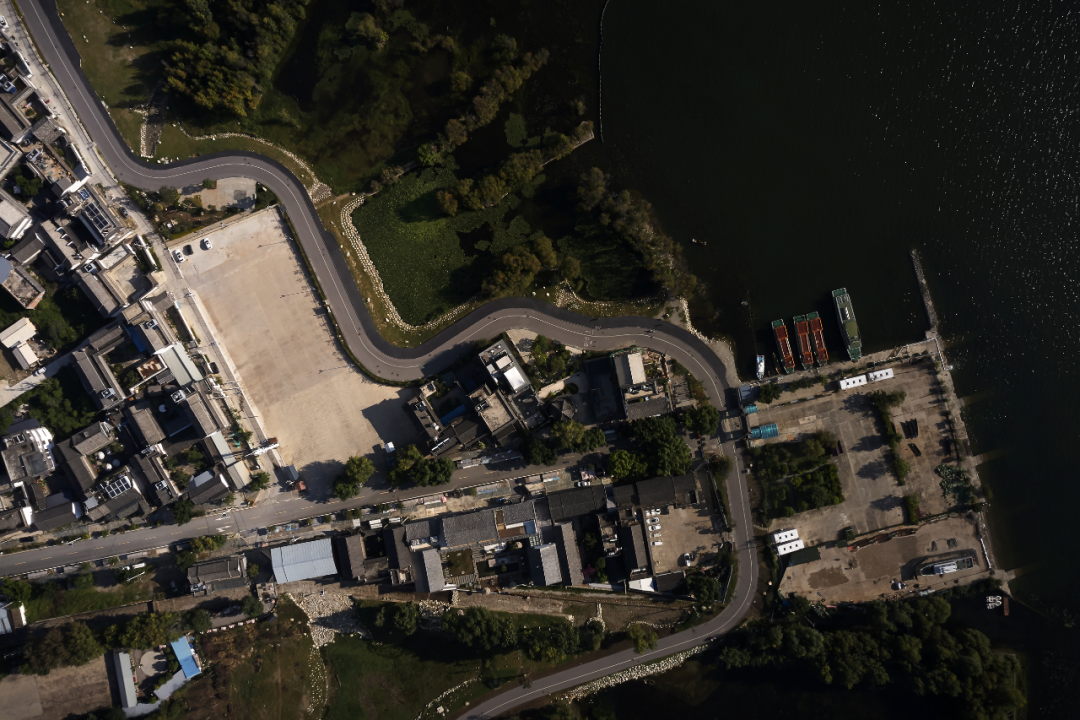

▲ 航拍俯瞰图
Lan-Ladésee Hotel is located in Taoyuan Village, Huanhaixi Road, Dali, a quiet and pristine Bai village. It is bordered by Erhai Lake in the east, Zhoucheng in the south, and Yunong Peak of Cangshan Mountain can be seen to the west.
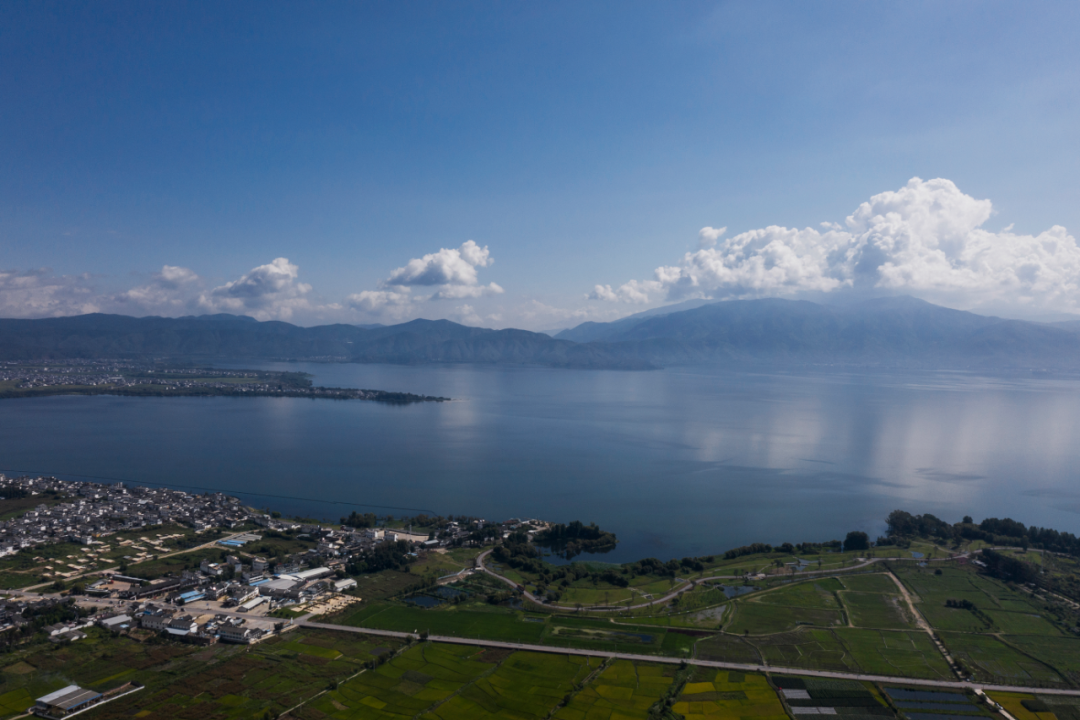
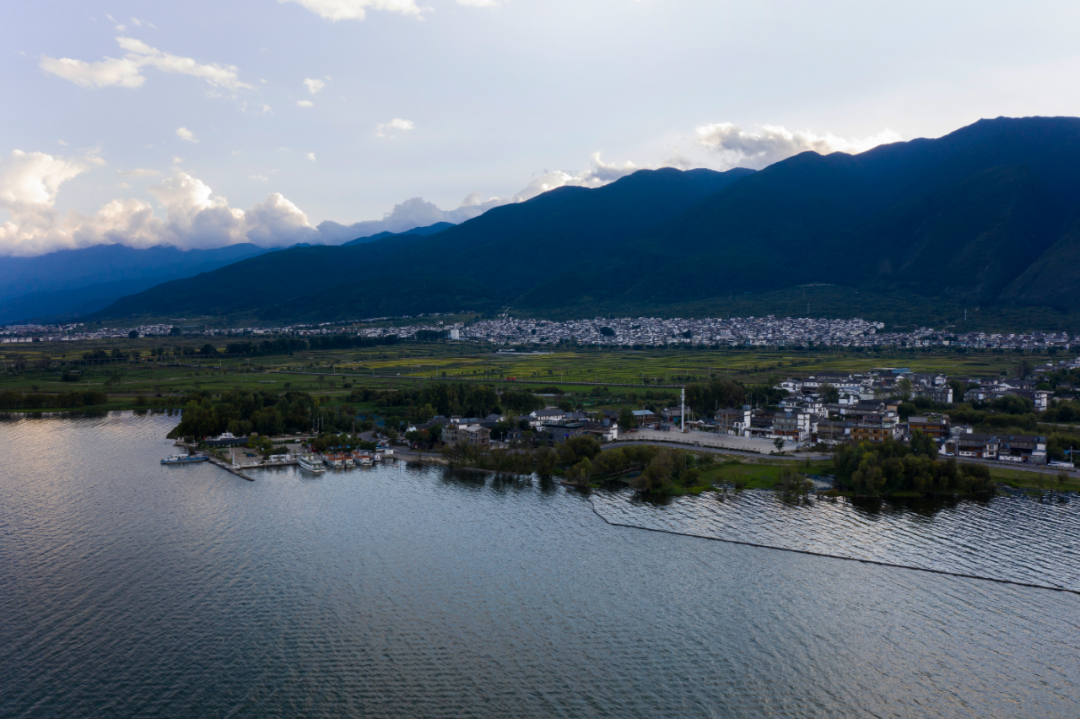
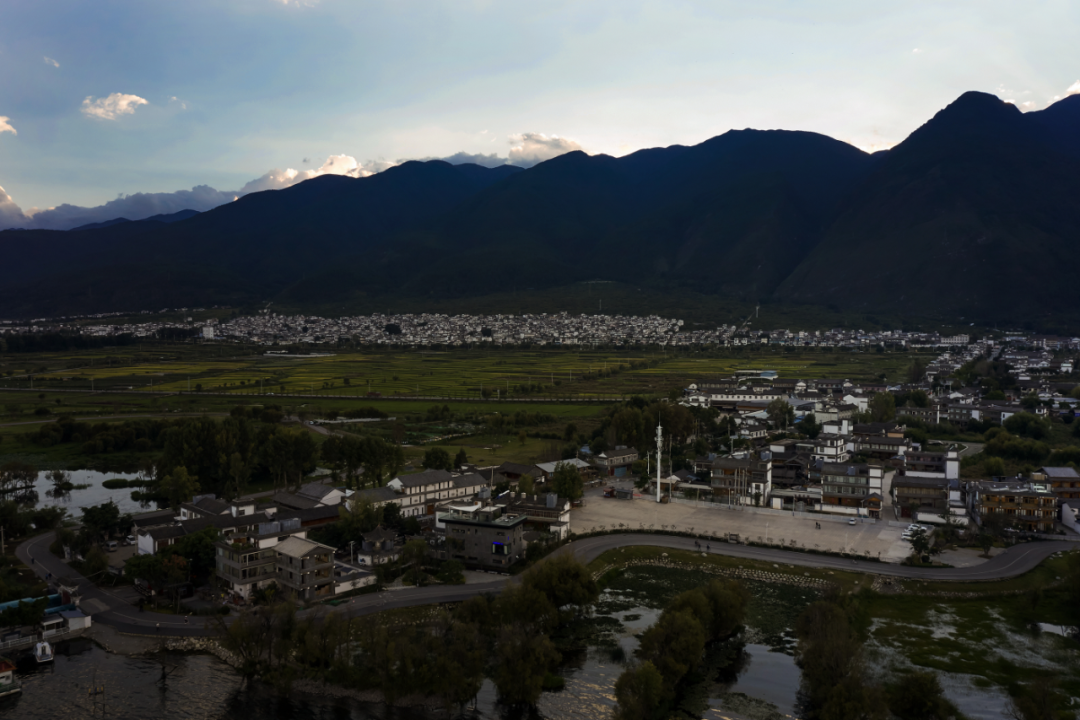
▲ 傍晚的村庄,宁静的生活
房子建在离桃源码头不远的地方。面朝洱海,跨过门口的环海西路,便是近海漫灌向岸边的湖泊、夏日莲叶田田的荷景,以及生长于水中的湿地树林,再稍远些便是桃源码头。房子的背后是苍山,近处可见苍山脚下绵延的村落,以及人们春种秋耕土地。
The house is built facing the Erhai Lake. The Huanhaixi Road across the door is the lake that floods the shore, the lotus scenery of summer lotus leaf fields, and the wetland woods that grow in the water. A little further away is the Taoyuan Wharf. Behind the house is Cangshan Mountain, and the villages at the foot of Cangshan Mountain can be seen nearby, as well as people planting land in spring and autumn.


▲ 朝霞之下的建筑
1
现代/传统 Modernity and Tradition
这是一幢拥有三层楼高、带庭院和屋顶的近海民居房。
The facade of the building is made of local stone, calm and low-key, simple and natural, and the rough skin texture gives people a unique perception, awakening the close relationship between the building and nature. The white giant flying wing is a product of modern construction craftsmanship, but its shape echoes the traditional flying cornice. It rises and falls on the roof, sails and birds, which means freedom and yearning, and extends the imagination of living and traveling in it.

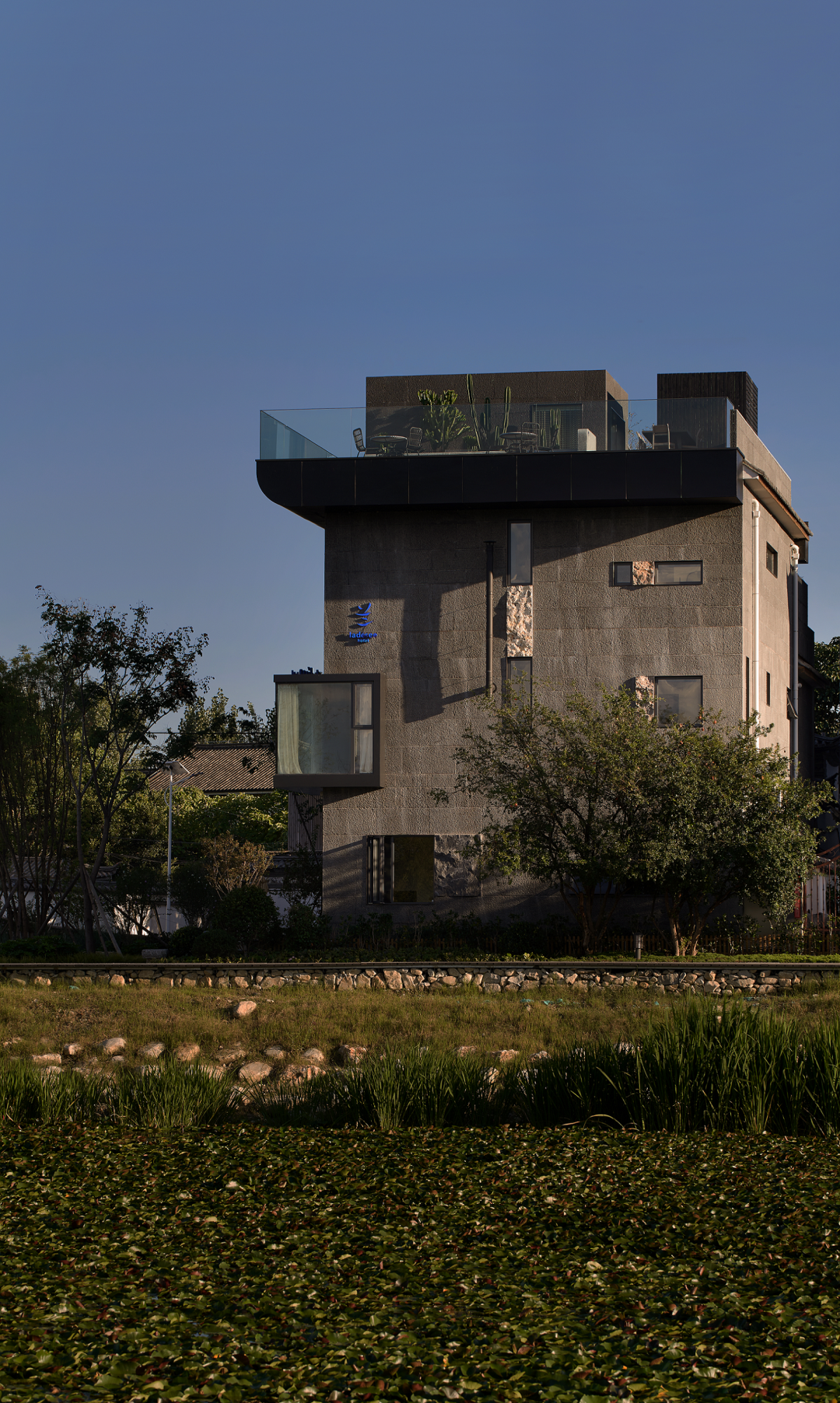
▲ 从荷叶丛生的近海湖看向建筑
重新凿墙辟窗,长条形的开窗方式在横向和竖向上为建筑的外立面带来平稳与简洁的现代性,方形的窗孔则随着窗框大小的变化为建筑注入呼吸感。深灰色的三角斜挑作为一种偶然,向外微微扩张,塑造着建筑的张力。

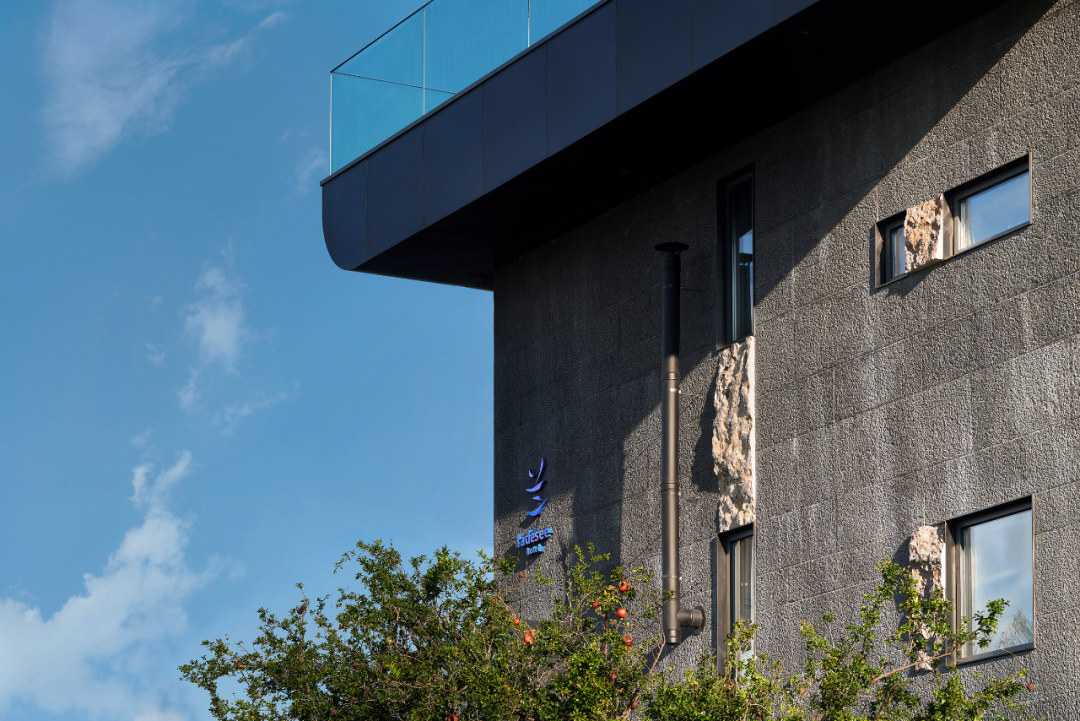
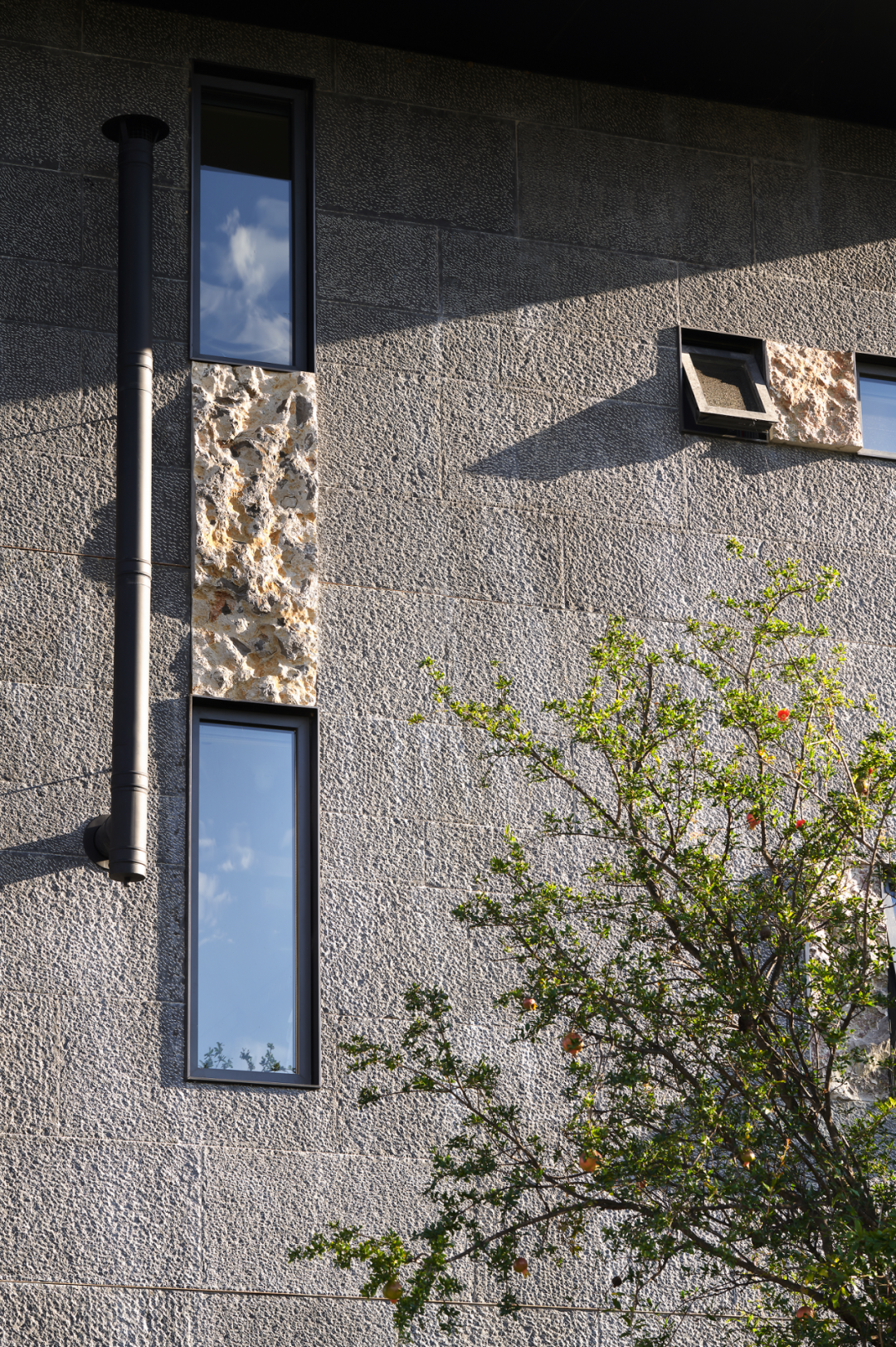 ▲ 建筑外立面
▲ 建筑外立面
从当地石料中开采出来的有色石皮,或杂白或青绿或锈黄,以点缀的手法镶嵌于立面之上。自然的嶙峋表皮,彰显着来自山中之石的桀骜,输出在地性的同时,也给建筑增添了浑厚与质朴的气息。
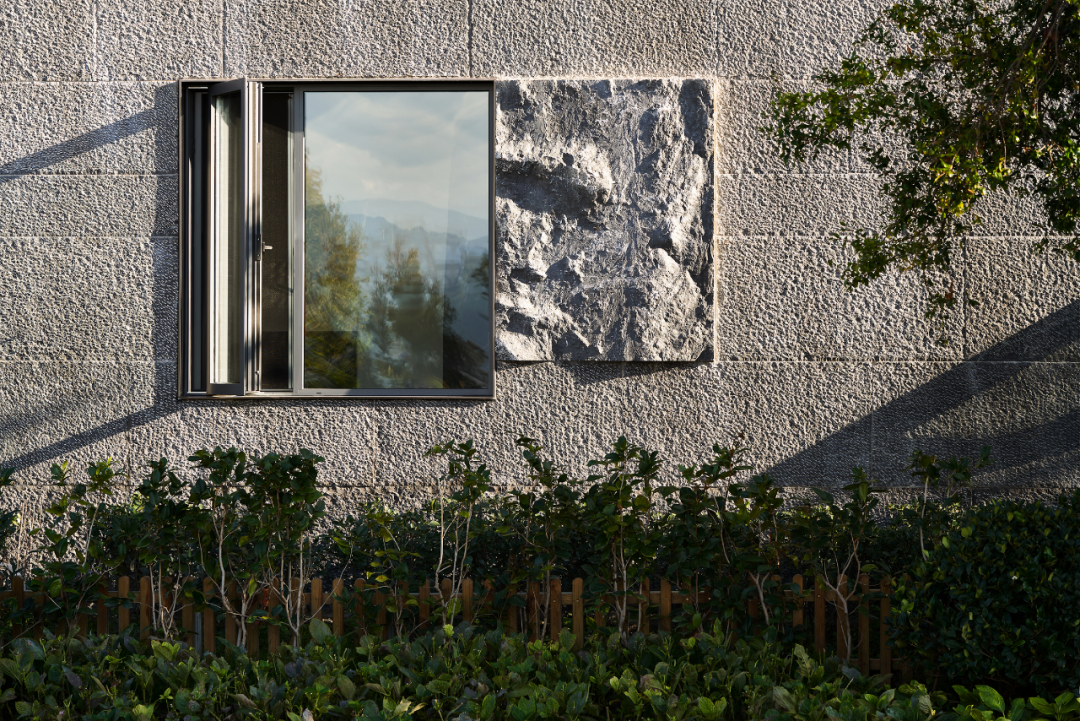
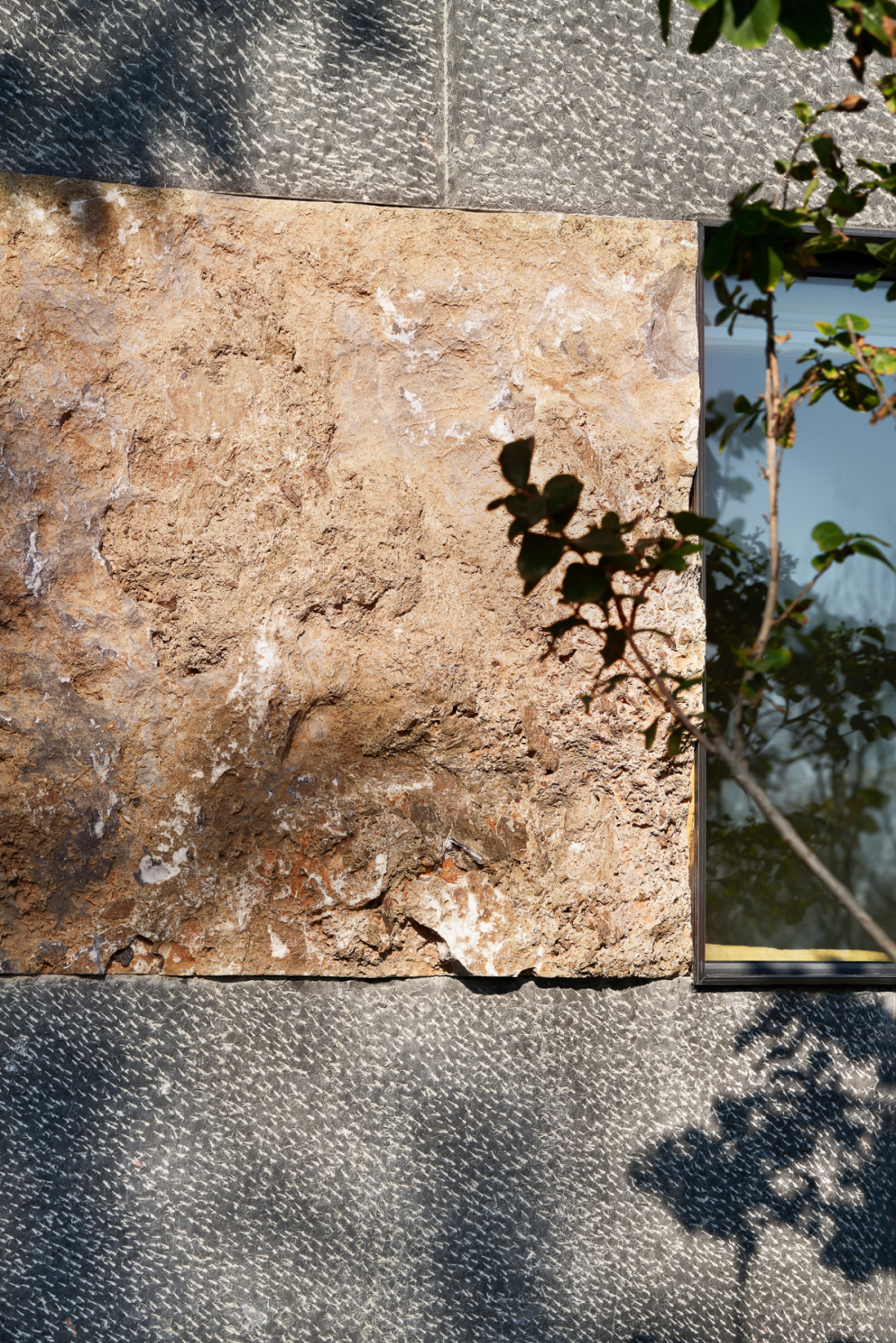
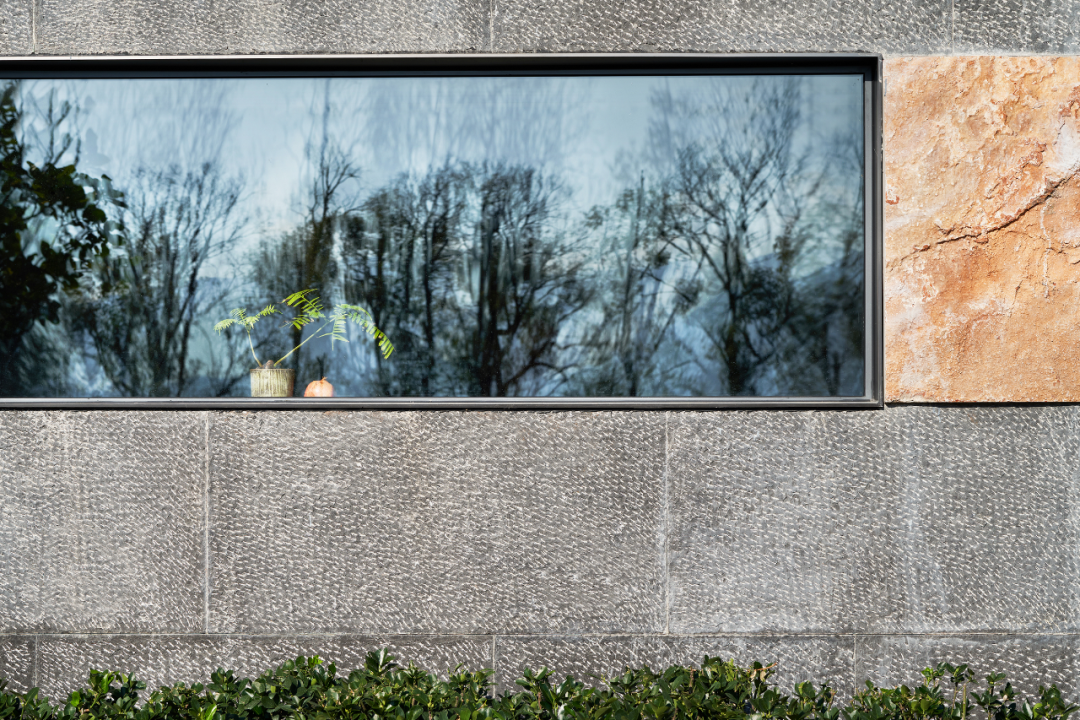 ▲ 建筑外立面墙皮与细节
▲ 建筑外立面墙皮与细节
从环海西路进入酒店前的浅巷,伴随着低矮的当地拼接式石头墙与延伸的巷道小景,白族传统的门头作为主入口伫立在浅巷的尽头,白色古朴的照壁透过门楣,形成景深式的视觉文化符号体验。
青砖青瓦、翘角飞檐,古朴而幽远,空间场所的在地性身份因此而显现。
Entering the shallow alley in front of the hotel from Huanhai West Road, along with the low local stone wall and extended lane landscape, the traditional door of the Bai nationality stands at the end of the alley as the main entrance. White quaint screen wall through the doorway, forms a depth-of-field visual experience with cultural symbol.
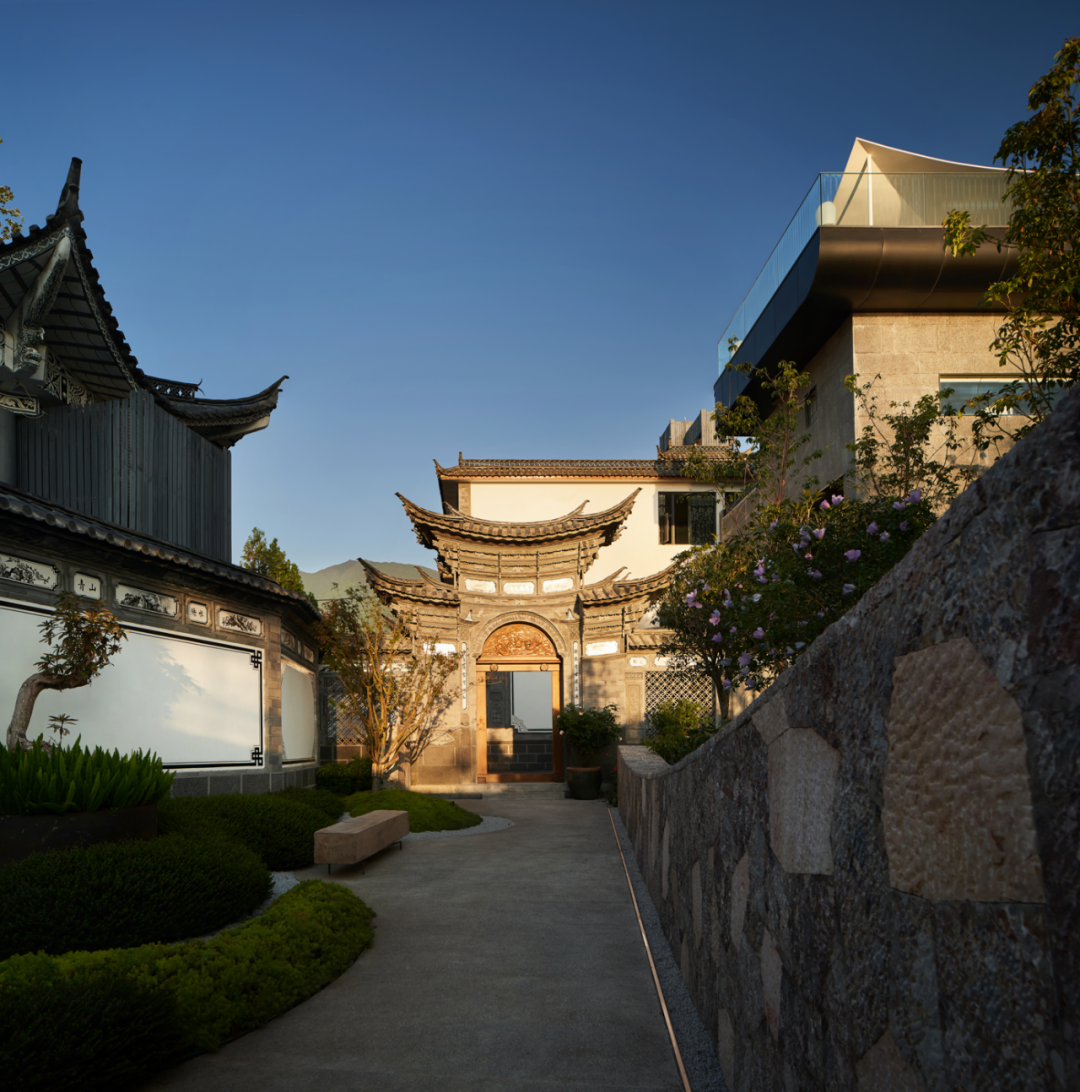
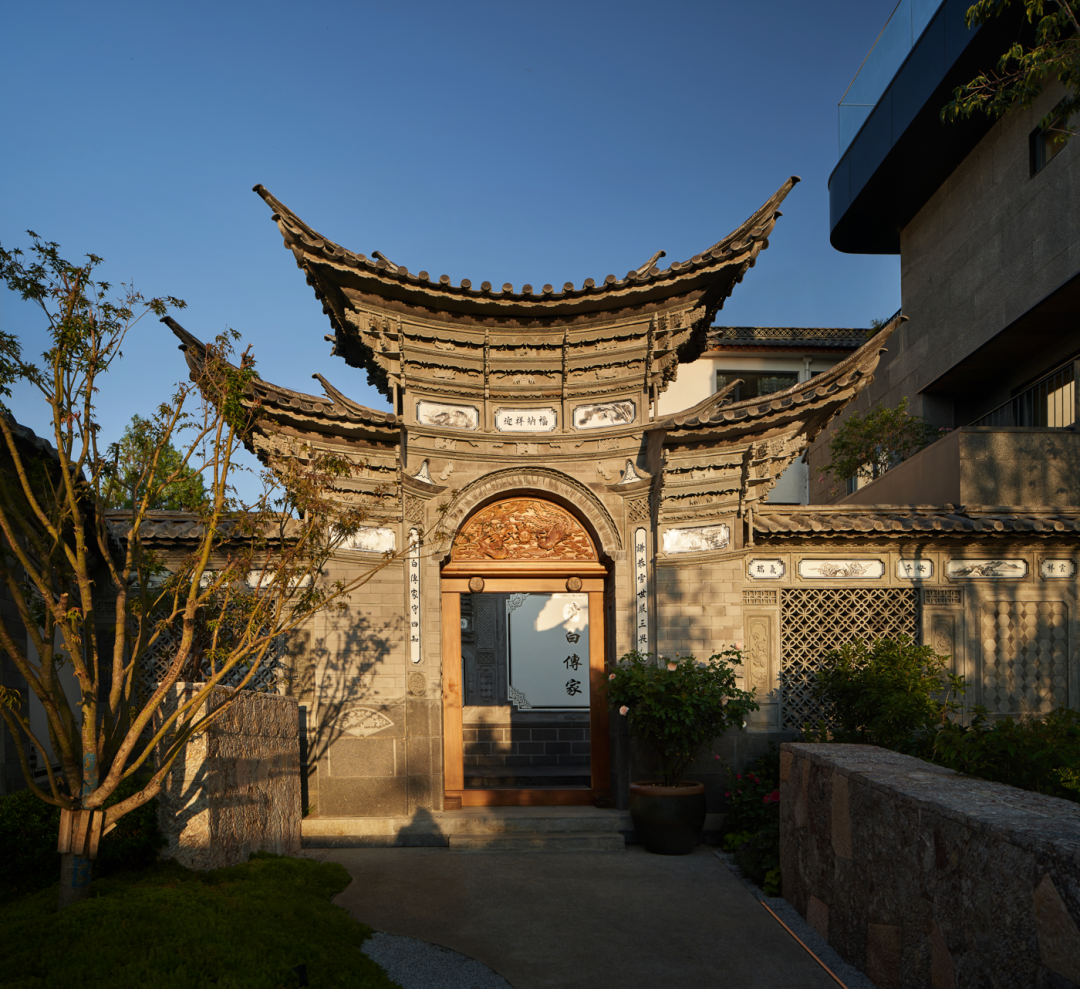
▲ 主入口
与此同时,院落格局从传统进出方向的排列上被挪转为并列的横向结构,传统性作为一种文化元素与美学氛围,得到灵活取用。
The courtyard layout has been shifted from the traditional arrangement to the parallel horizontal structure. Tradition, as a cultural element and aesthetic atmosphere, is used flexibly.

▲ 从洱海看向建筑-夜景

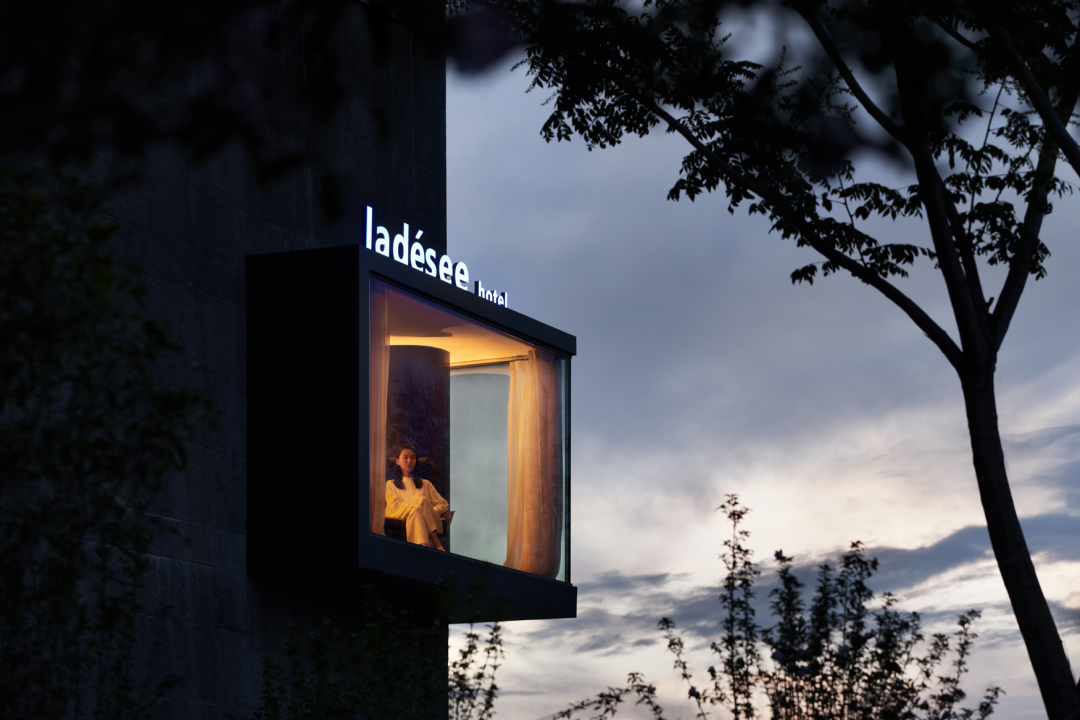 ▲ 夜晚,建筑外立面的局部
▲ 夜晚,建筑外立面的局部
边界/延伸 Boundary and Extension
The courtyard is placed between the traditional wall and gate,and the landscapes with flowing water is evenly distributed on both sides with the entrance as the core. The lying rocks and the coarse pottery jars in the water are placed in two water-scapes respectively, forming the epitome of the rolling mountains and the full moon in the water.
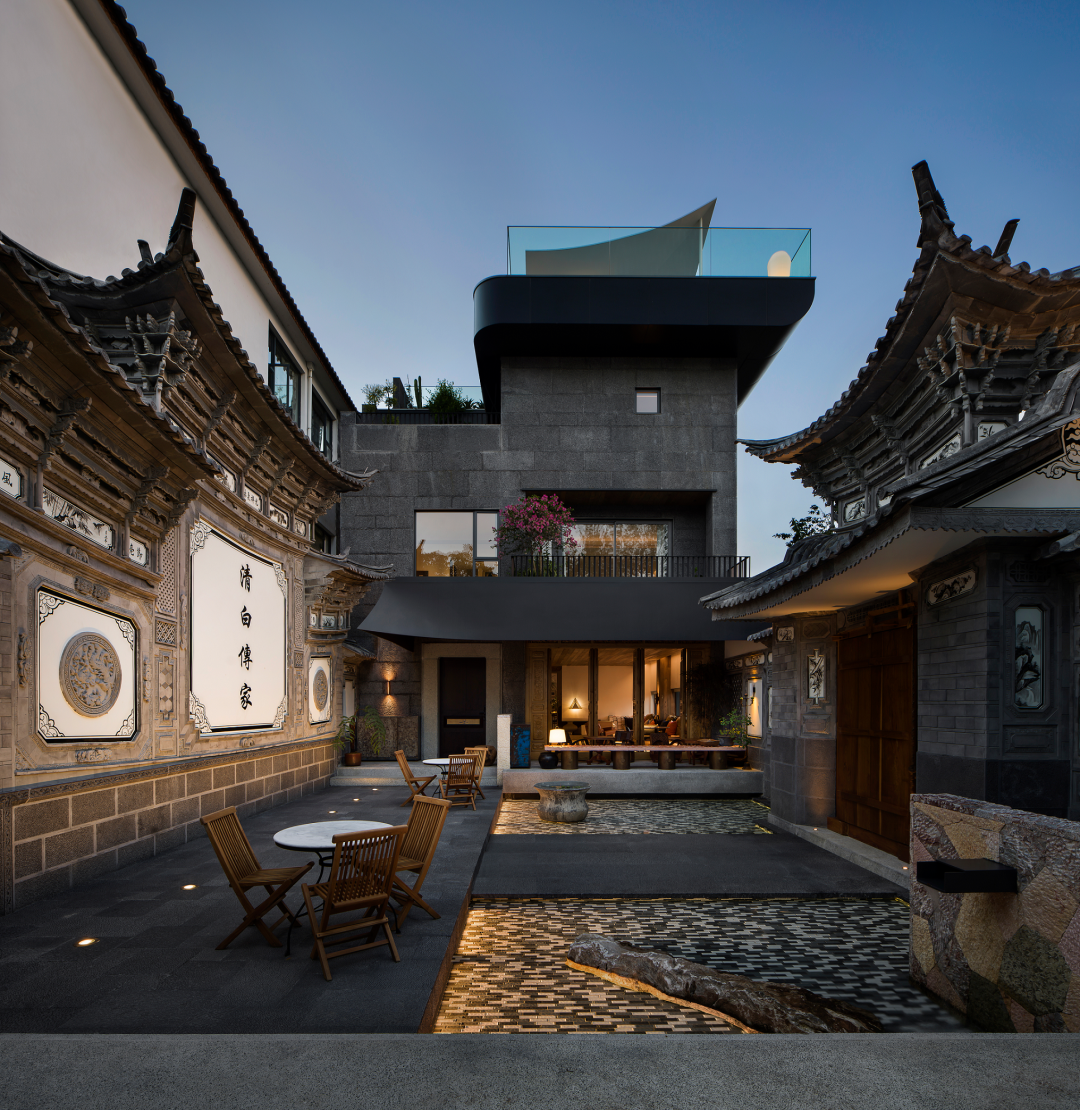
▲ 黄昏时的前院
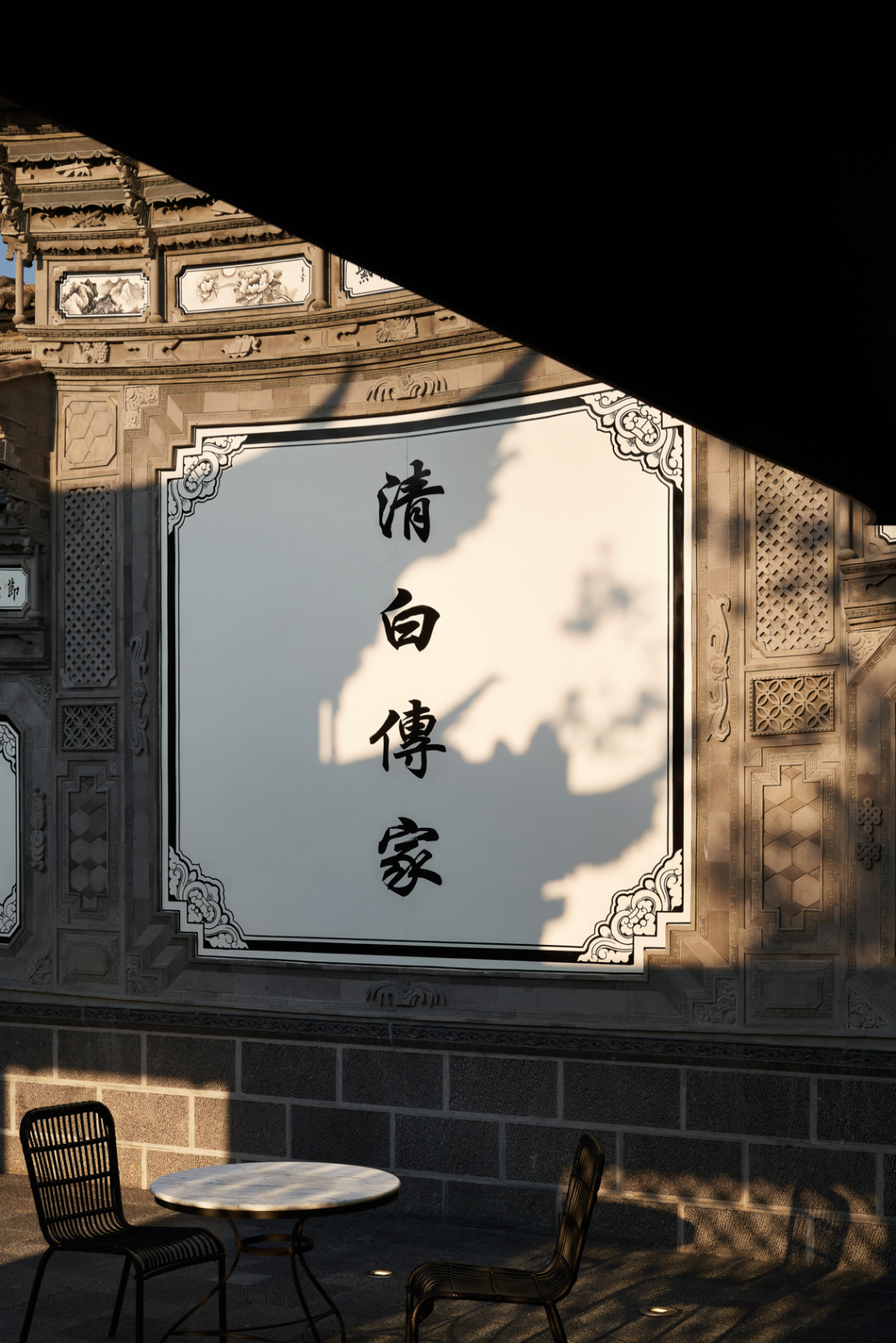
▲ 前院的照壁 The traditional wall in front yard
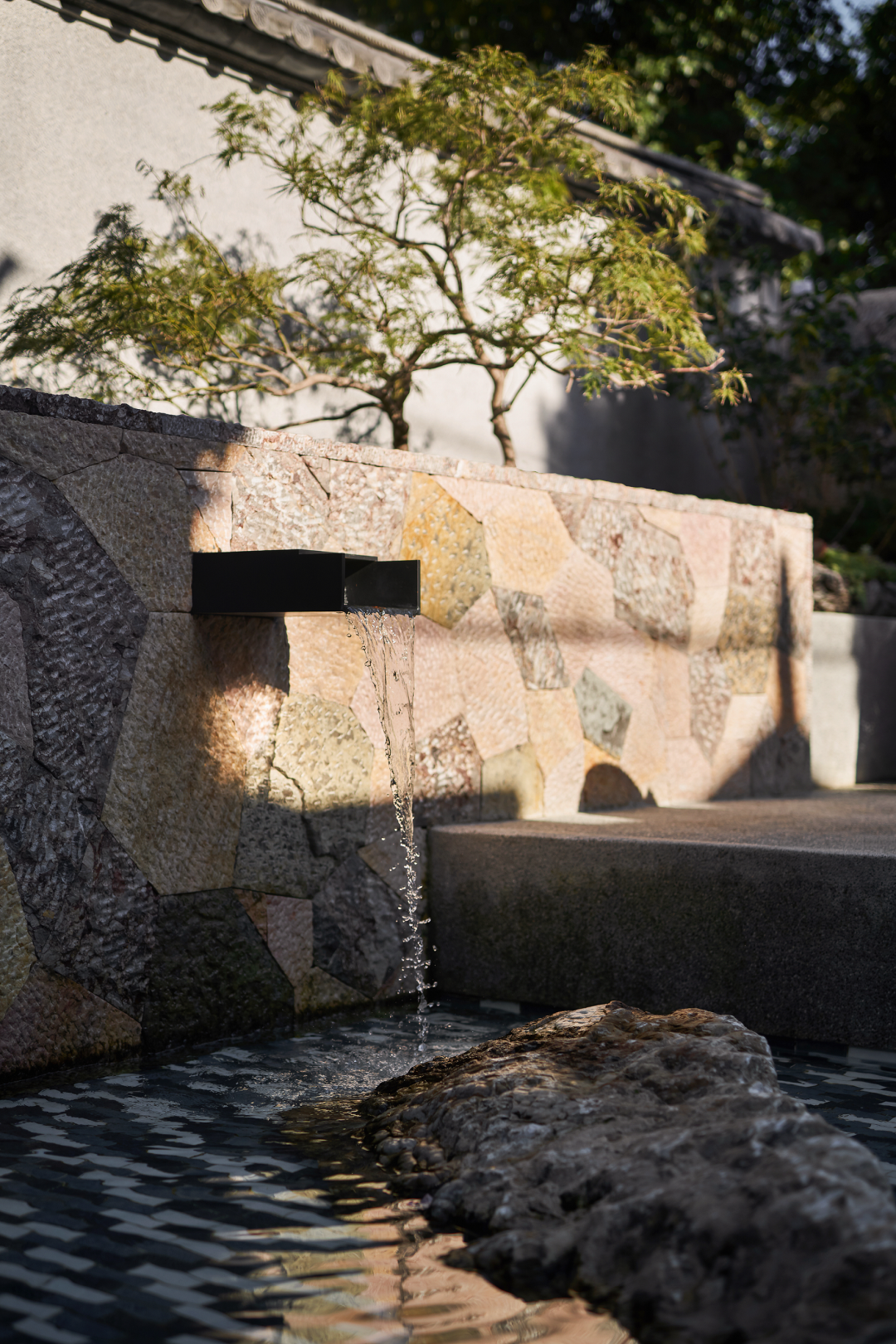
▲ 前院的水景 The waterscape in front yard
The clean outdoor sofa, mixed plants with modern plants and flowers, feather maple, rose, hydrangea, and an outdoor heating fireplace. In order to establish the richness and difference in experience, in the creation of the landscape atmosphere, it is slightly separated from the waterscape courtyard at the main entrance.
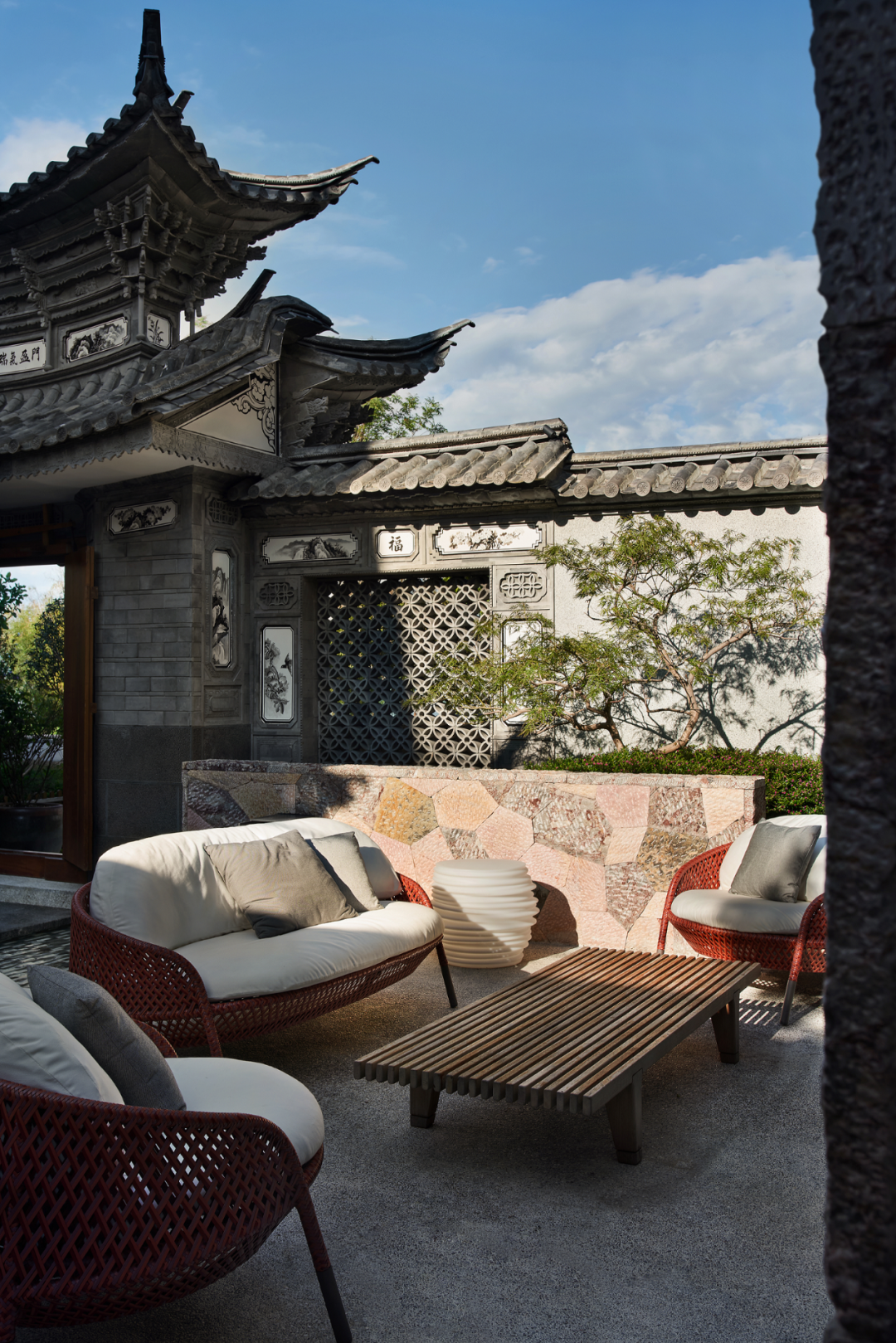
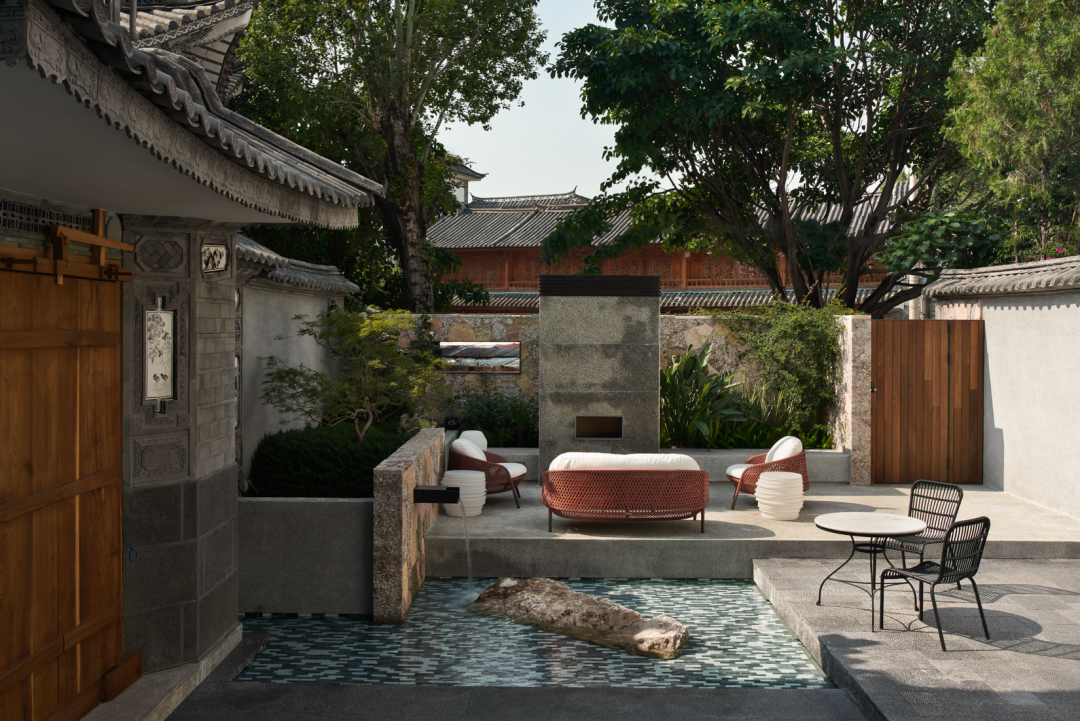
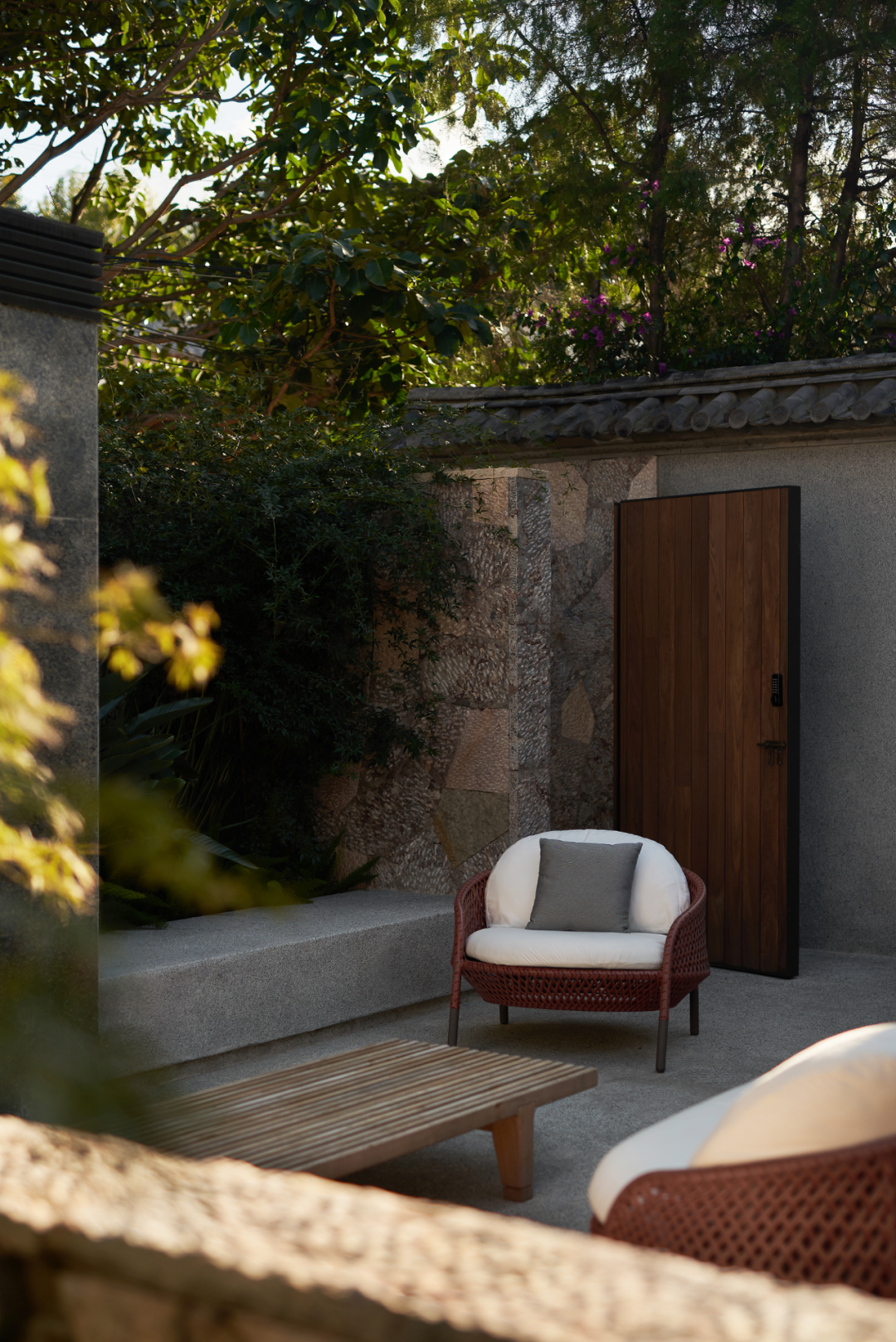 ▲ 后院/后花园 Back yard
▲ 后院/后花园 Back yard
后花园连通后门,通向市井熙攘的桃源码头。这是兰往酒店另一个幽蔽的入口,蜿蜒的墙壁下设立可供休憩的区域,浓荫蔽日的天气里,驳杂的墙壁上日影潺潺;横向开凿的窗洞,在边界上留下了可供视觉穿透的印迹。
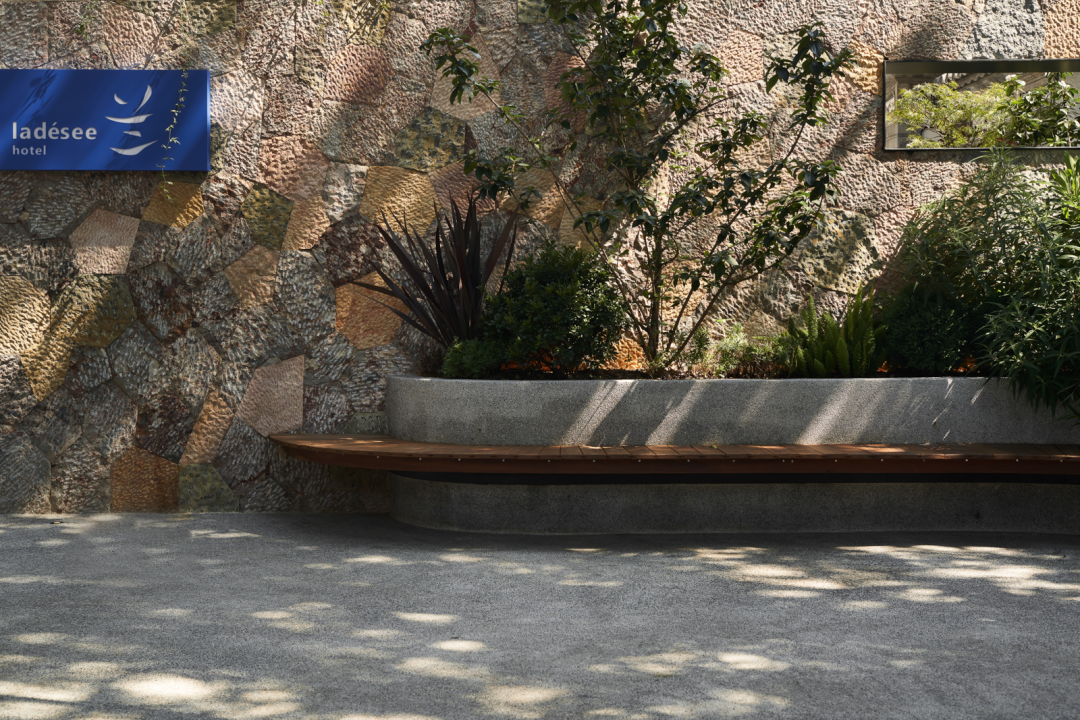
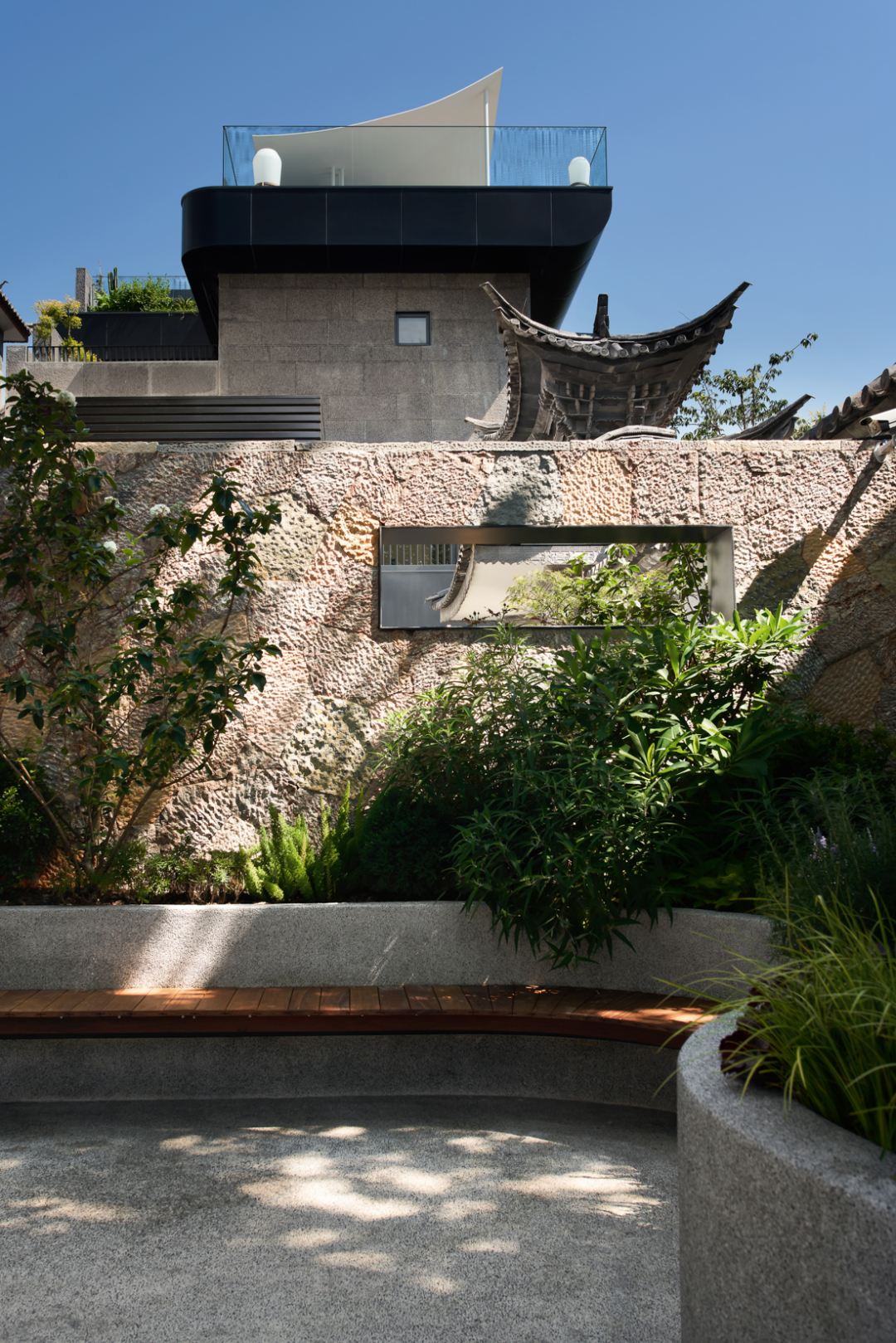 ▲ 后门外侧 The outside of back gate
▲ 后门外侧 The outside of back gate
院墙连接房屋,古朴的瓦楞窗与通往室内的雕花扇门以边界的方式被保留下来,但隔而有间的传统园林意境,使得视觉上的渗透与延伸从未停止。
The courtyard wall connects the house, and the primitive corrugated windows and carved doors leading to the interior are preserved as boundaries, but the traditional gardening technique never stops the visual penetration and extension.
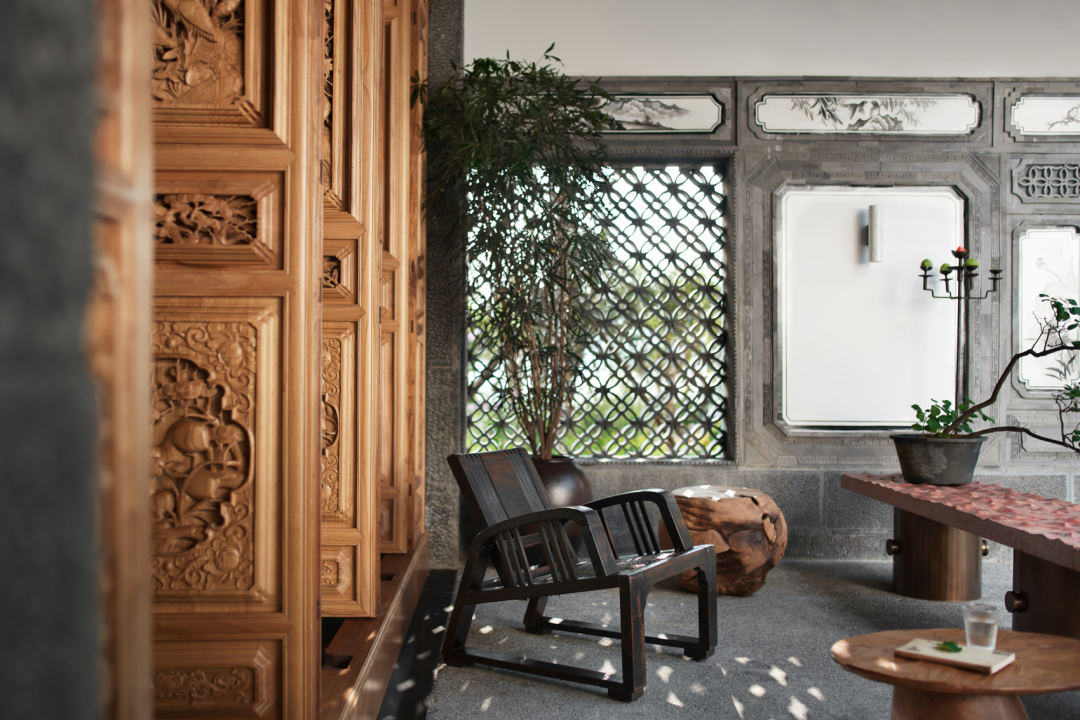
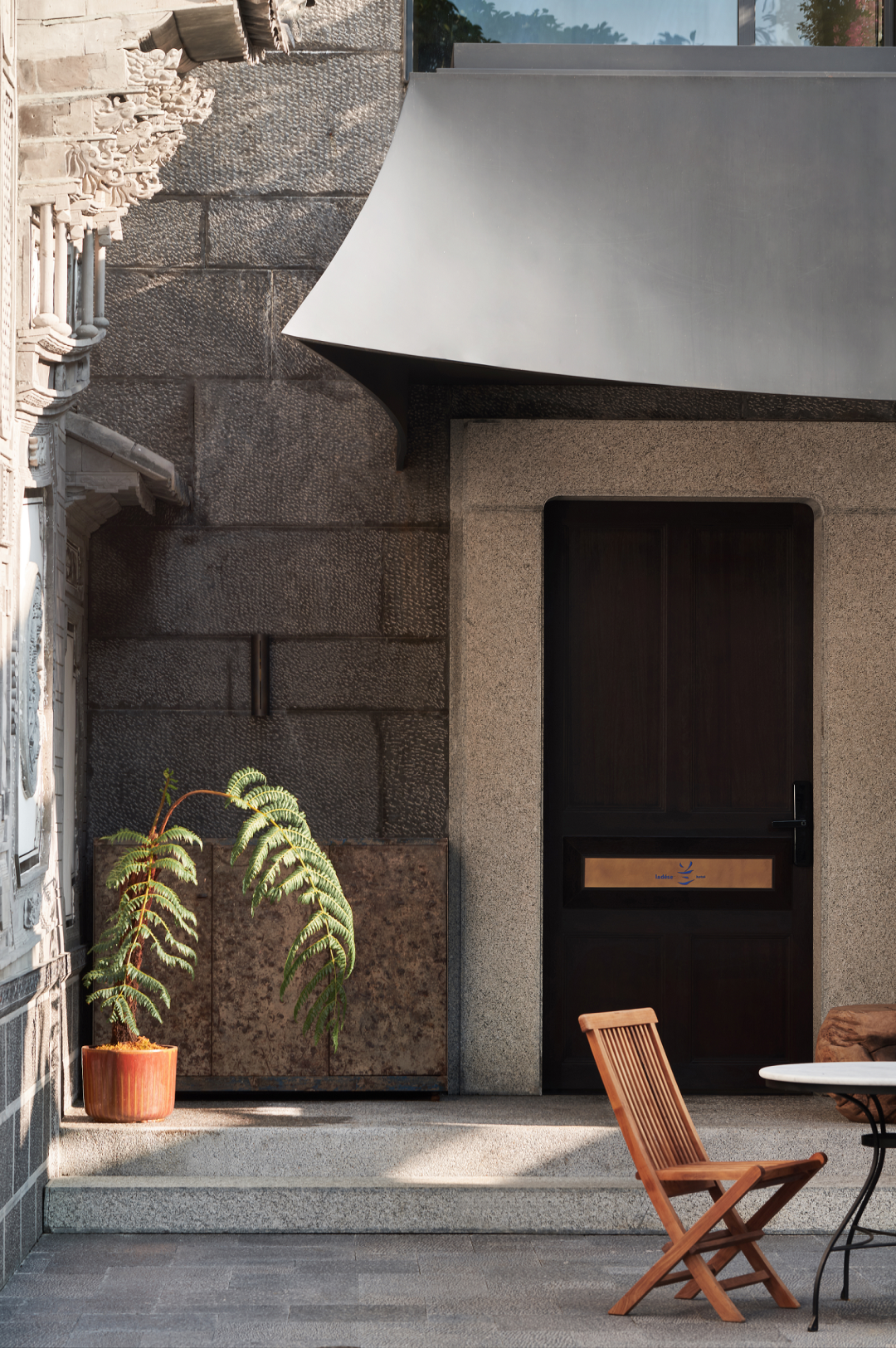 ▲ 一楼客厅外的廊檐下
▲ 一楼客厅外的廊檐下
光影/日常 Shadow and Daily life
The direction of the window and the arrangement pattern of the door leaves make the boundary floating due to the rising and sinking of light and shadow, giving birth to an tranquil atmosphere and moving poetry, creating a balance related to dislocation and subtlety.
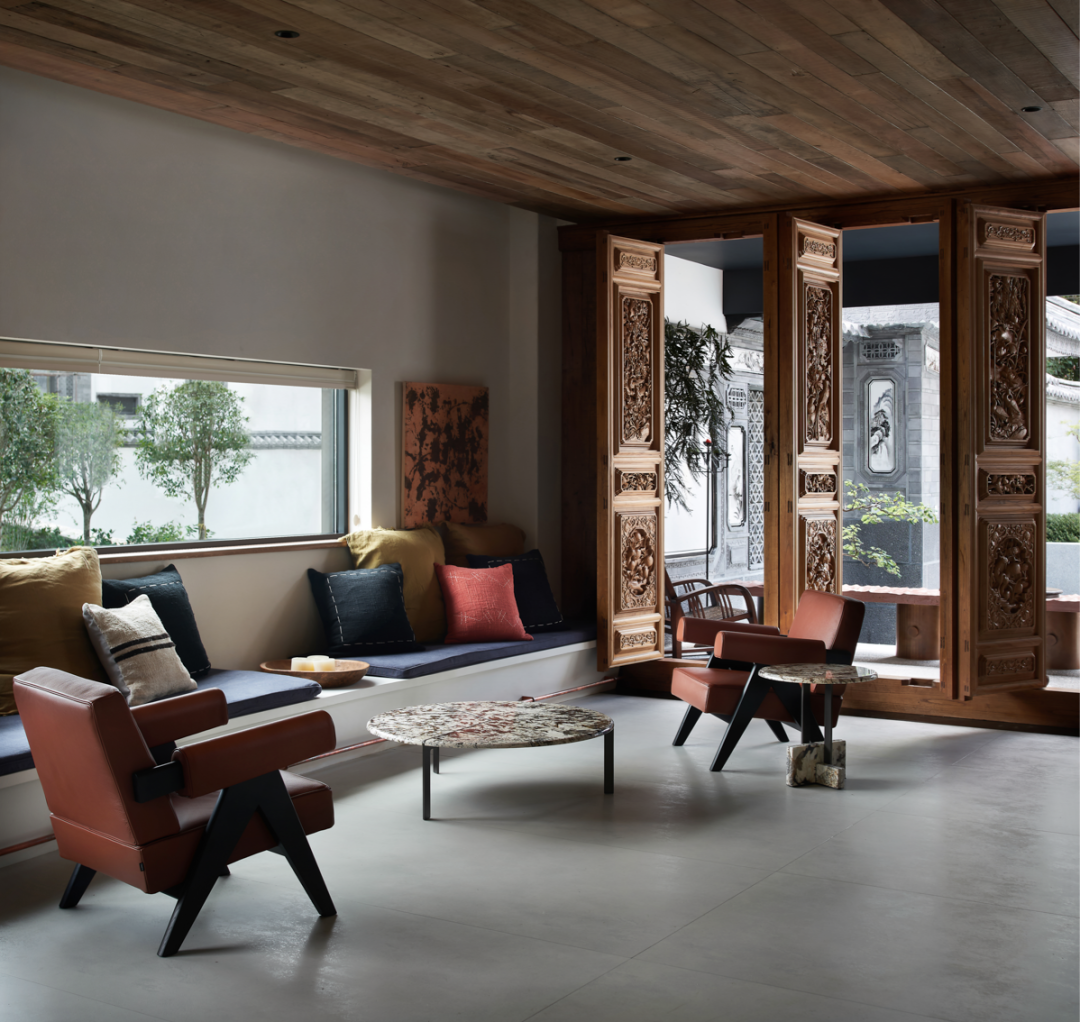
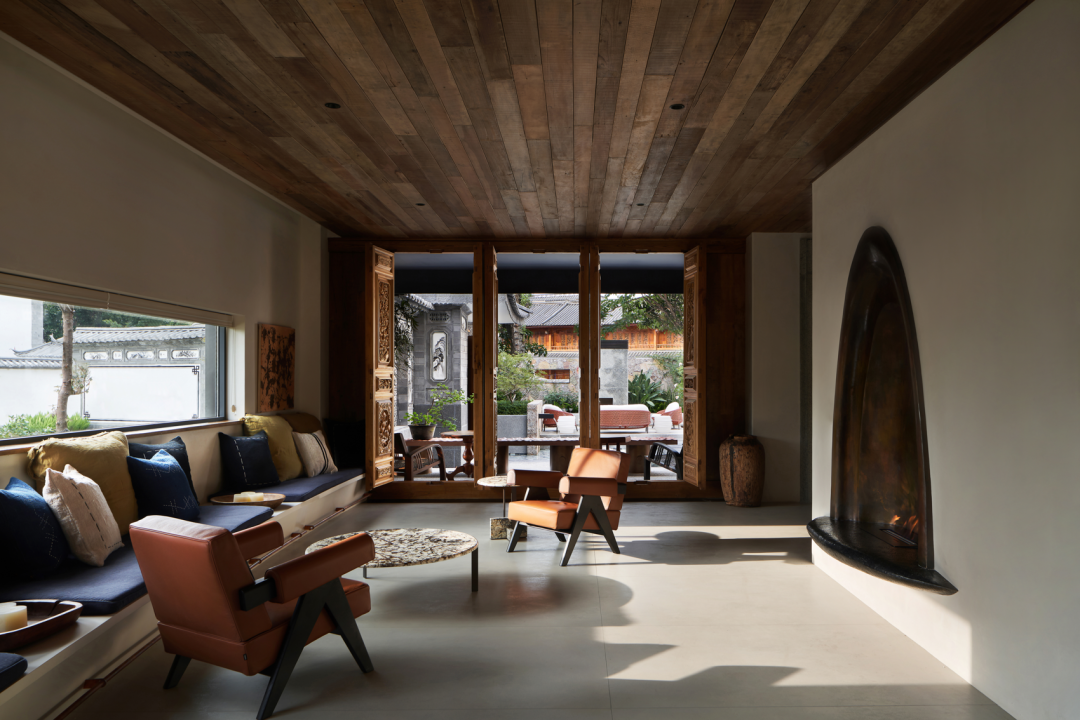

▲ 一楼客厅 The first floor living room
The horizontal line of the window provides the breadth as the horizon, which is part of nature. The extended arrangement of the seats borrows outdoor experience to bring everyone in each seat closer to nature.
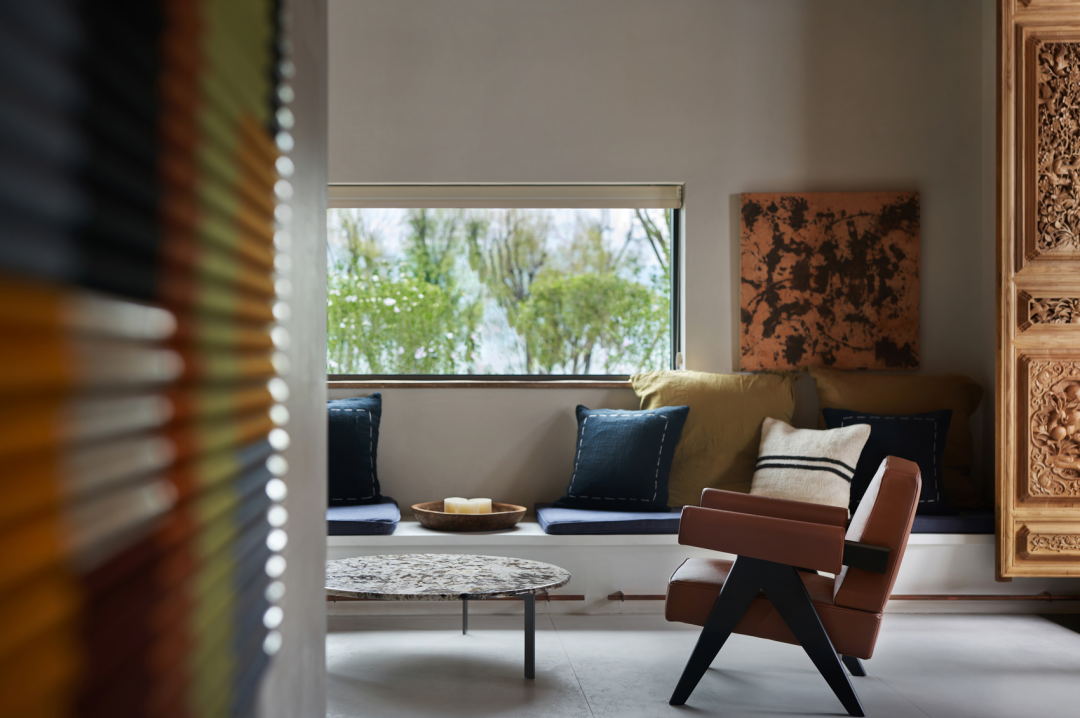

▲ 一楼客厅 The first floor living room
空间通透,与直觉相关联的物质提供着建筑空间的细部。
The bronze bow-shaped fireplace corresponds to the sunlight outside the window. The top surface is a waste old plank, and the bottom is a light beige rock slab. The white latex paint wall serves as a new middle layer, guiding the direction of movement, and creating a smooth and curved inward opening at the end of the wall.
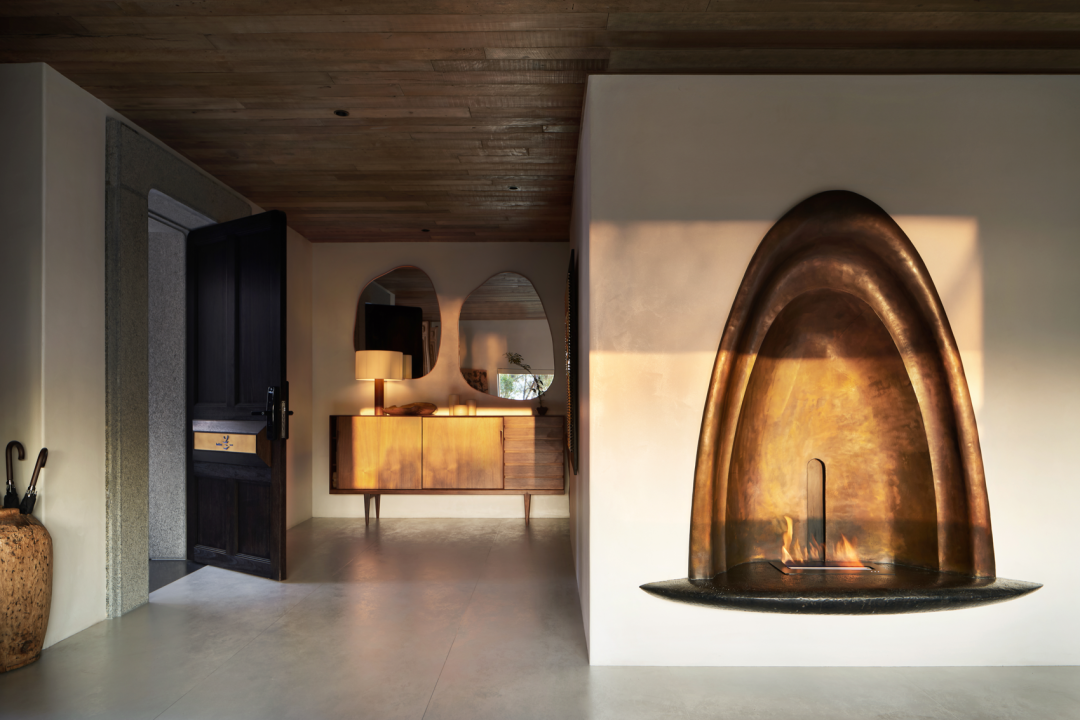
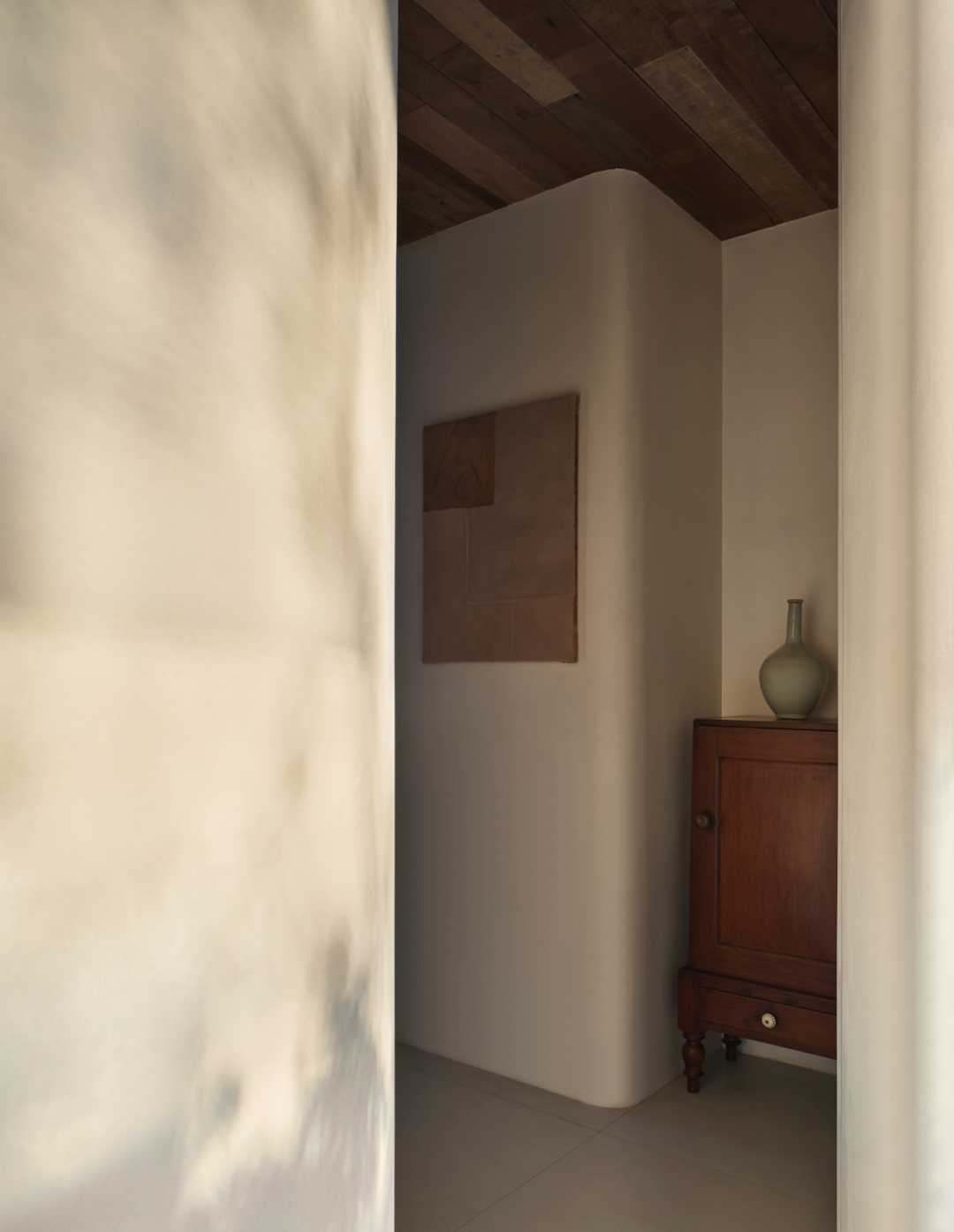
▲ 一楼客厅的光影与细节
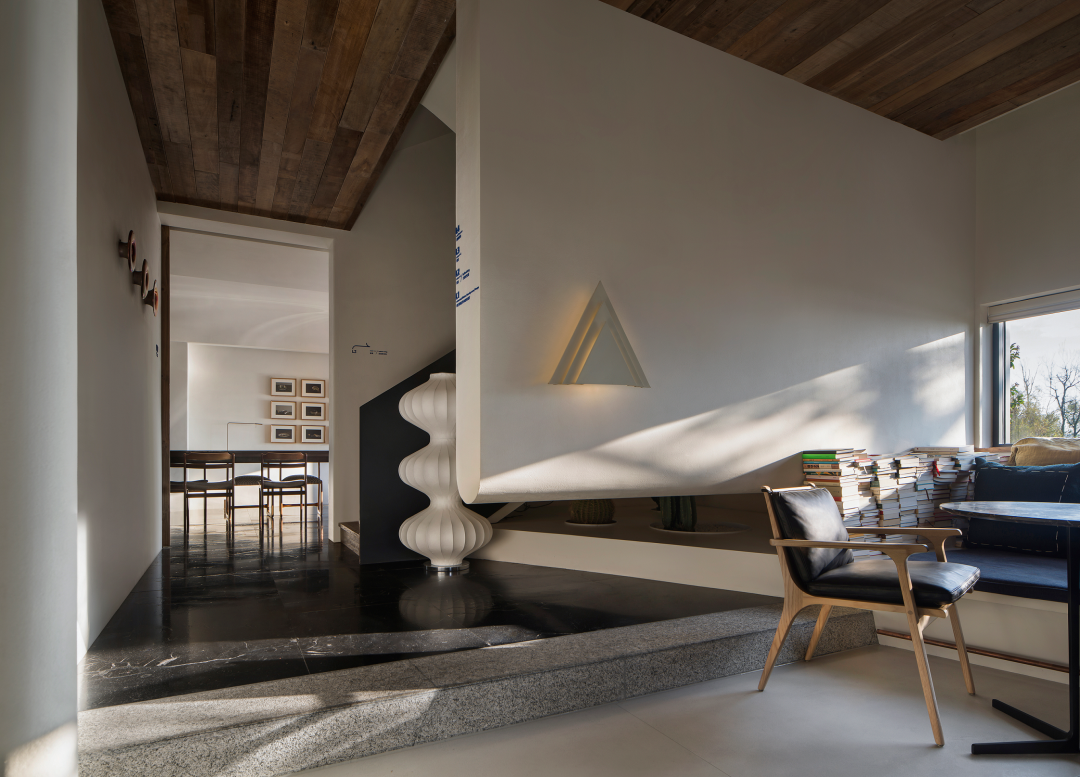
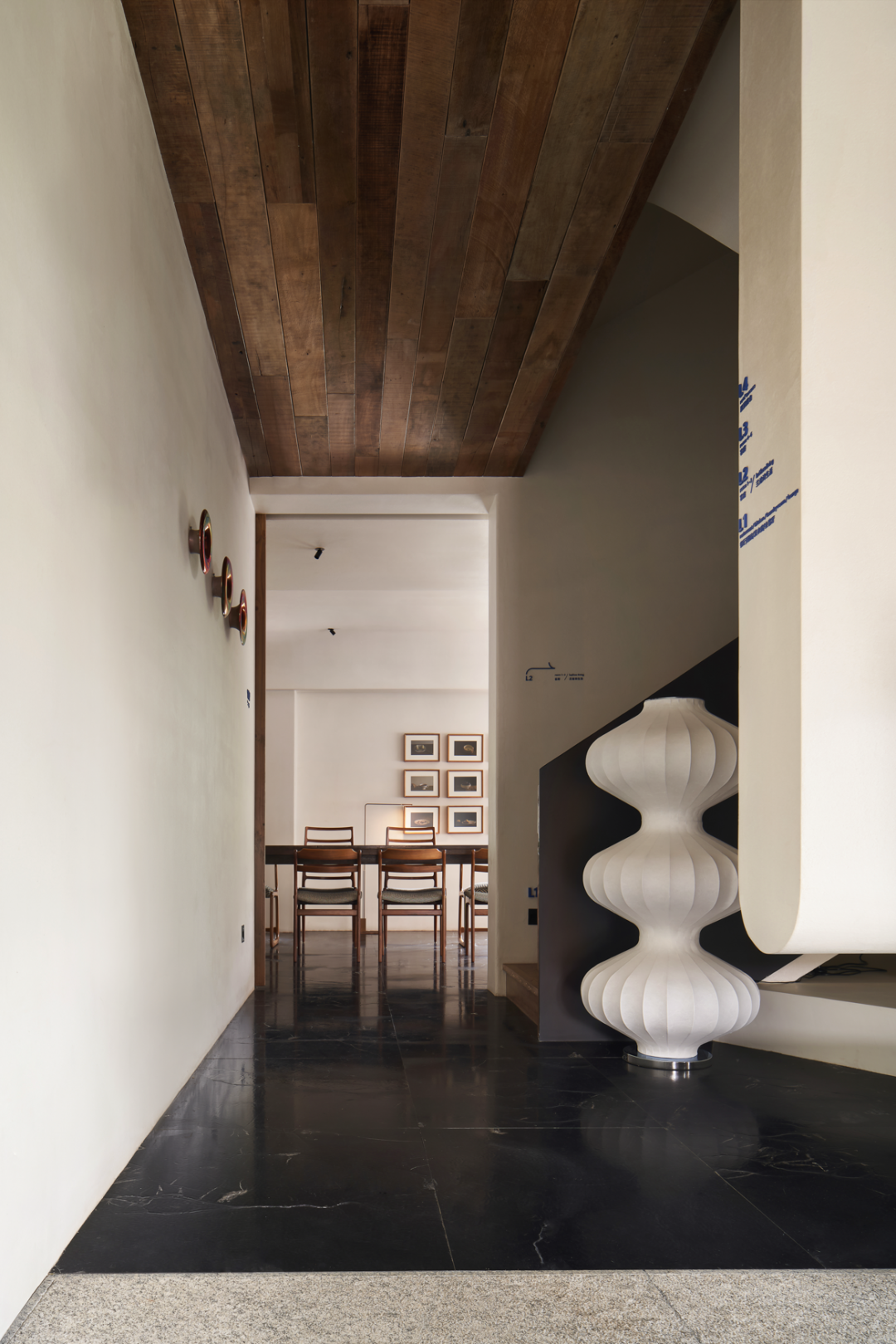

▲ 由一楼客厅通向餐厅
空间的转换,从地面开始。深邃的地面接纳着客厅动线的延续,并向内部收缩、汇聚,形成束口,最后转为两个窄仄的行为方向:一个沿着黑色的扶梯往上,一个继续向内部探索。
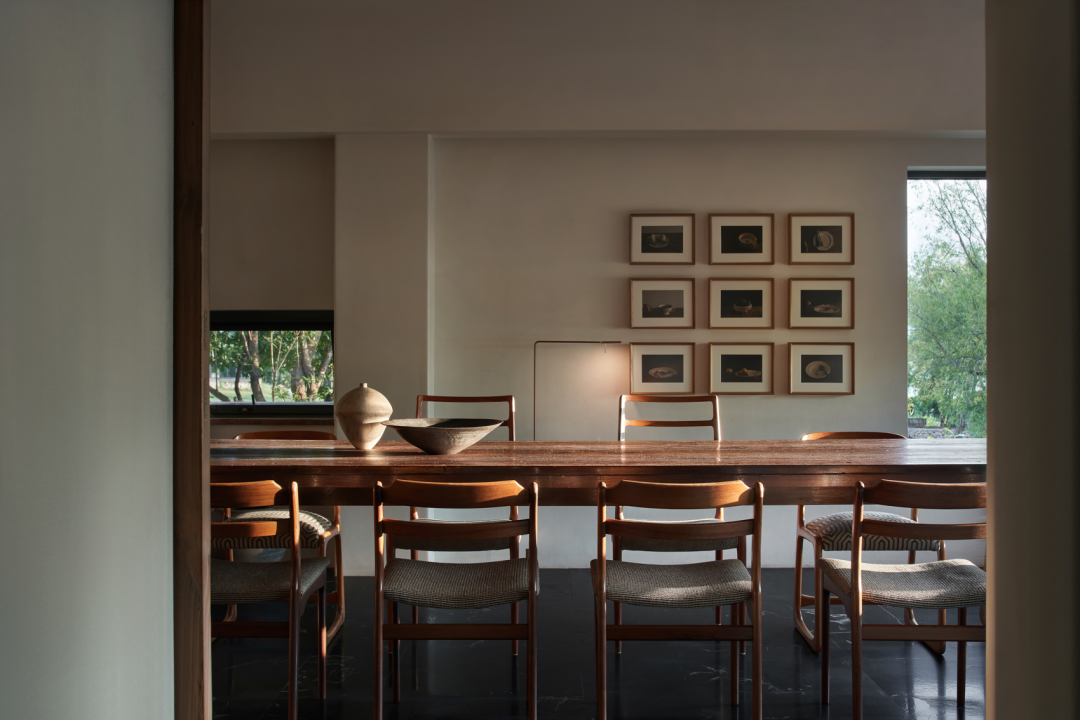
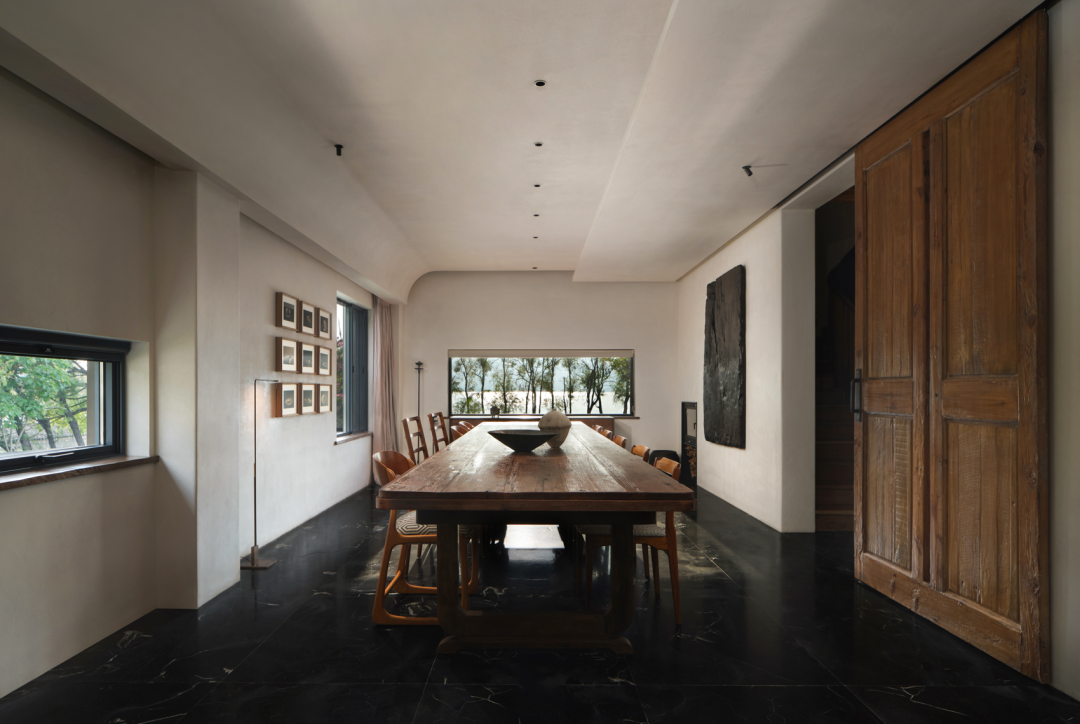
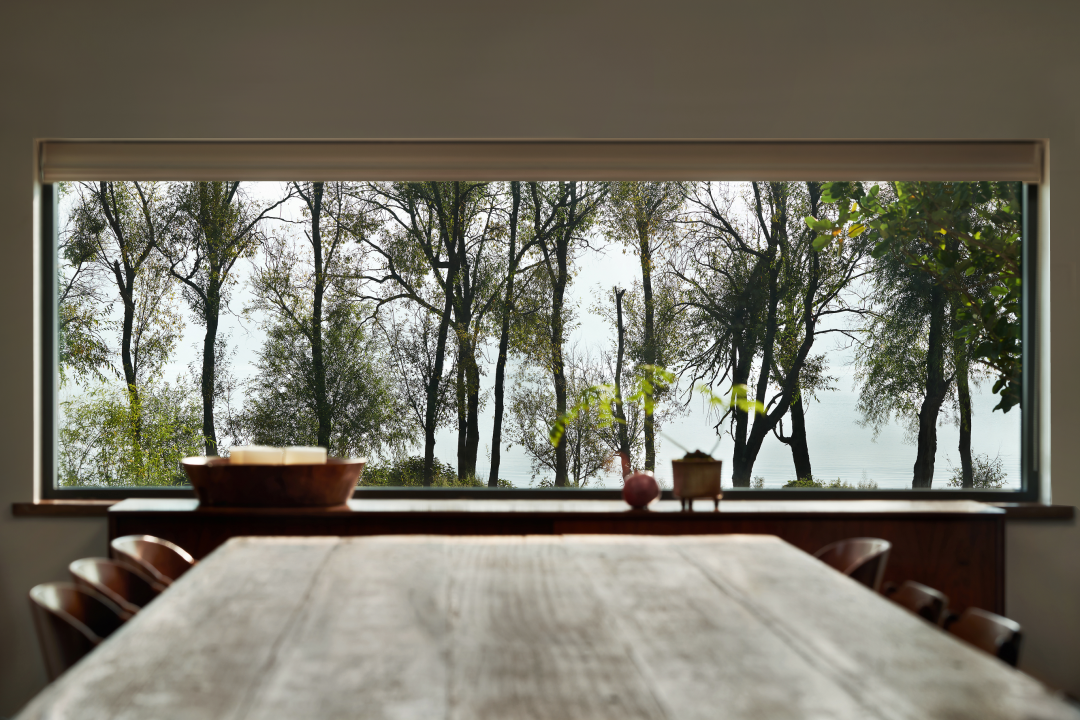
▲ 餐厅 The dining room
方形窗框依旧克制而准确,但窗框不再成为亲密接触的对象,而被一种带着距离的凝视所替代。凝视与距离塑造了这里的静谧。静谧在强烈的明暗中丰富着空间的形态,因此而广阔,而深邃。
The tranquility here seems to be to collect something, collect the sound of the sea tide hitting the shore, the sound of the hustle and bustle of the seaside market in the evening, collect the sky and clouds, rain and morning dew, and collect the motionless sound of Cangshan.
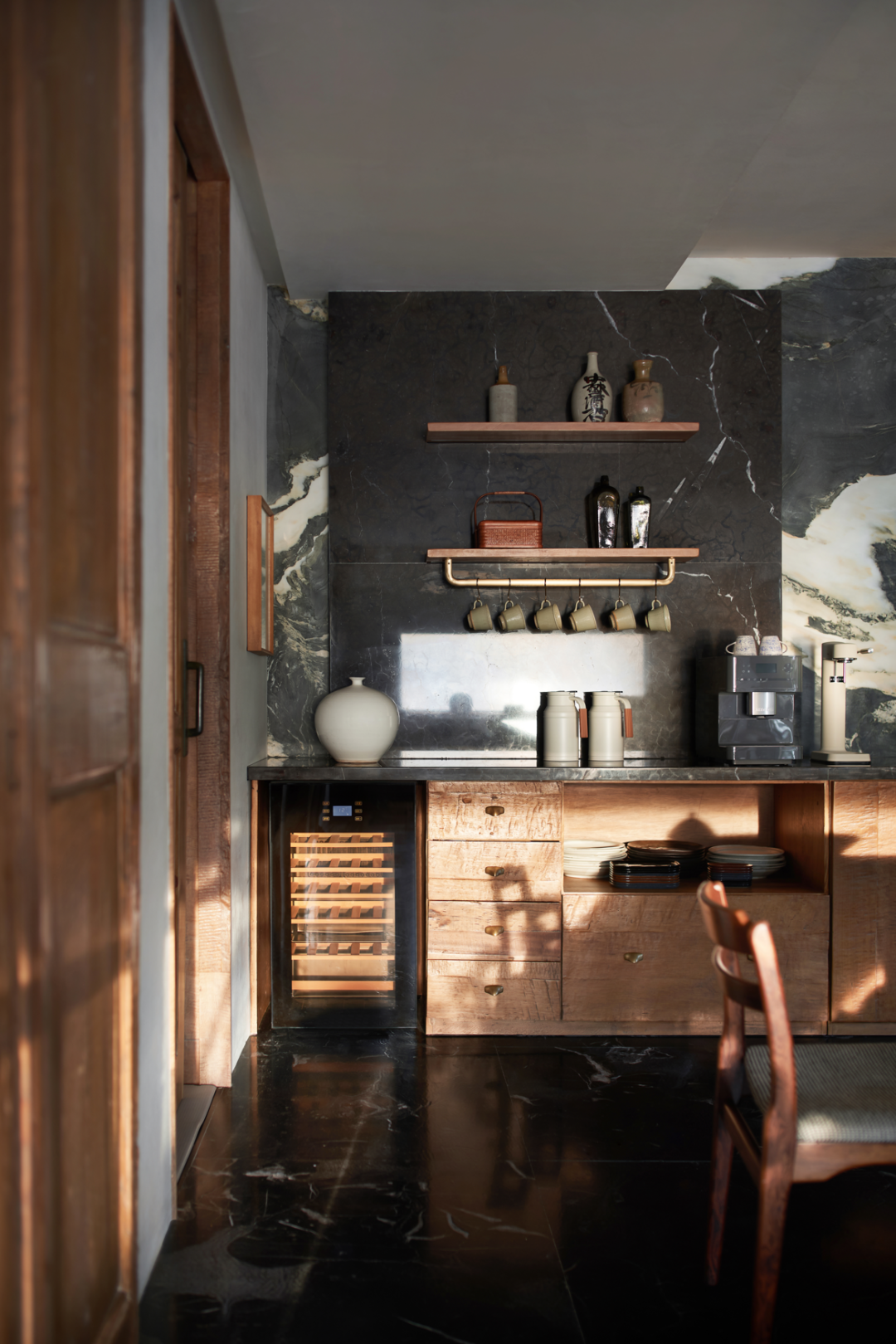

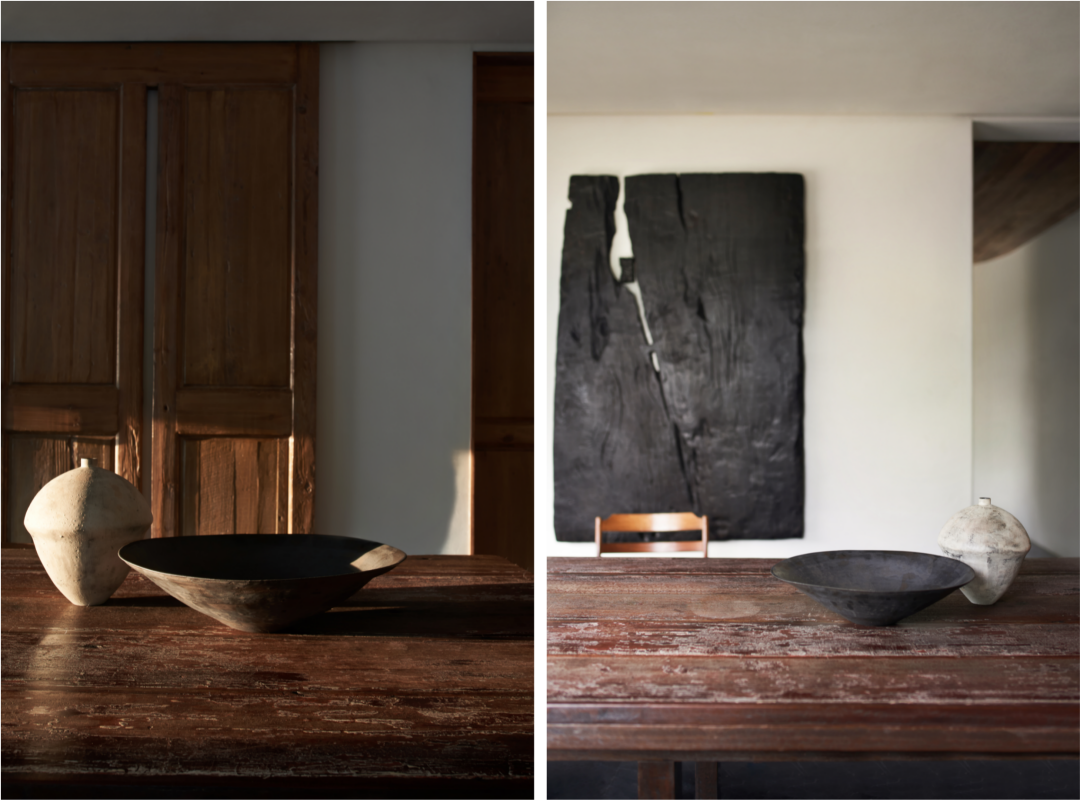
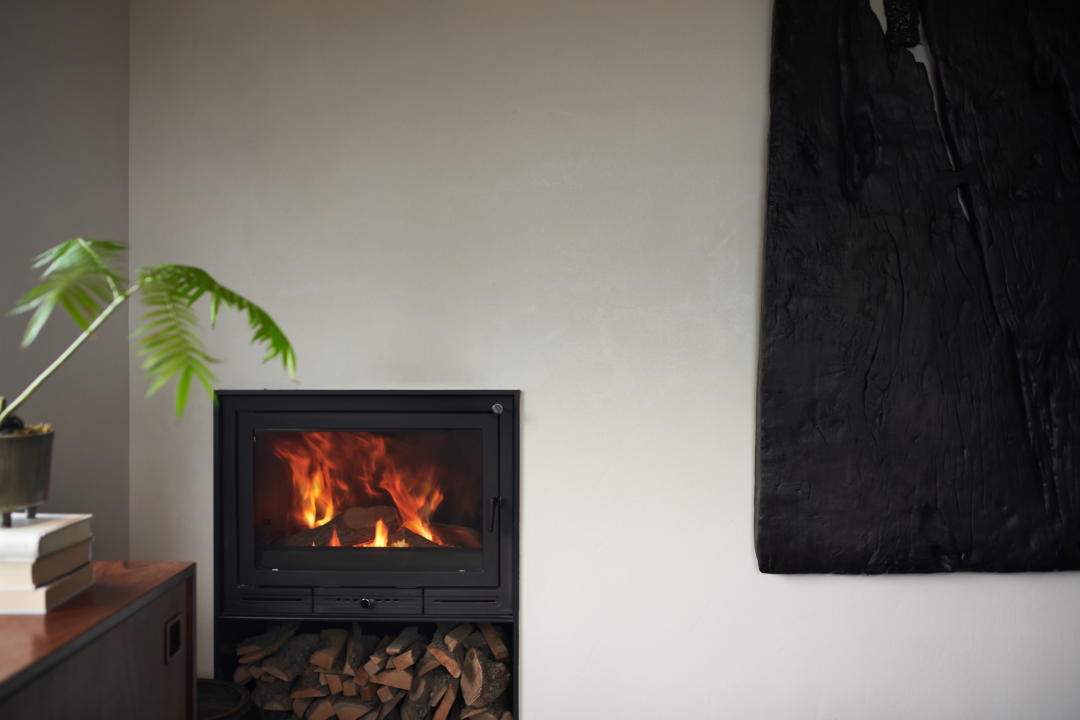
▲ 图为MOLONEY西班牙Hergom真火燃木壁炉
简洁的空间构成、当地的艺术品、朴厚的家具、日常的器皿,它们代替倾听与触摸,成为新的空间感官,在无新也无旧的平常生活里,一点一点回溯着,重建物与物、人与物之间亲密朴实的情感联系。
窗框/风景 Window frames and Landscape
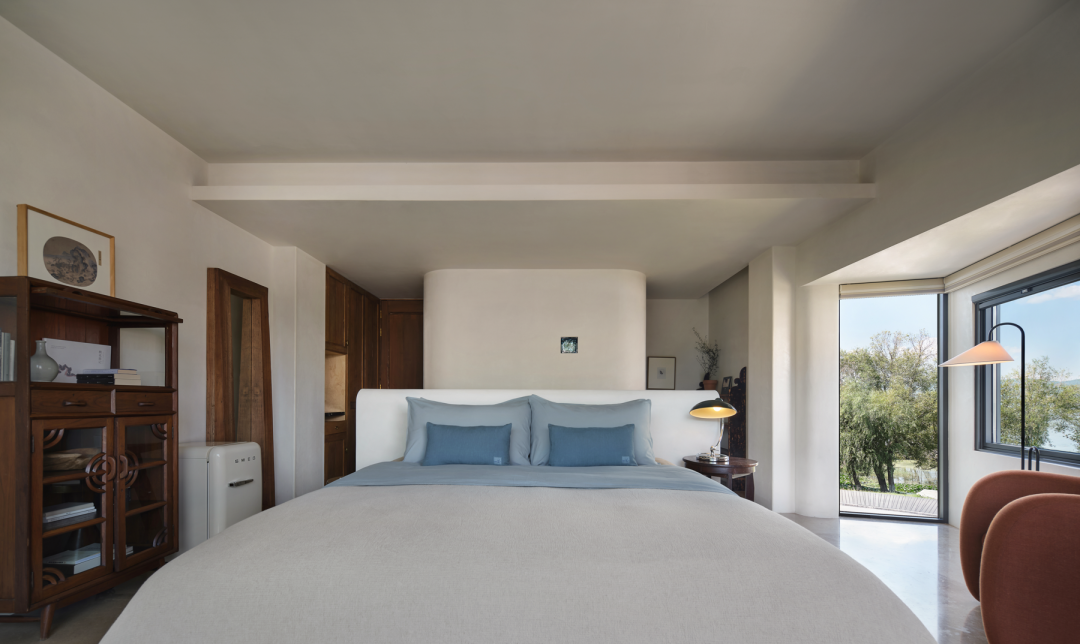

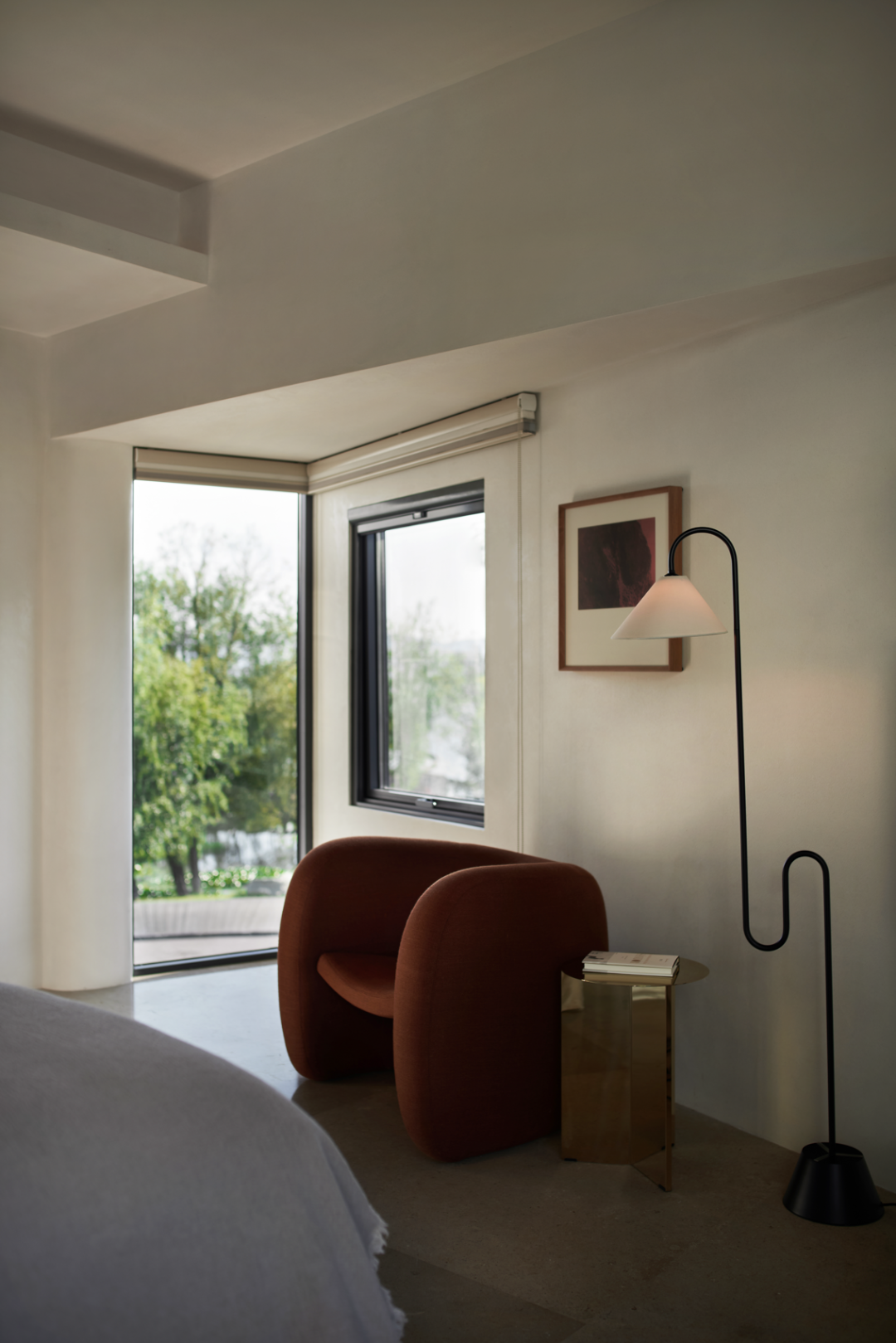

▲ No.1林岸房,位于二楼,有露台
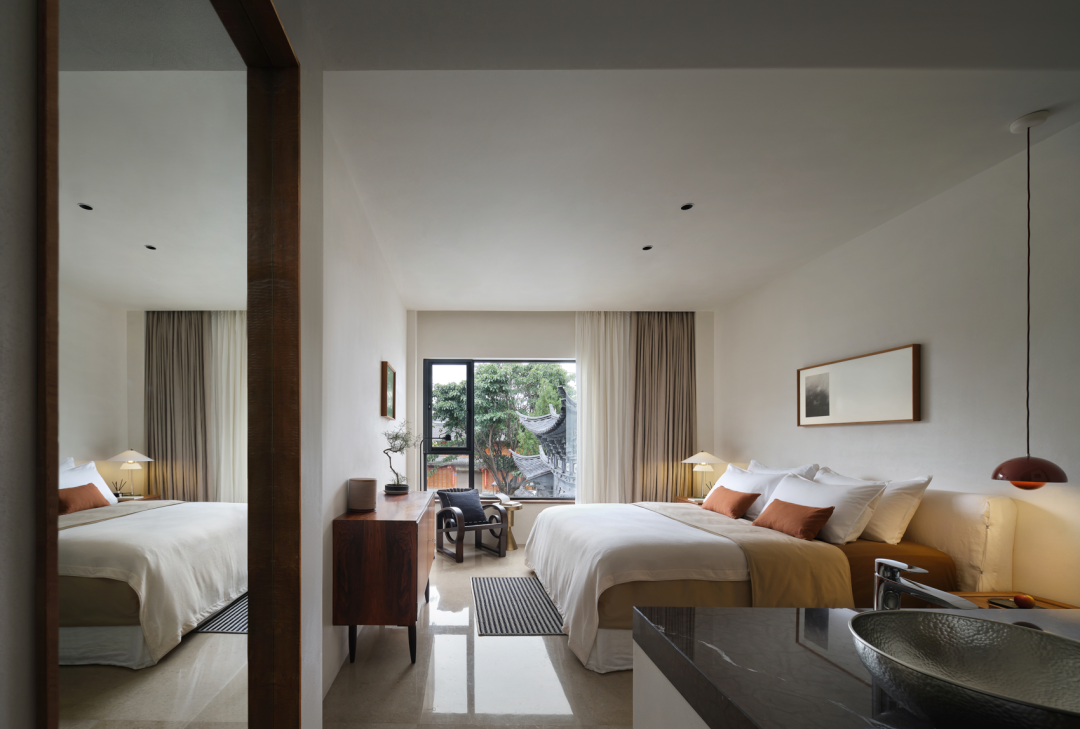


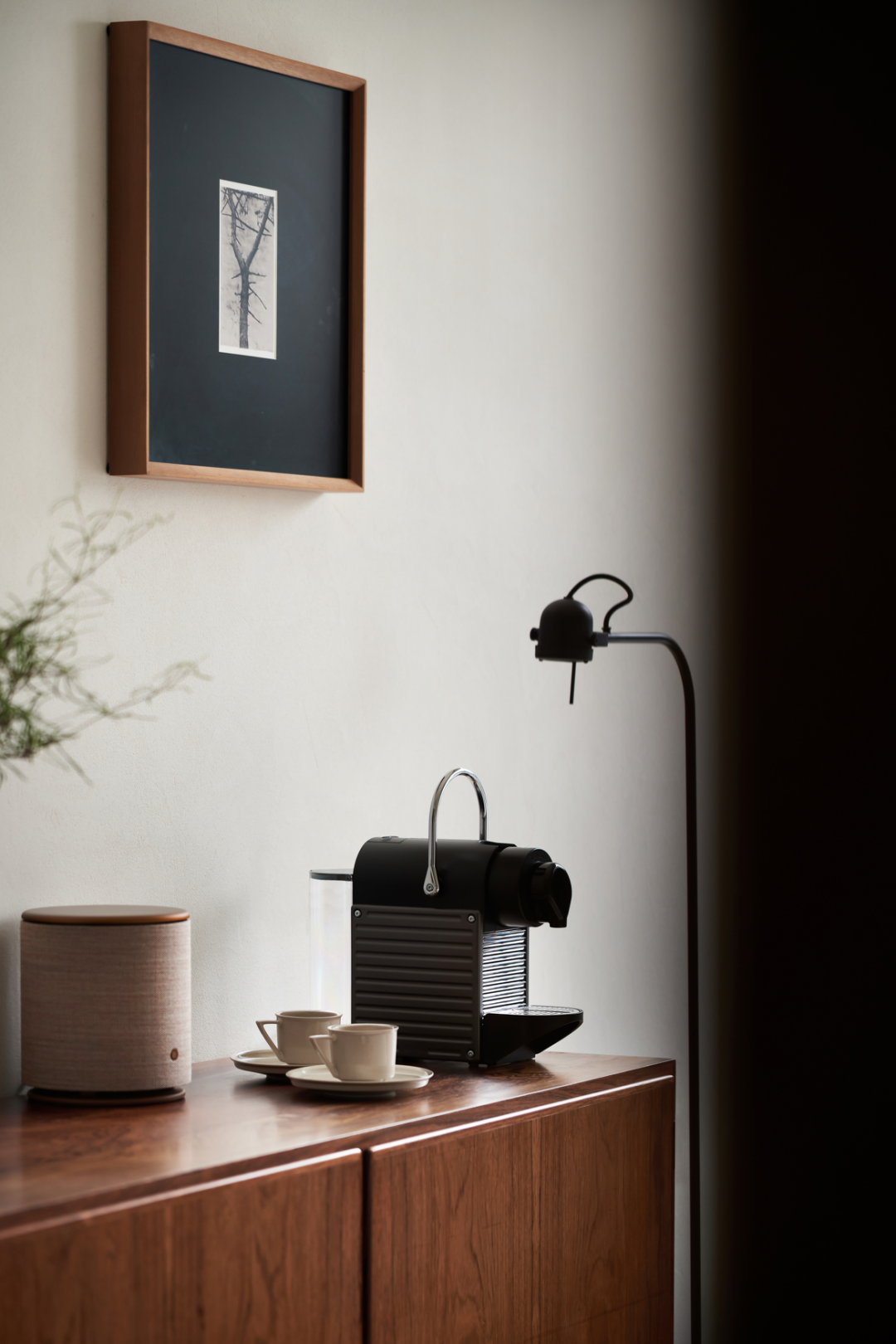
▲ No.2山庭房,位于二楼,朝向院景
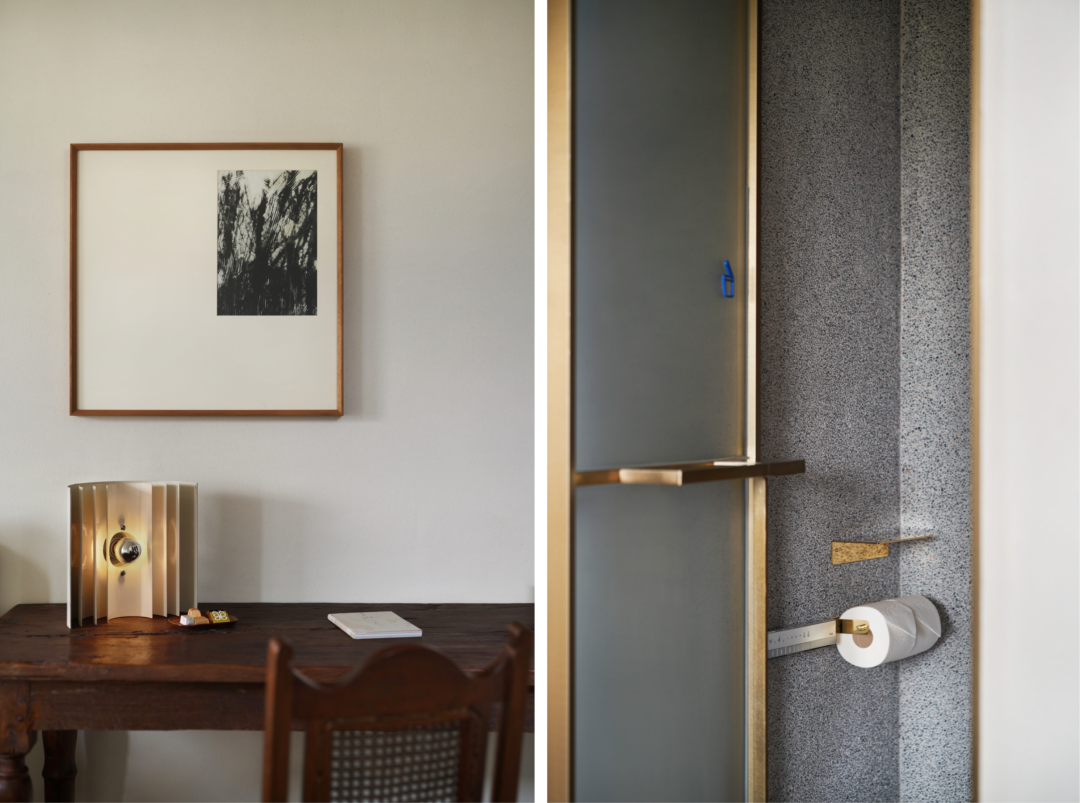
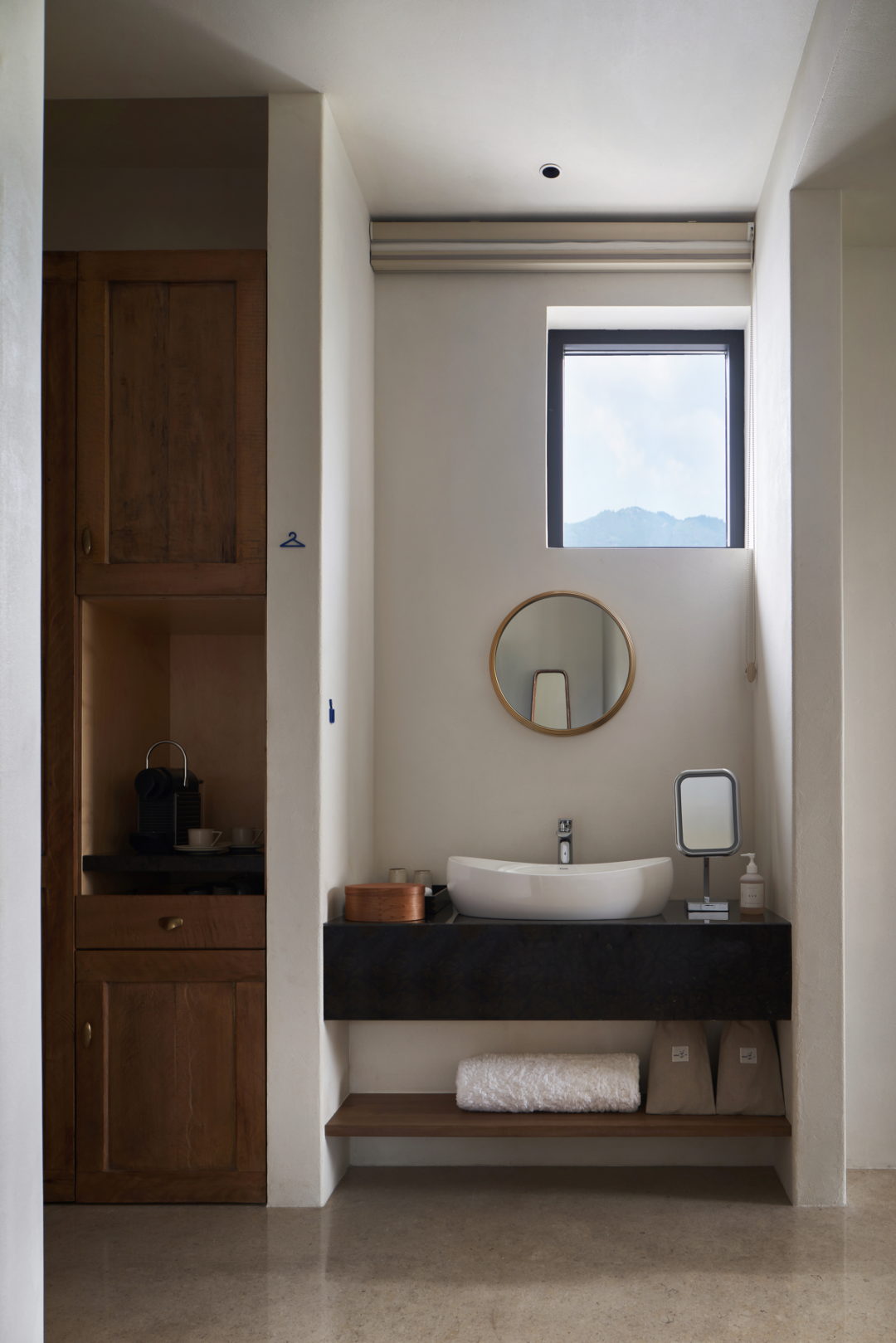
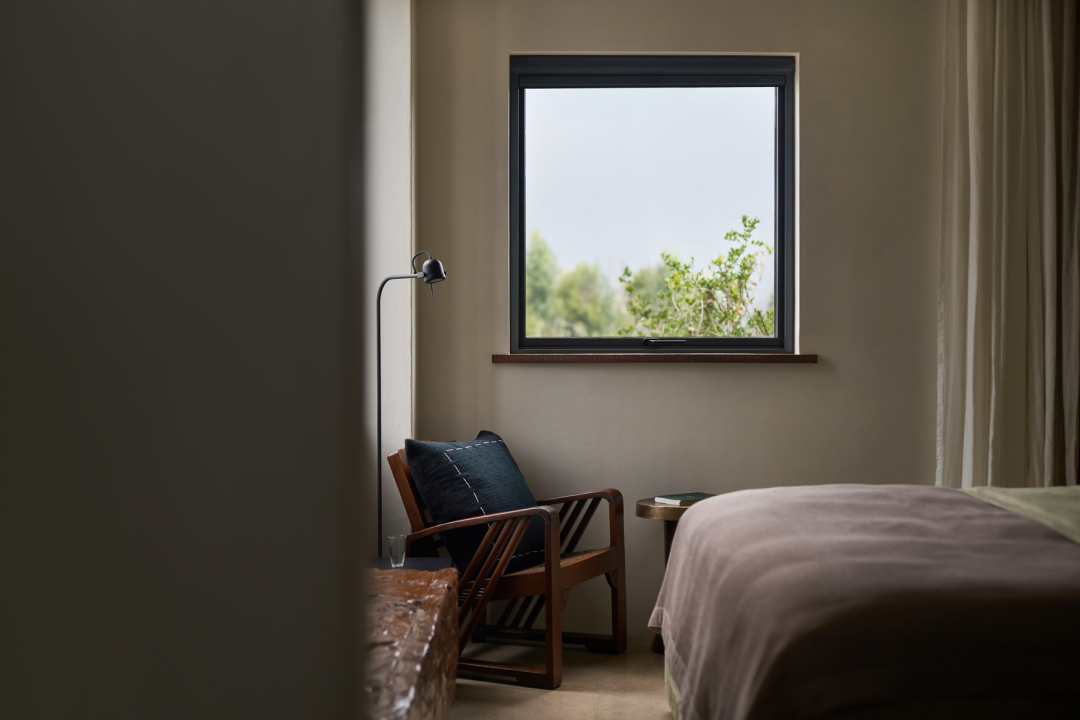
▲ No.3峰隐房,位于二楼,窗外是石榴树以及海景
This is a house open for the scenery outside the window. Different from windows in the traditional sense, here, all windows, whether they are horizontal, vertical or square, are established by the corresponding landscape.
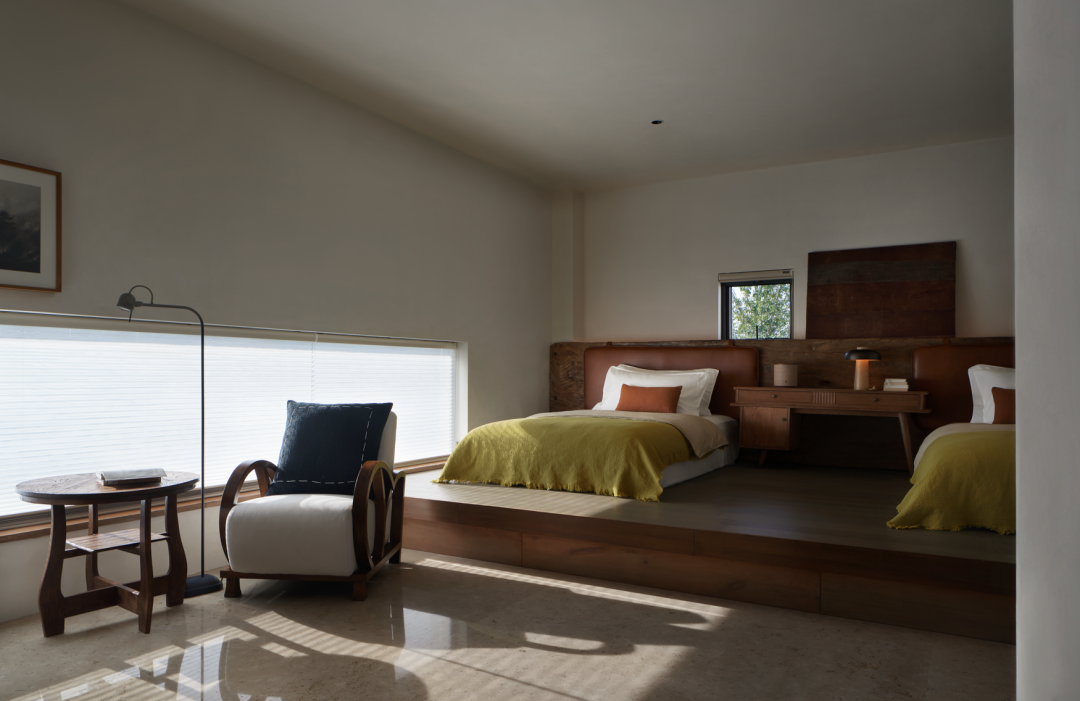

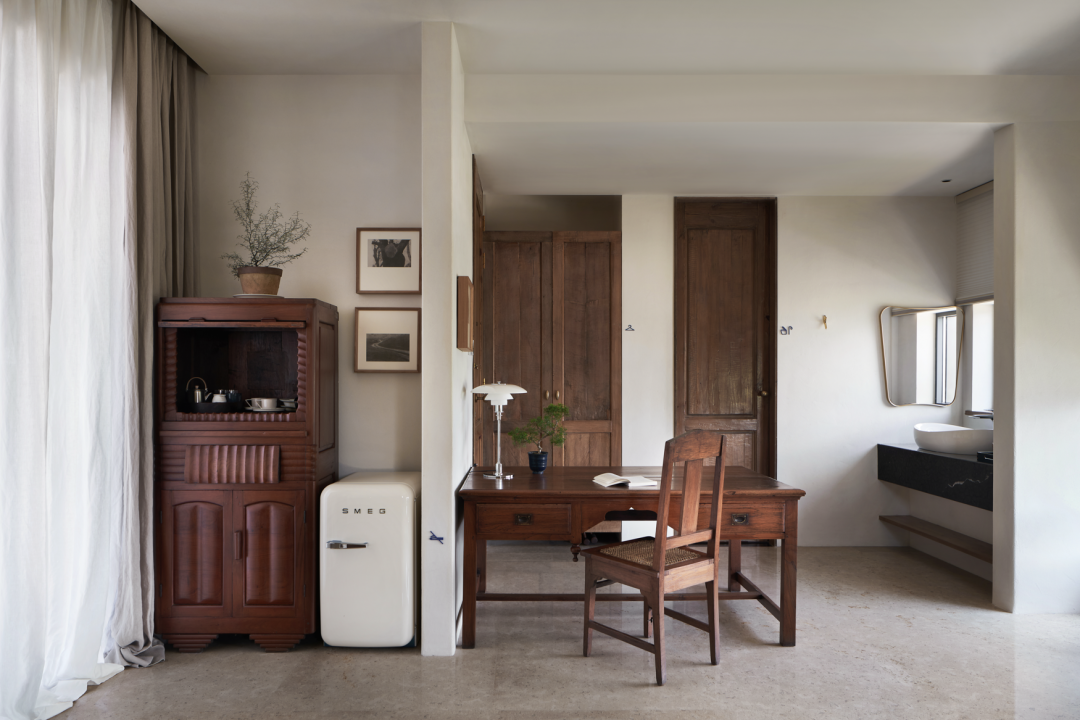
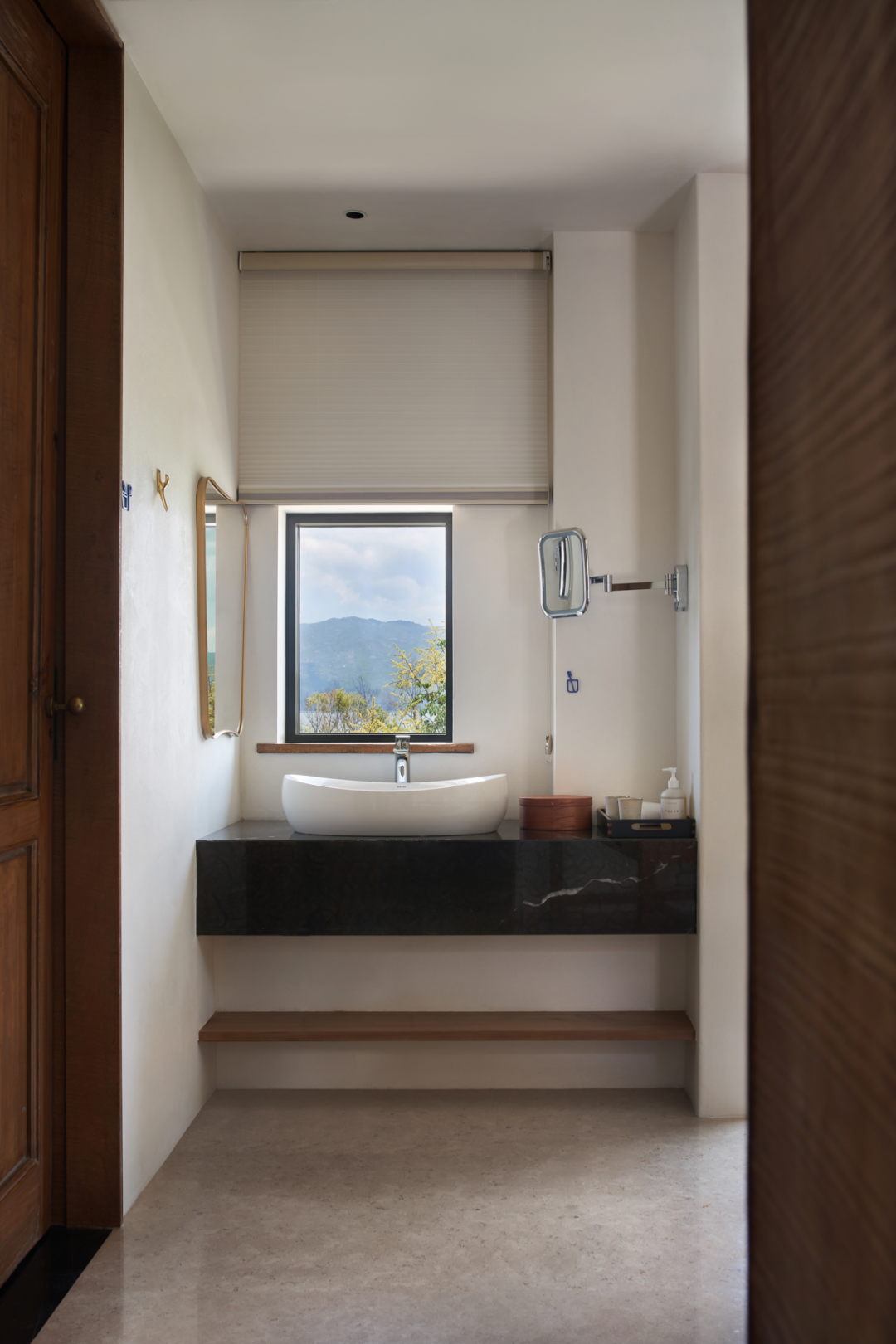
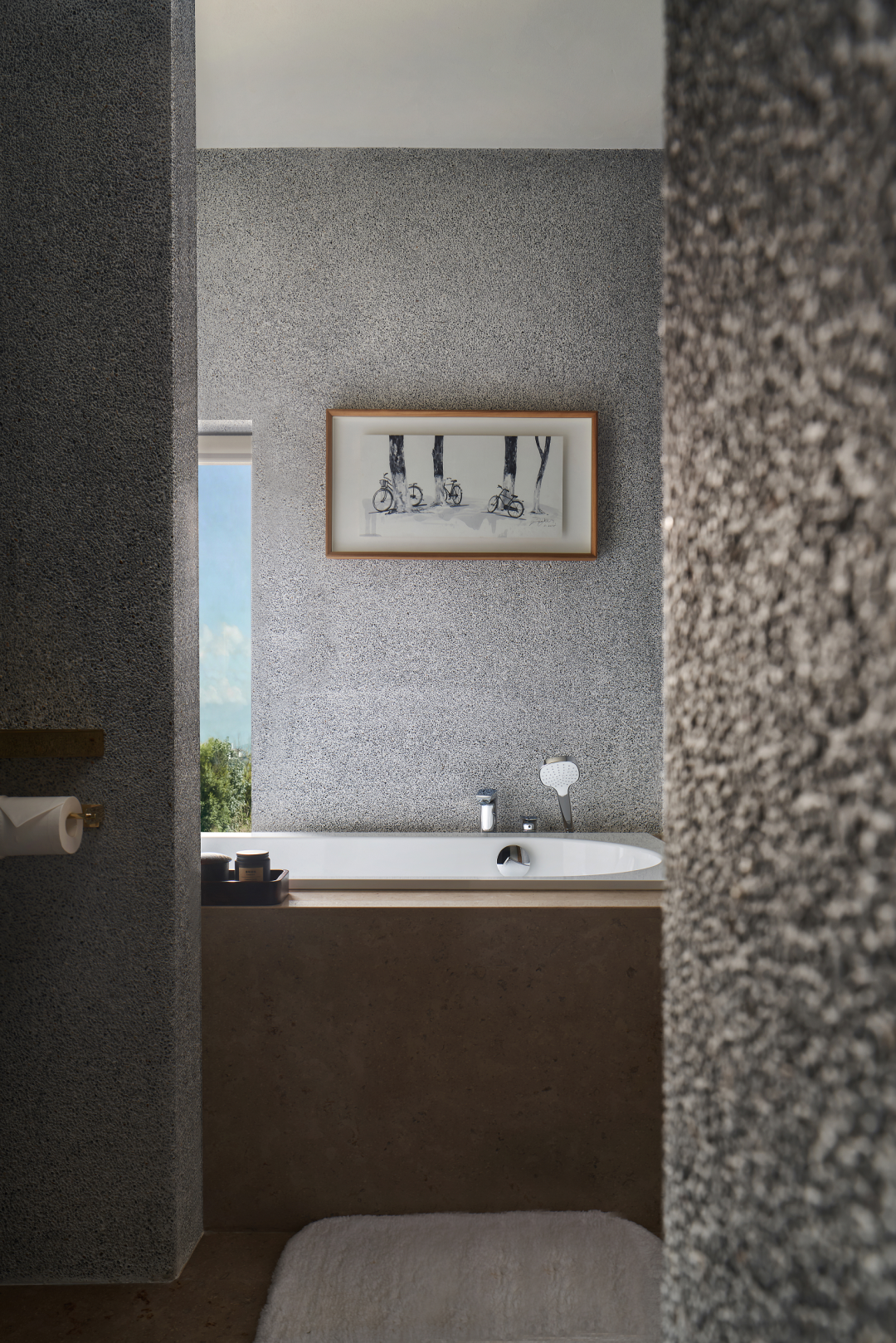
▲ No.4月柔房,位于三楼,榻榻米双床,可以躺着看日出
并不是每样东西都应该照得透亮,也并不是每个房间都应该全部打开。小小窗景,因克制而被雕琢,因此往往比全幅的落地大景来得更有凝视的欲望。
Frame-sized window frames are scattered in the room one by one. The square windows are the outlets for gaze, and the horizontal windows are the slow scrolls of mountains and rivers. Only when people build up their perceptions in external viewing and take care of themselves, the true experience of the individual can be obtained.
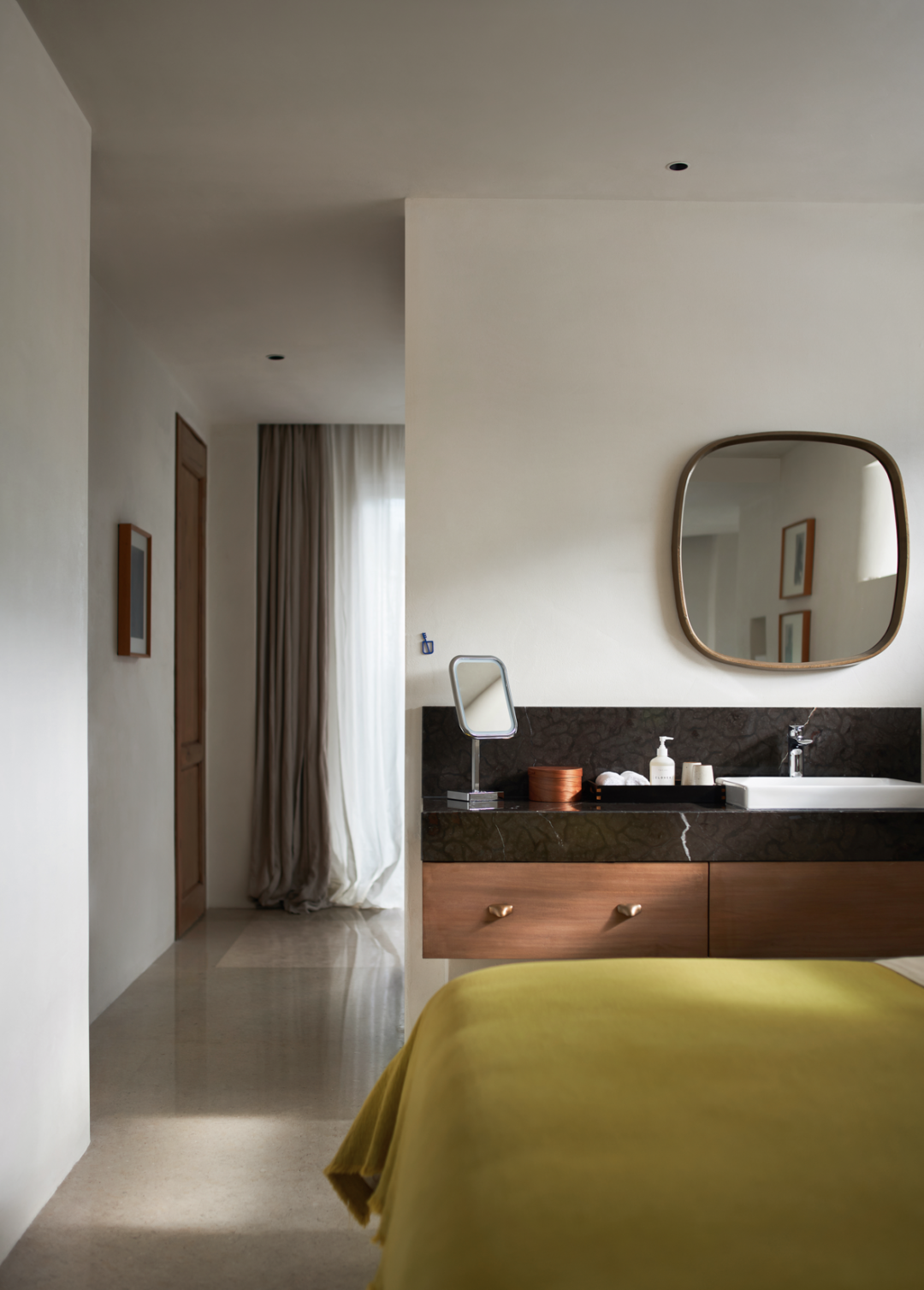
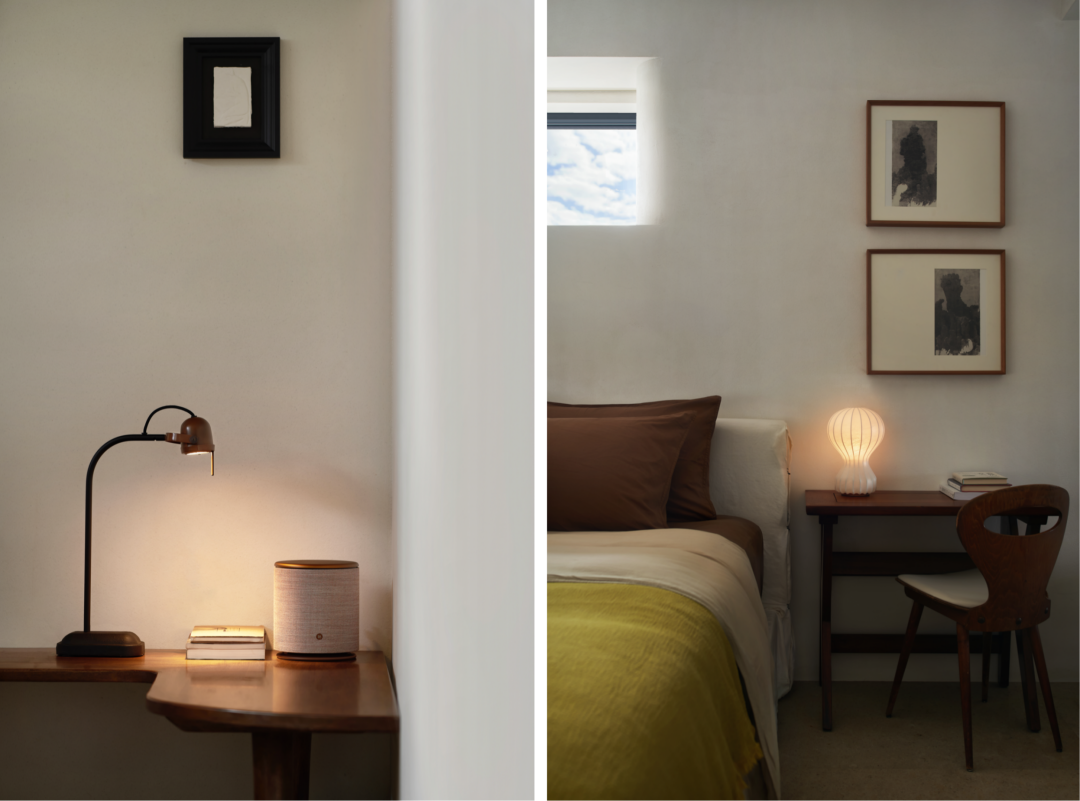
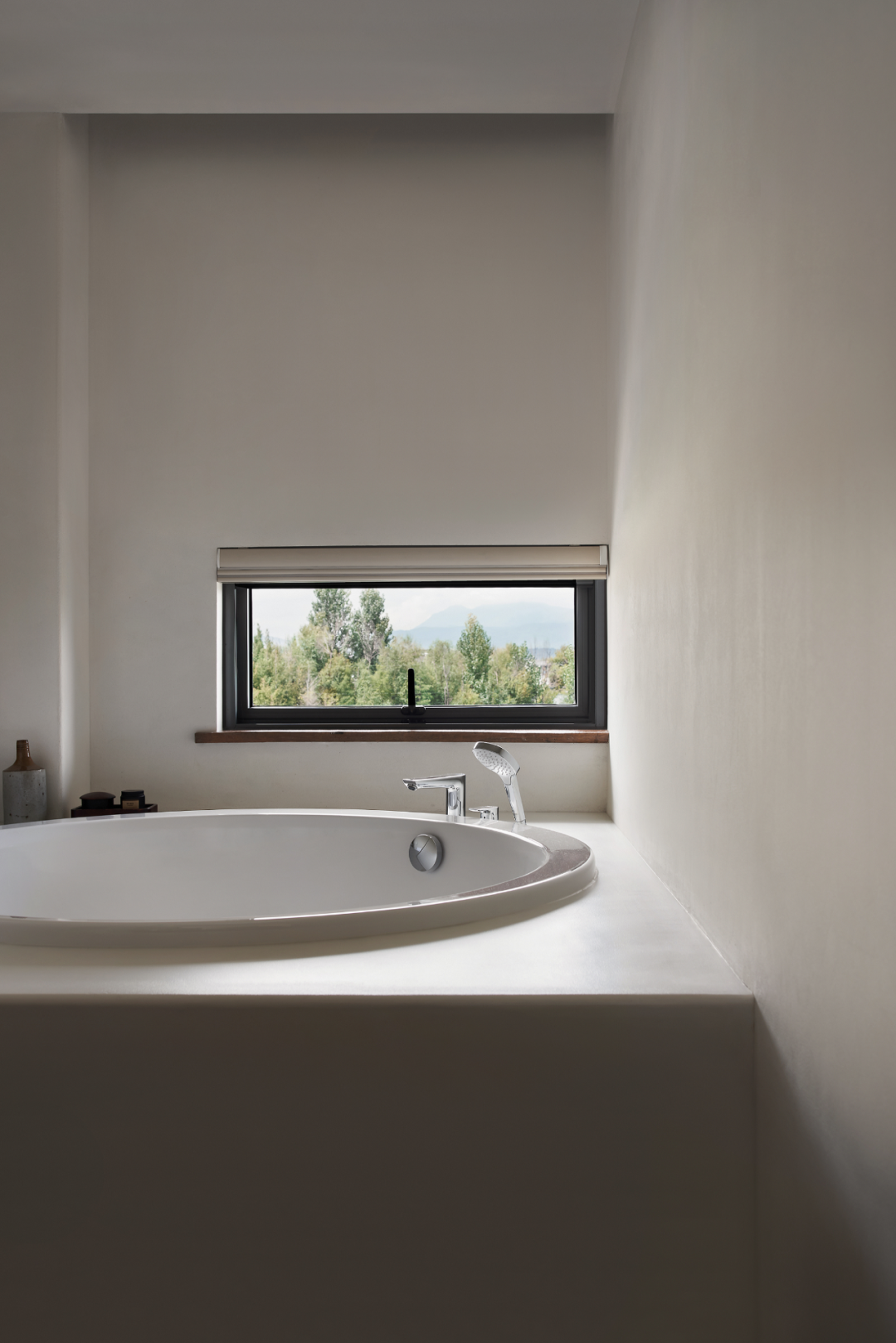
▲ No.5云舒房,位于三楼,带超大淋浴间以及观景浴缸
如同这所房子其他区域的窗框一样,它们作为一种空间叙事的元素,建构着克制内敛的内外关系,制造空间阻隔,但同时提供着对周围风景最为主观视角的描述,并反过来为内部空间的感受与氛围,营造着向内心探索的感知欲望。
Here, the scenery is the object that travellers appreciate, but it is also the most effective reference for the self deep in the heart.




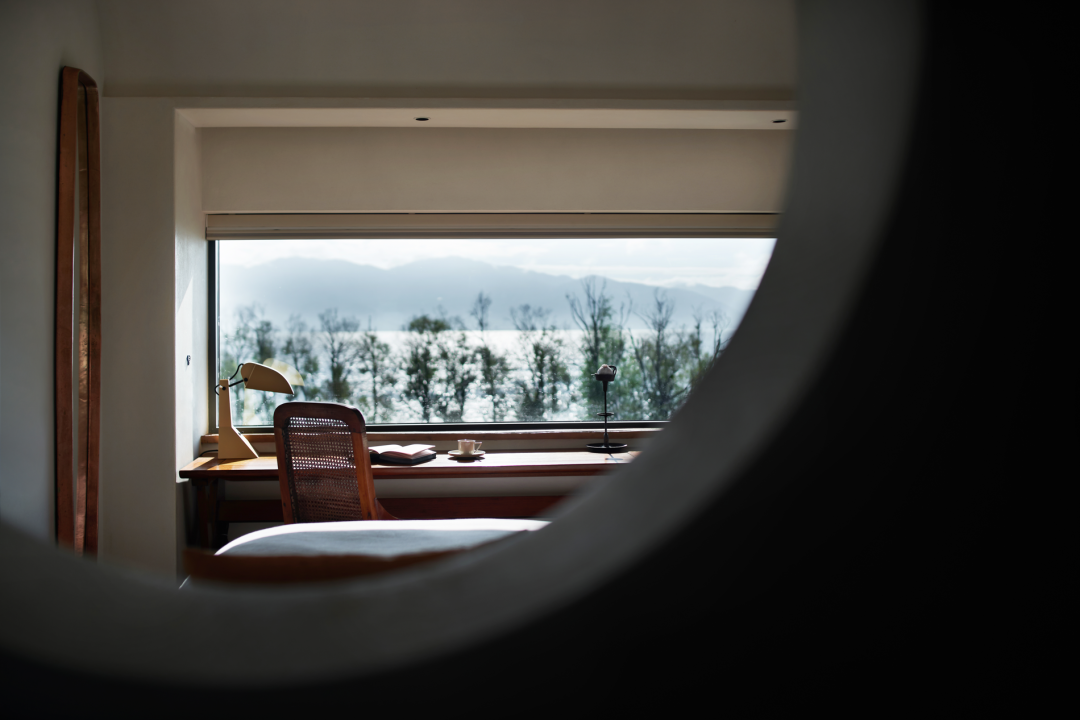
▲ No.6海漫房,位于三楼,开阔的海景视野
六个不同的空间,在格局、尺度与形式的差异之间,营造出不同的场所气质。与自然相对应的材质、被窗框的边缘所切割的光线、室内与室外安静生长的植物以及房间内散发的香氛,引导人向空间深层探索。
As a result, the visual-dominated relationship is replaced by compound perception.
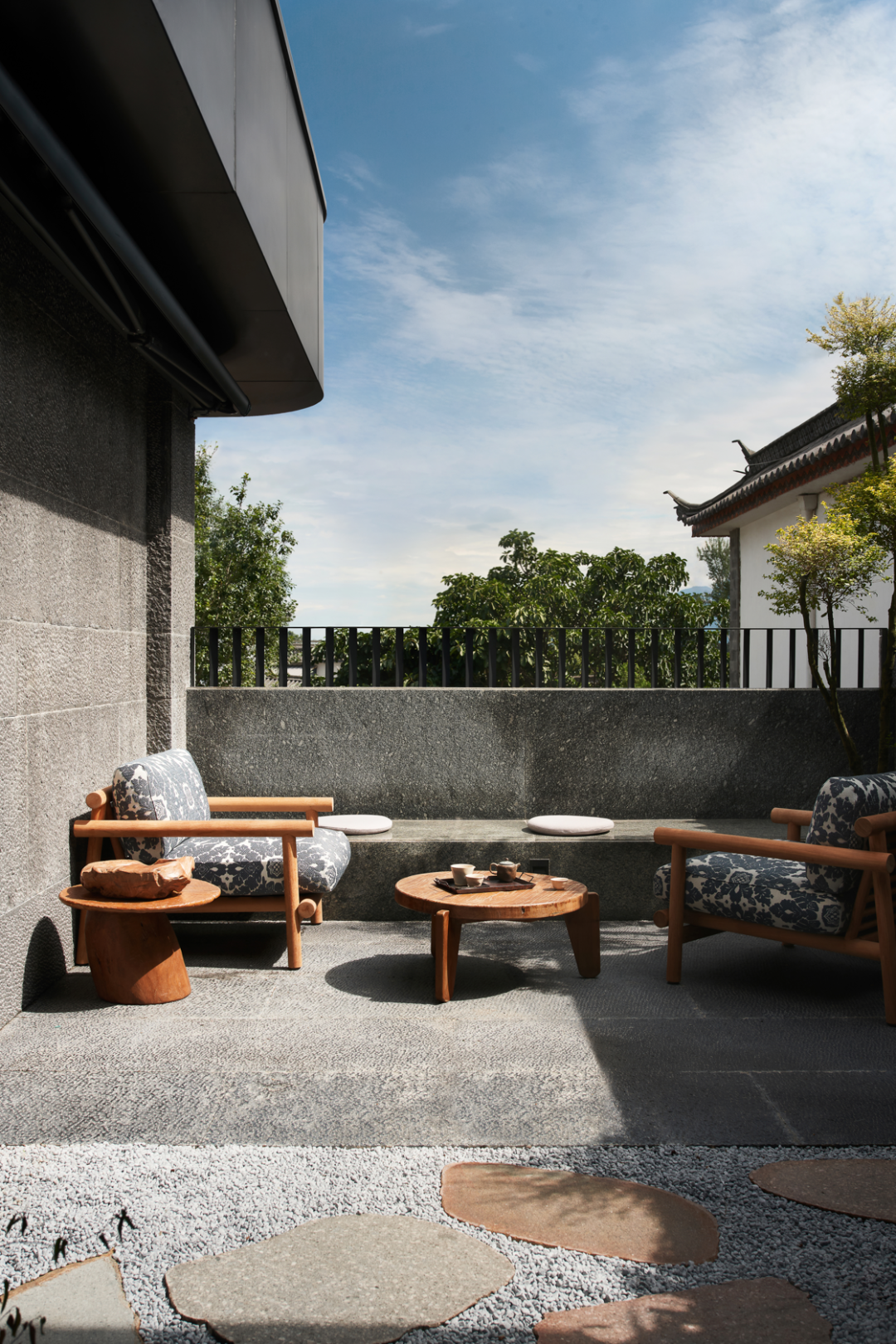
▲ No.4月柔房和No.5云舒房之间的露台,可以打通,并成为大家庭式套房
迂回/叙事 Roundabout and Narrative
尽管以上种种叙说,但这绝不是一处静止的下榻地,也不是一座冰冷的观景台。懂得其最核心的落脚点,便能明白这其中的迂回的意义。
As a native of the Bai nationality in Dali, the hostess can be understood as being close to hometown, but more directly, it is more likely to come from her love for the landscape. The hostess shared her love in the crevices of the space, and also in the field of fashion design, using her best language to convey it in a more intense way.
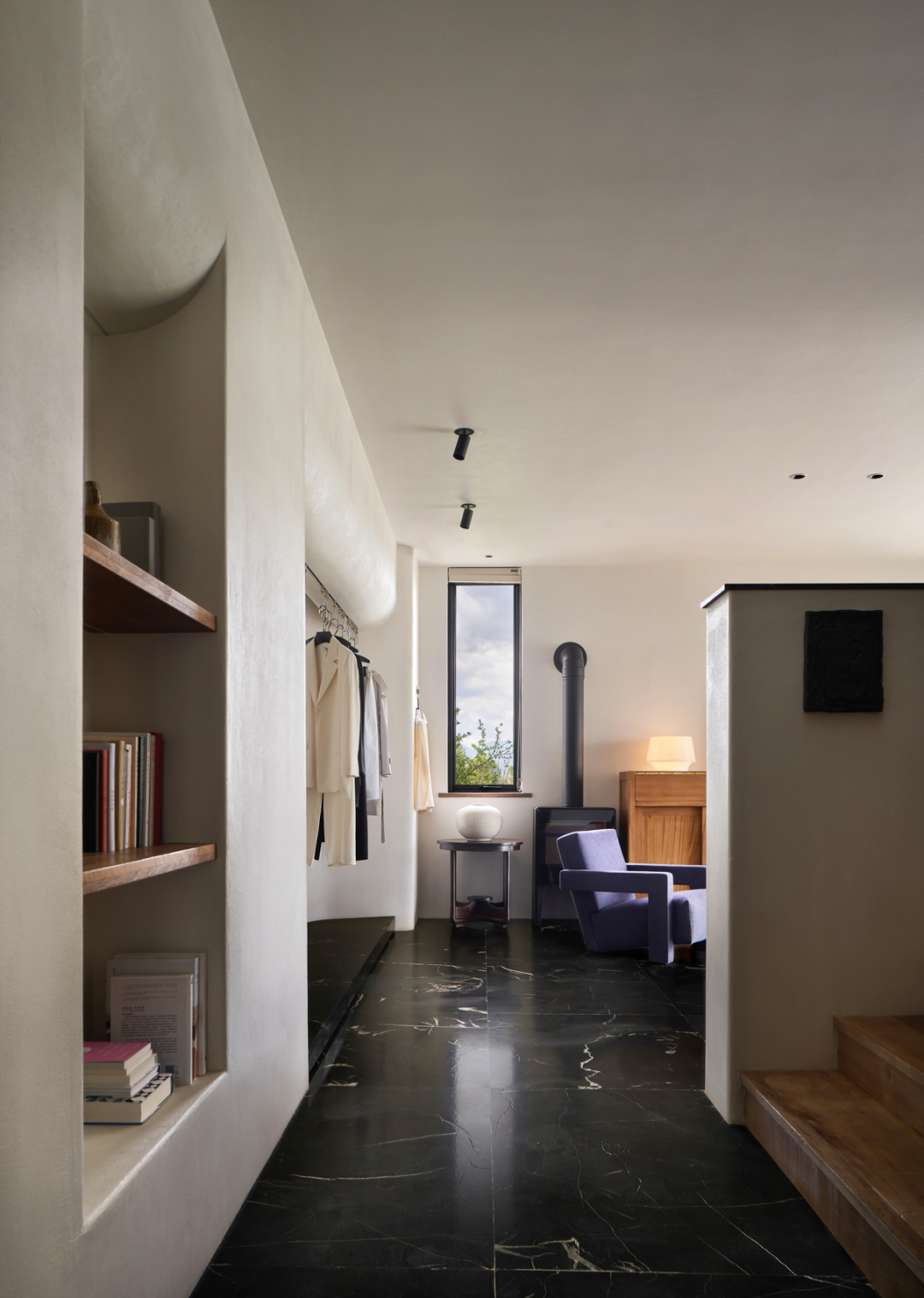
▲ 图为MOLONEY西班牙Hergom独立式燃木壁炉
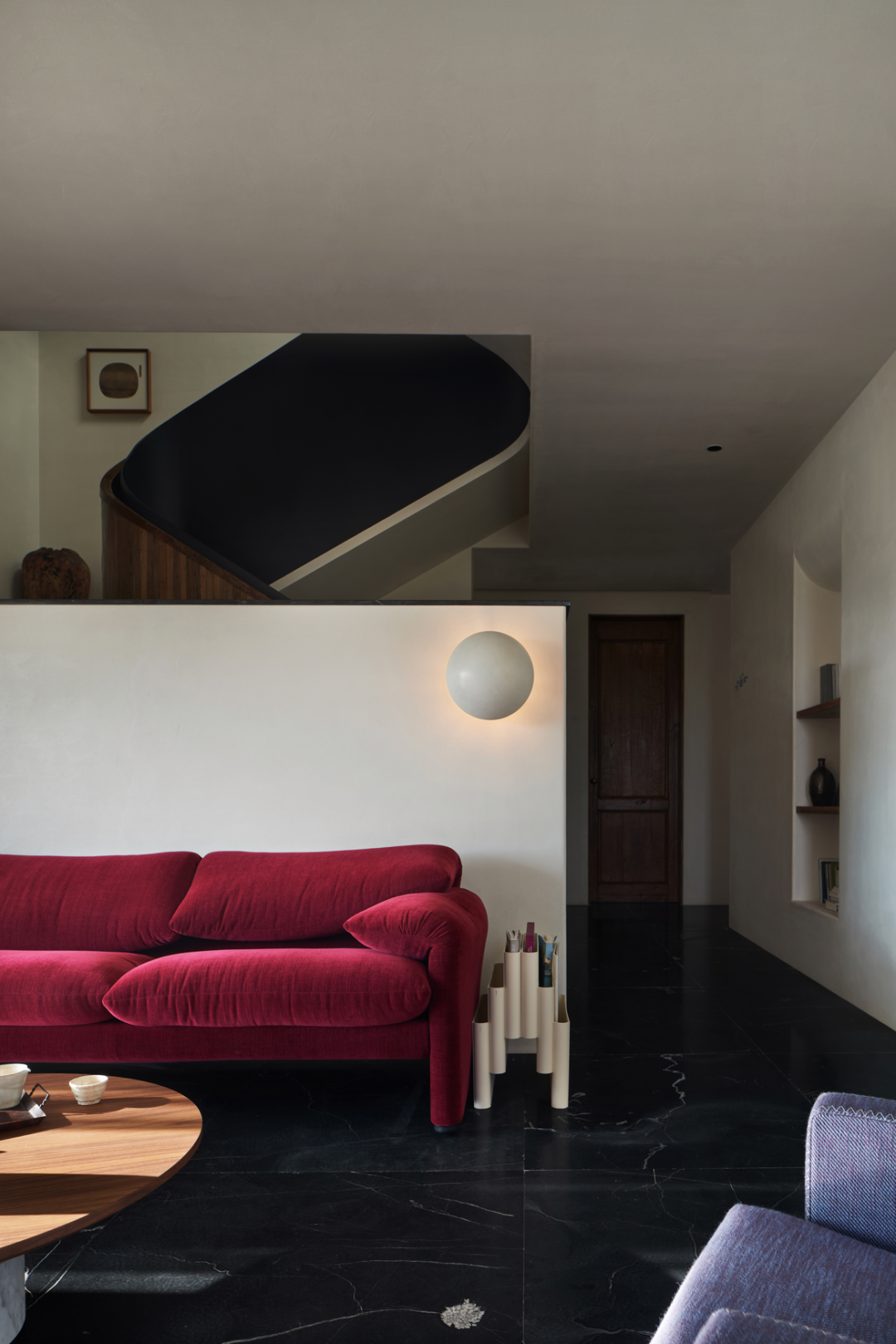
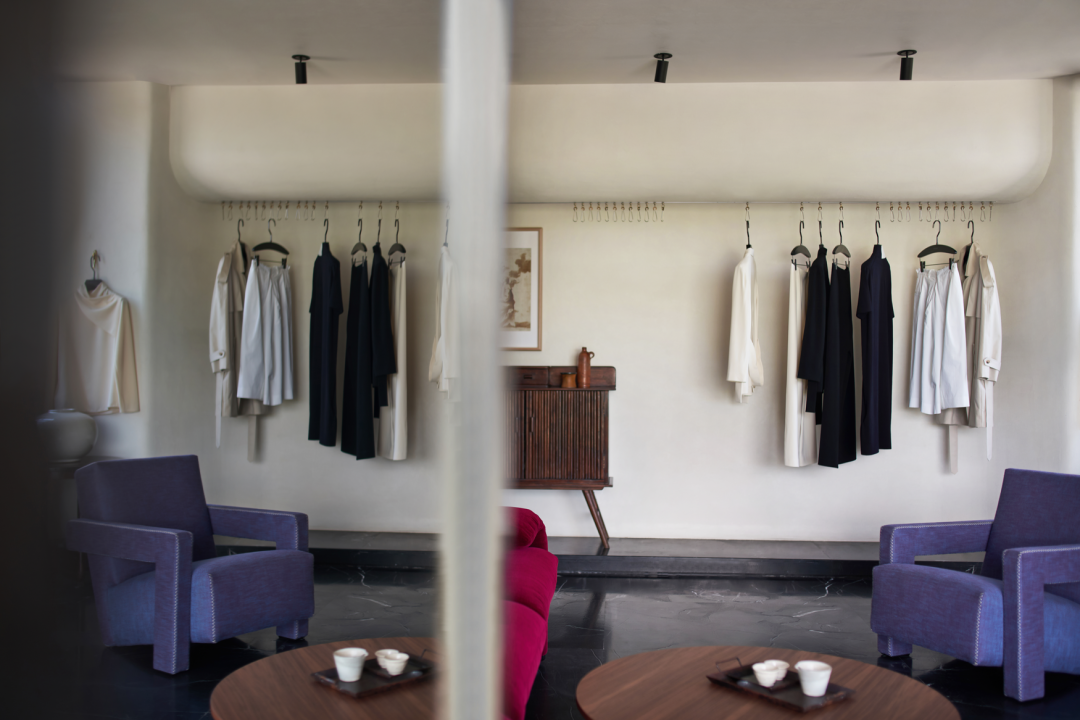
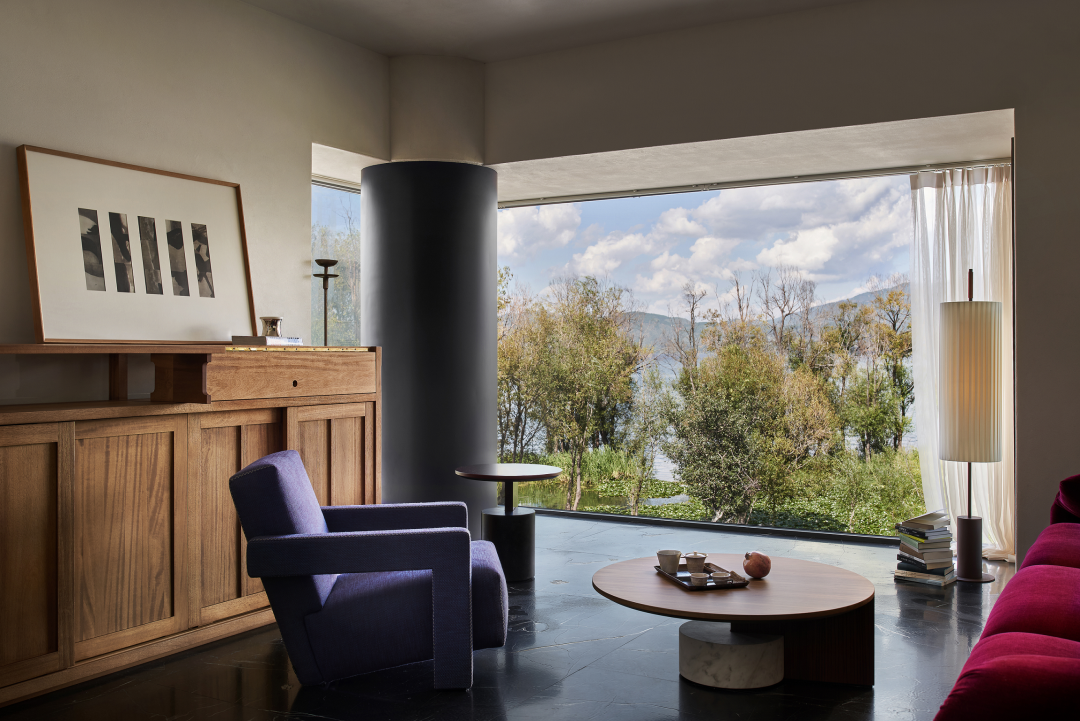 ▲ ladésee时装展区兼会客厅,位于二楼
▲ ladésee时装展区兼会客厅,位于二楼
But for those who are tempted by the small windows inside the room, it is difficult not to climb the stairs up the escalator, climb the roof, and get a glimpse of the entire landscape of the land. This is a kind of impulse encouraged by the original power, and the escalator tempts in the vertical direction, and leads the explorers who are eager to try.

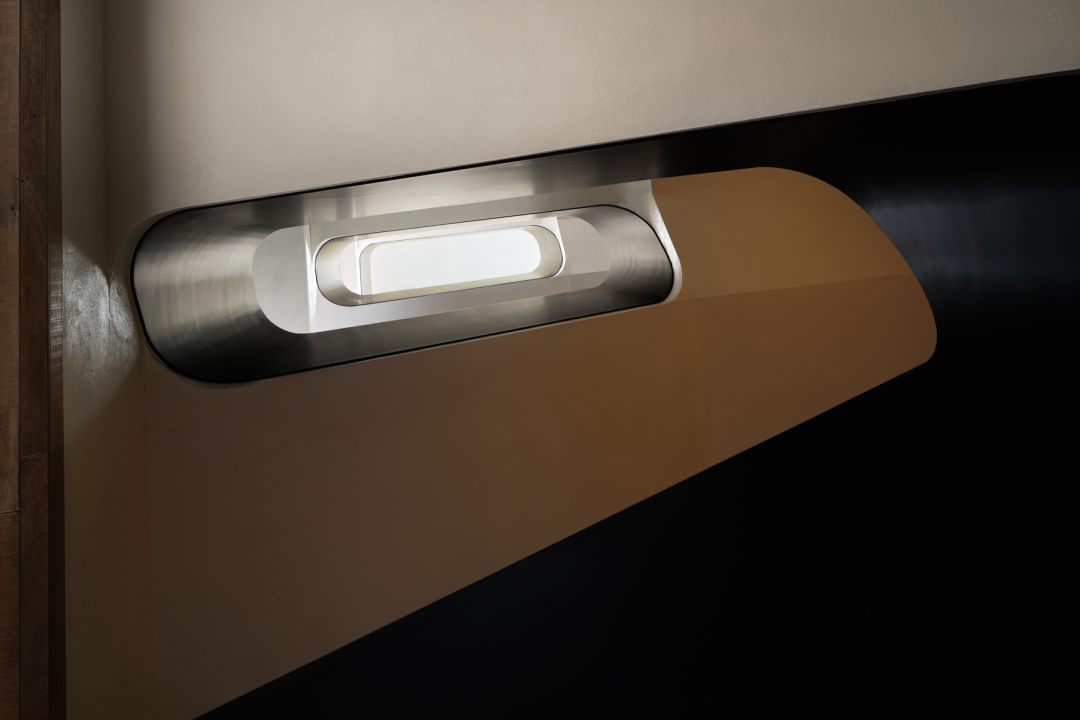
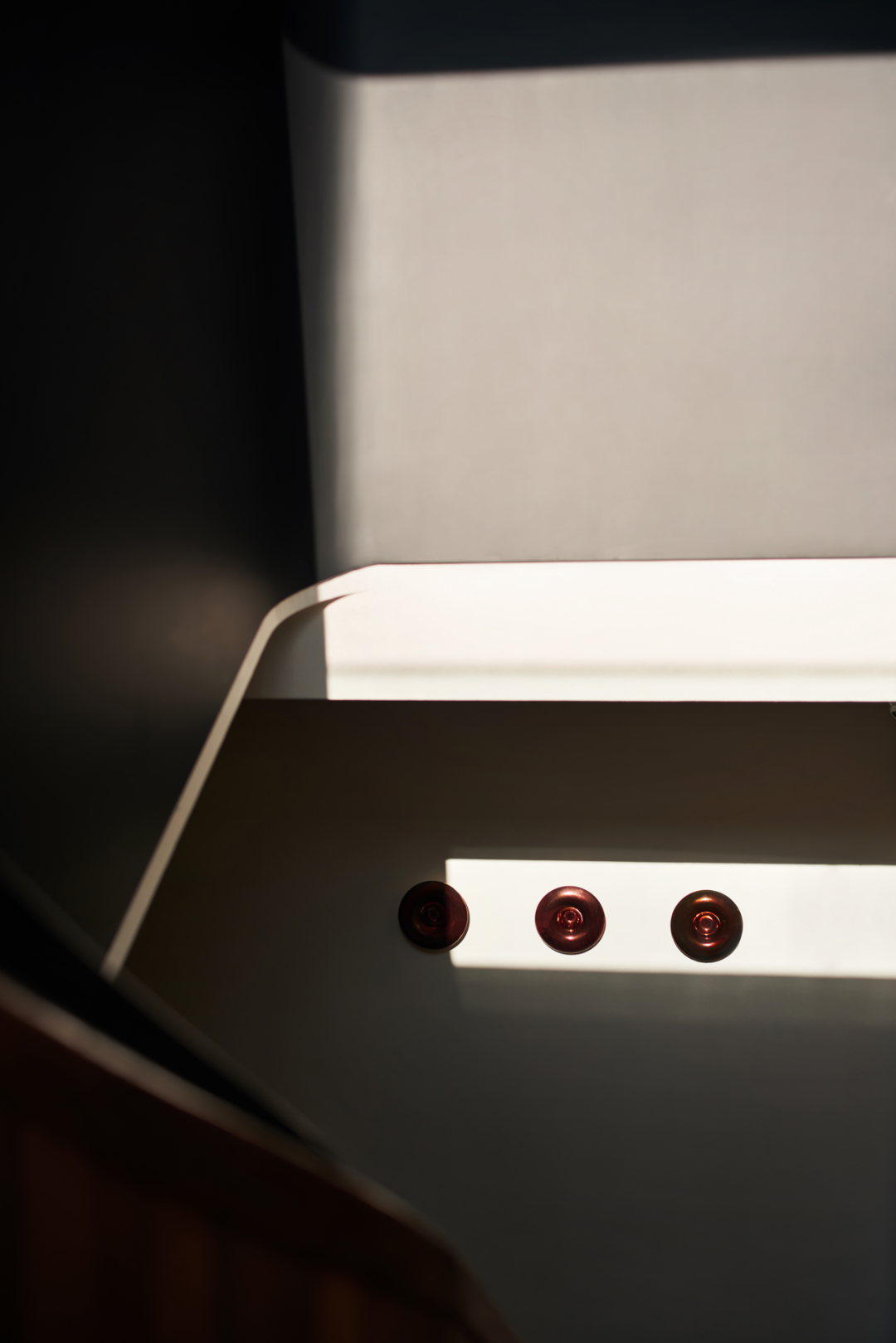
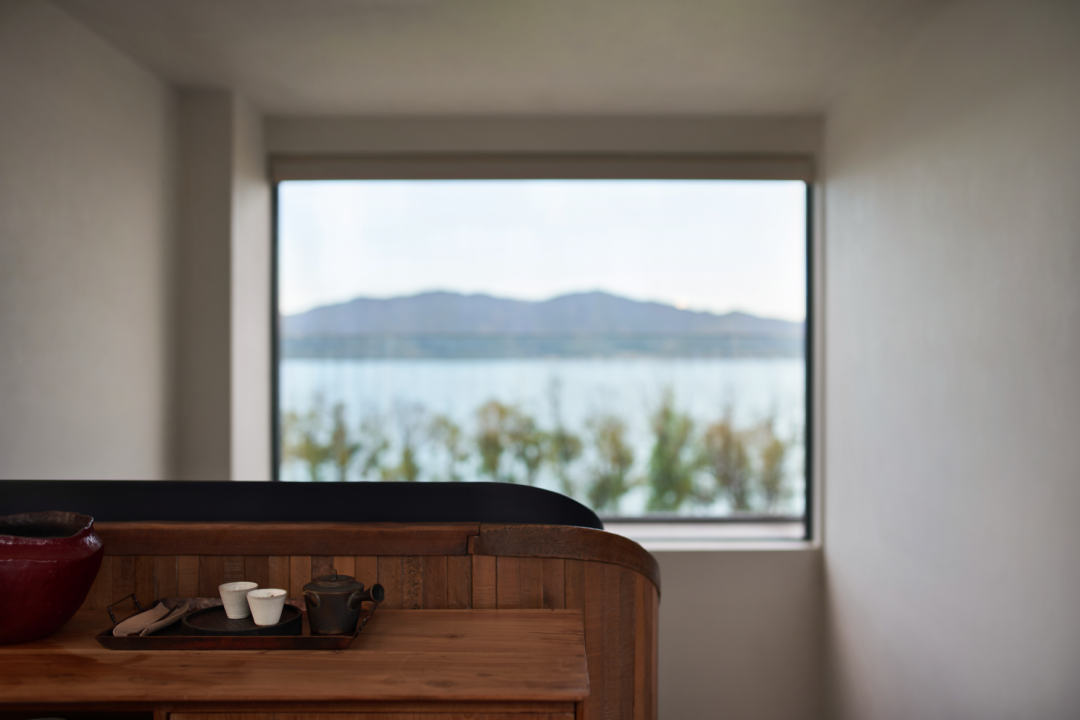
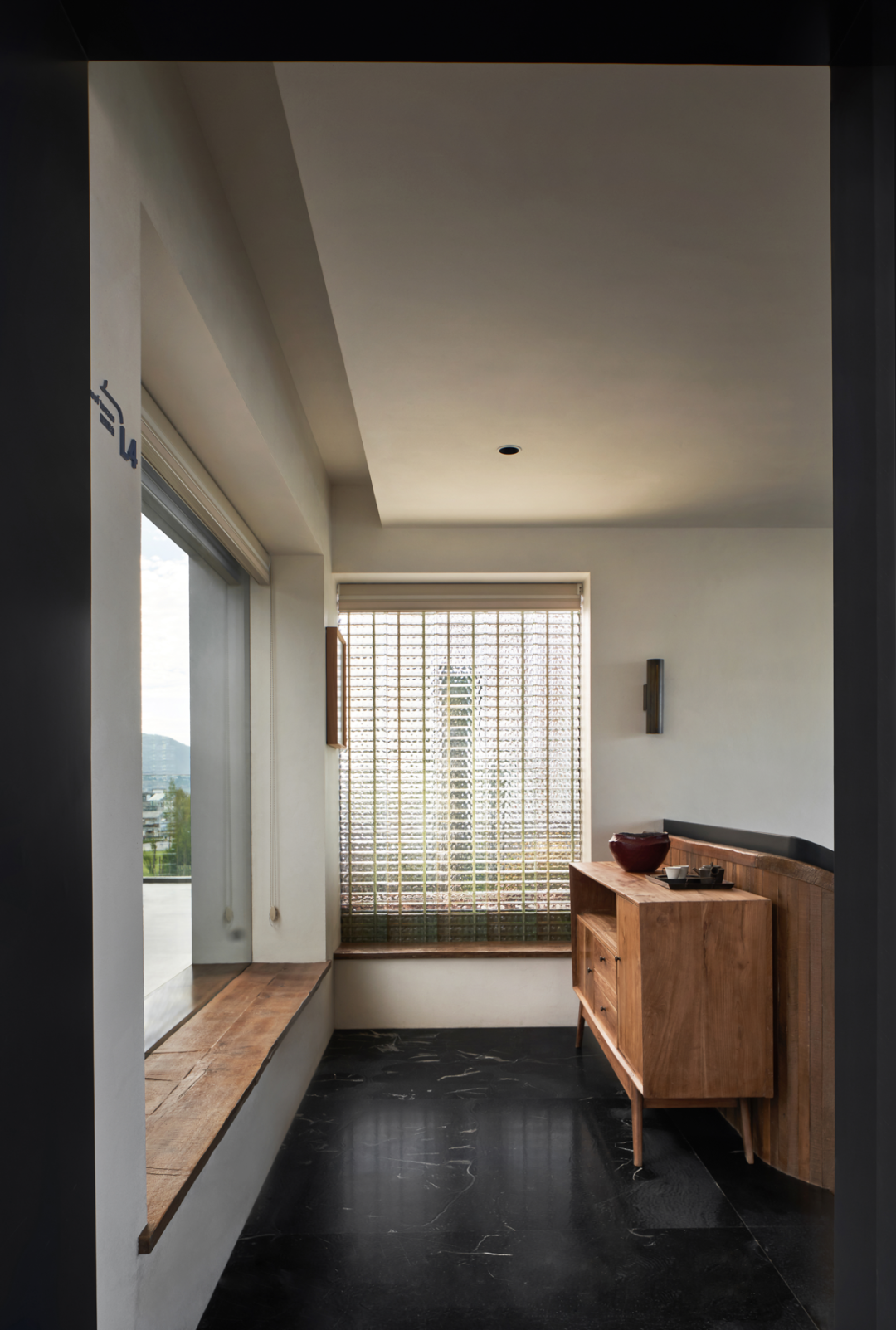
▲ 楼梯间以及楼梯细节
在这场迂回的叙事游戏中,人们从体验空间本身,转而到体验对苍山洱海的遥望,最终,空间在一览无余的顶端,把旅行的人们送返至对苍山洱海本身的体验之中。
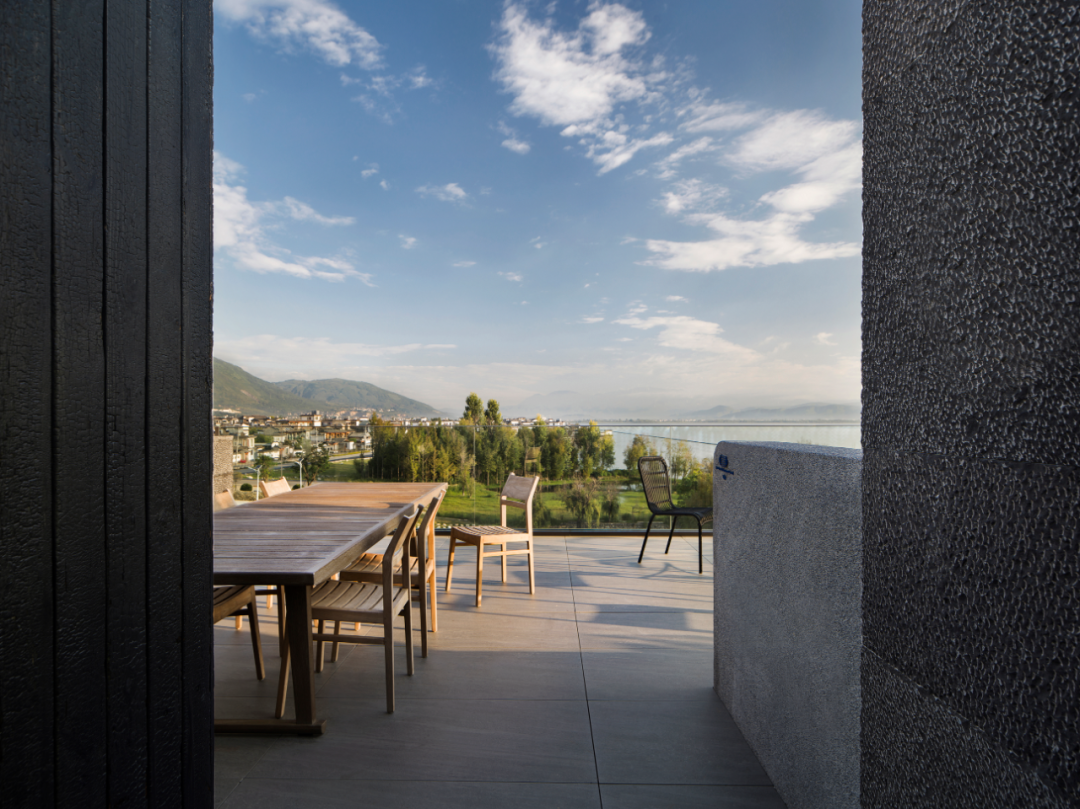
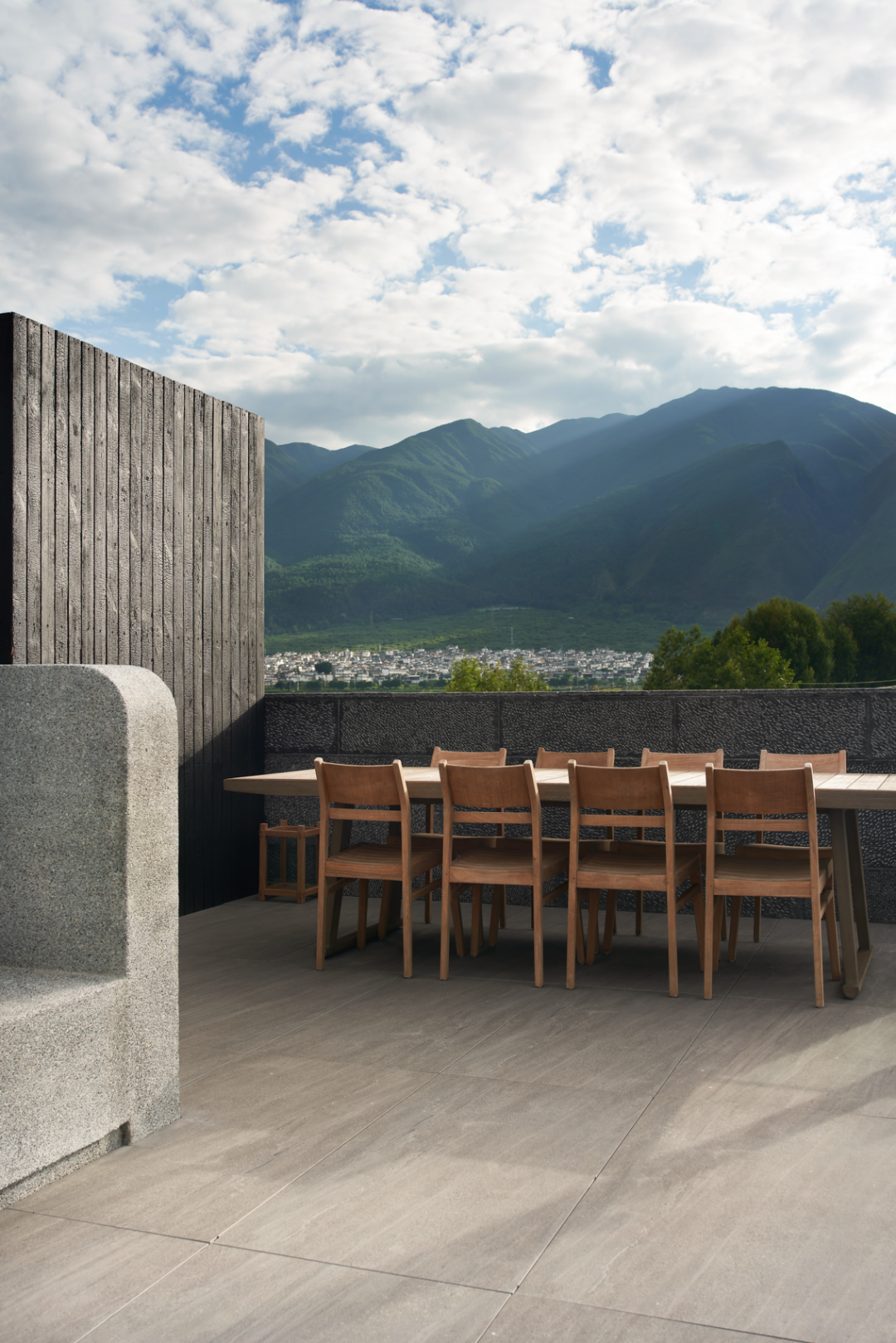
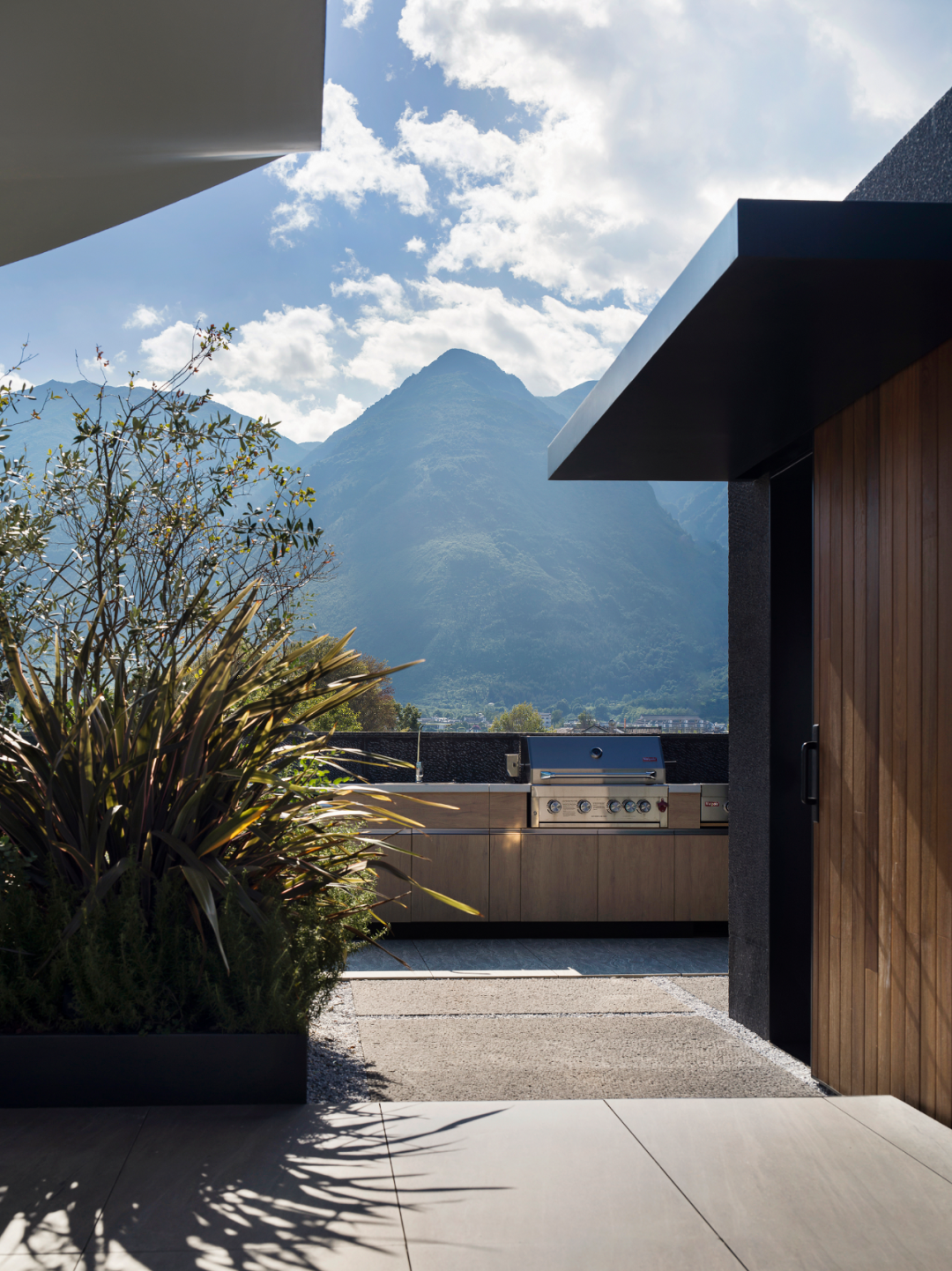
▲ 顶楼观景平台以及烧烤区
This seems to be a picture that is gradually going away. Travelers are attracted by the architectural space and come here from the foot of the mountain and the sea. And the openness and breadth of the roof presents mountains and water in front of people's eyes with great detail, and people regenerate their desire to visit Cangshan and Erhai once again.

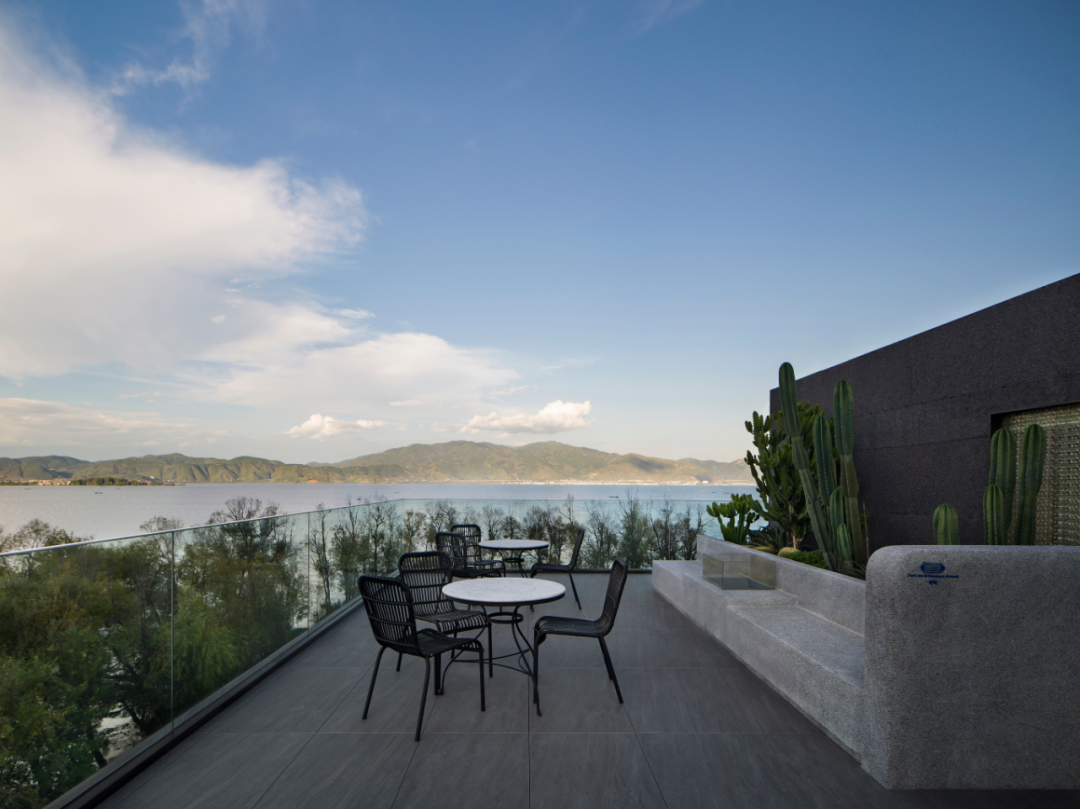
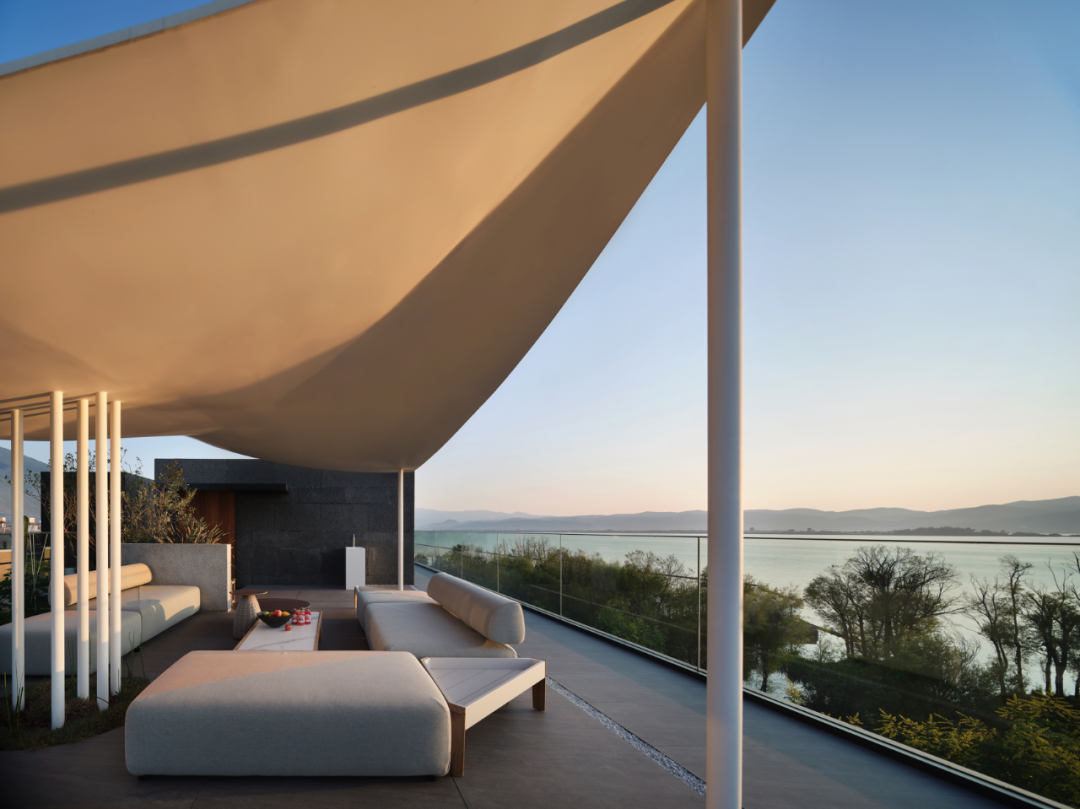
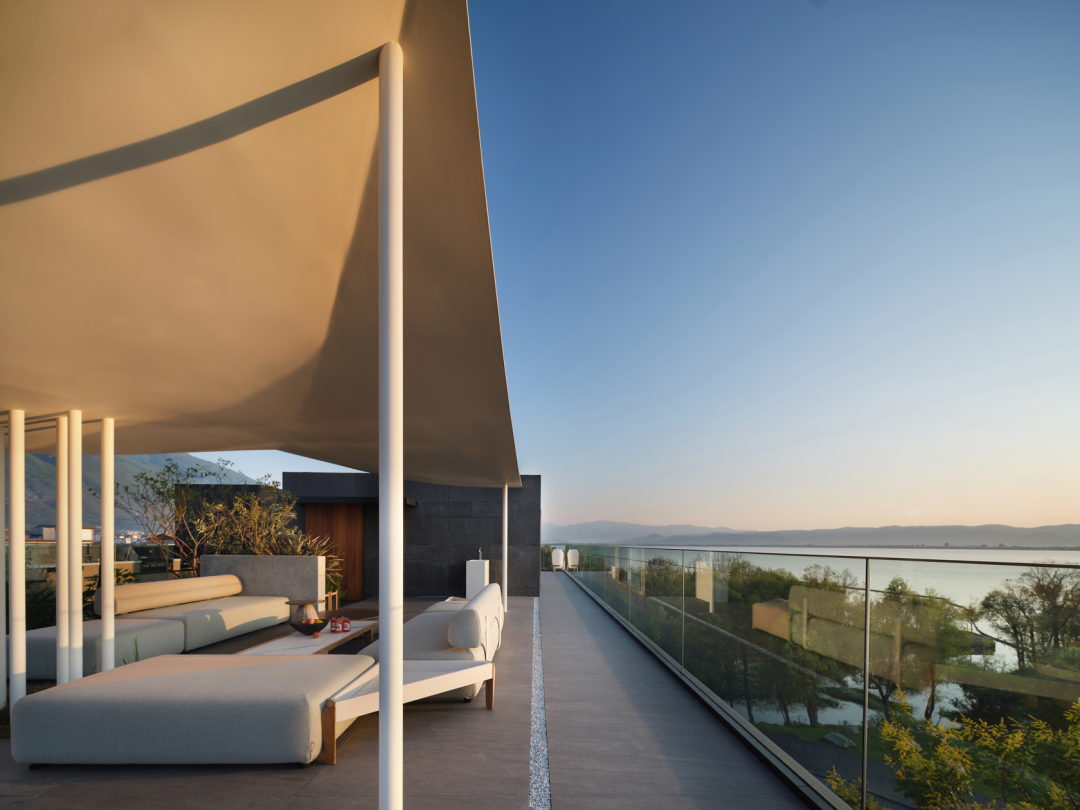 ▲ 顶楼休闲区,开阔的海景视野
▲ 顶楼休闲区,开阔的海景视野
这是一座关于面向自然的房子。在这里停留,重要的是如何与这个地方产生真实的联系,体会与众不同的此刻与当下。
To truly perceive the wind, perceive the clouds, perceive the changes of all things in the four seasons, under the Cangshan Mountains, Erhai Beach, perhaps not only a place of travel, but also a hometown, this hometown is slowly waking up.
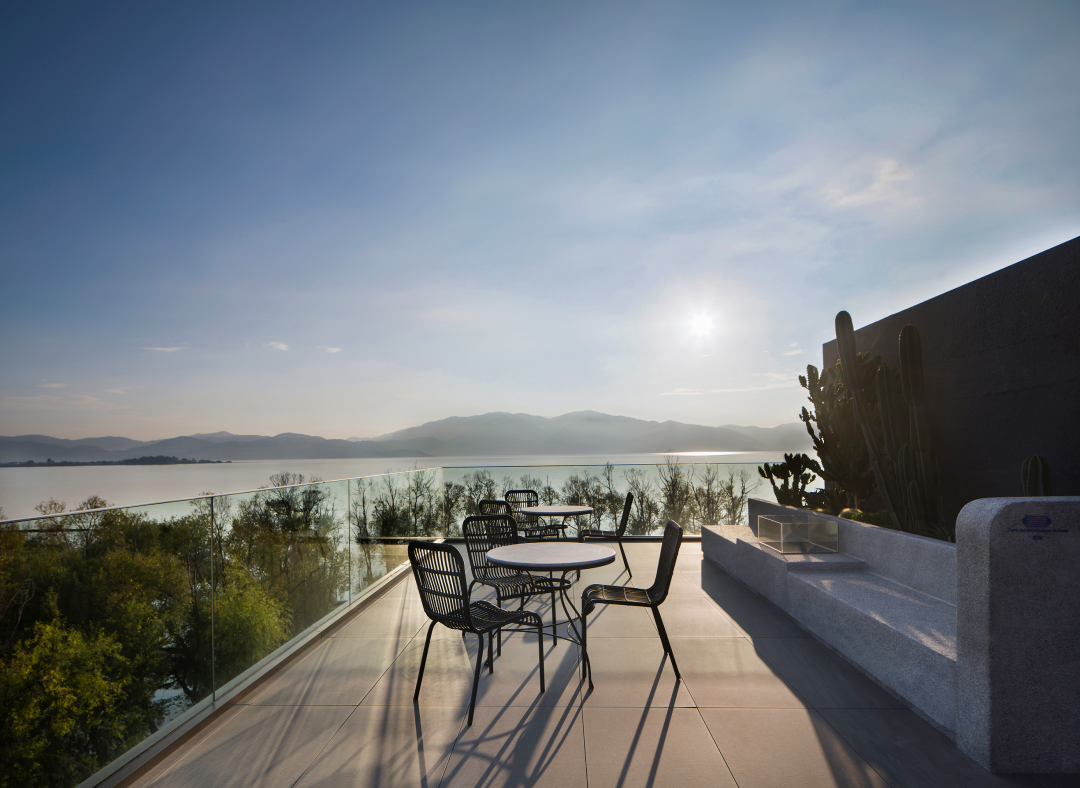
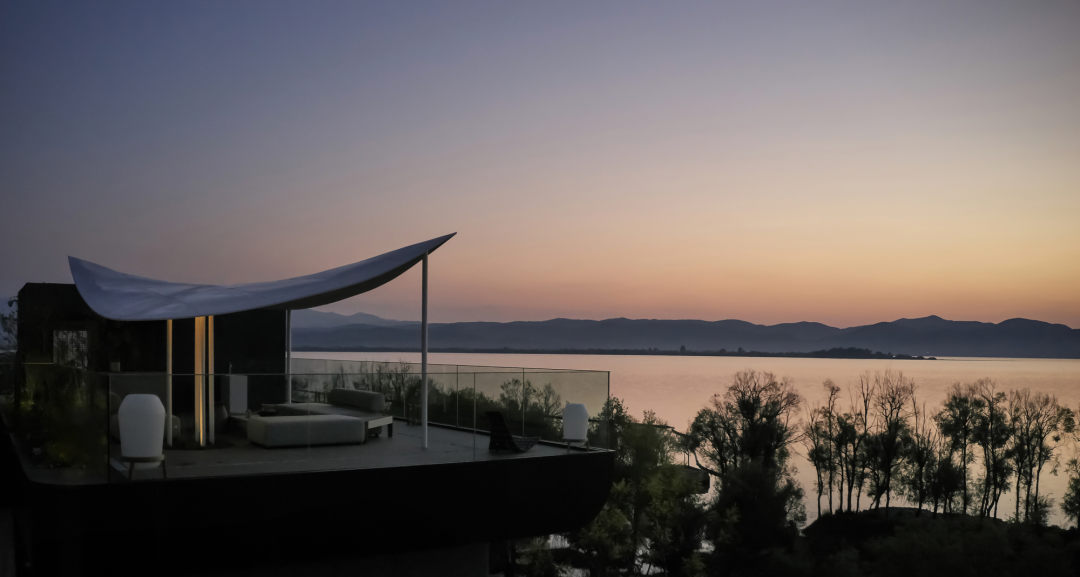
设计/对话 Design and Dialogue
Q1:酒店建筑很好的融入了当地的自然环境,是通过怎样的过程来表现在地性的?
与其说是融入当地的自然环境,不如说更多是融入当地的人文环境。比如建筑外墙上运用了当地人手工锤凿的麻石;庭院内有白族传统的照壁与门头,同样经由传统的手艺人制作而成;庭院与室内空间之间,由六扇雕花扇门相隔,可开可阖。
在对自然环境的处理上,我们更多是以开窗借景的方式,把苍山的苍翠秀丽与洱海的平阔静谧引入到室内的每一个房间内。在兰往,每一扇窗都是一道不同的风景,每一道风景里都蕴藏着苍山与洱海的不同气质。
Q2:通过怎样的细节设计来同时保留建筑的传统性和现代性?
传统性与现代性,听上去总是给人一种矛盾对立的状态,而这种矛盾与对立似乎也总是被很多人看作是一个亟待解决的问题。而我更愿意把现代性和传统性看作是一种文化历史时间上的承接关系,它们最吸引得我不是它们的不同,而恰恰是它们在时间的脉络上得以延续承接不变的东西,如概念、形态等。
比如,在兰往的庭院设计中,我们把中国传统文人对于山水的理解延续了下来,但却改变了水池的形式,用以更现代的方形水池来替代。在水中放一卧石代表山,这也是传统文化中“拳石当山”的概念,只是我们在选取石头的审美上更现代,少了古人对于顽石、多孔石的偏爱。顶楼的大型飞帆,也正是取自白族传统建筑中翘角飞檐的形态,只是通过现代的材料与工艺,让它更具现代感。
因此,我们在设计过程中,更多的是在考虑传统性的现代性表达,而不只是把传统的物件与现代的器物并置这么简单。
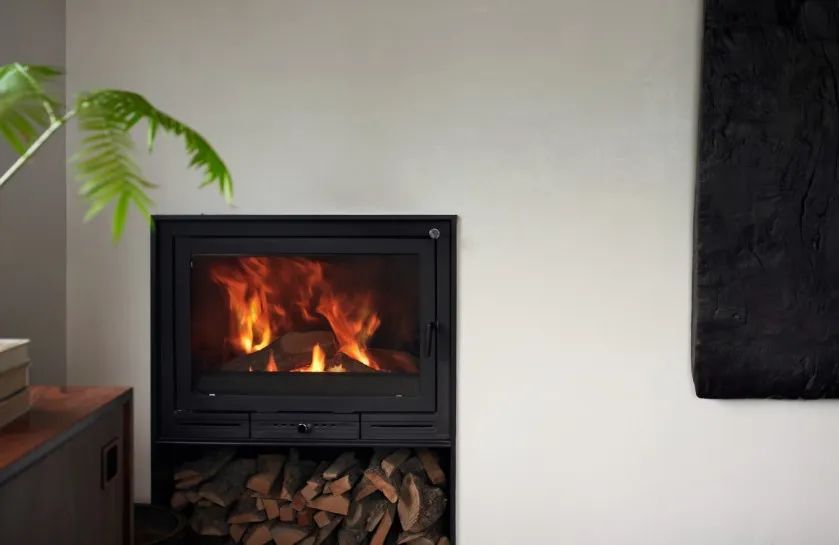
Q3:项目在几处使用了真火壁炉?壁炉在空间中被赋予怎样的意义?
一共有四个壁炉分布在兰往的各个区域。大厅有一个内嵌式铜质酒精壁炉、餐厅和二楼会客厅各有一个小壁炉、花园还有一个户外壁炉。
对于大厅和花园里的两个大壁炉来讲,它们不仅承担着取暖提供热量的功能,它们还为人们围炉而聚提供了明确的心理依据,勾起我们集体潜意识中对于火、食物、人与人之间最温暖最真挚的原初记忆。于是以壁炉为中心所辐射开来的范围,便成为了人们互动最密集的场域,人们在火光的偎依中,在相互的沟通中,慰藉自己,疗愈生活。
Q4:浅谈下最具亮点的一处壁炉的运用。
位于大厅里的铜质酒精壁炉是比较特别的一个。首先在于它的外形,为了呼应洱海的渔船我们给它设计了一个船头的造型,用全铜的材质进行构建,赋予壁炉温暖的感觉。与此同时,它的火苗也很具观赏性,温和,持续,在空气的摆动下微微的跃动。
它在操作上更简单,不会产生灰烬,更适合室内,可以根据需要调整火量的大小。如果说户外壁炉,更有火光熊熊的氛围,那么这个酒精壁炉则更像一位沉默的、无需照顾的老友,给你温暖和陪伴。尤其是在兰往冬日的清晨,太阳光和壁炉的火光同时升起,那种温暖直抵人心。
Q5:在壁炉的前期沟通与后续的施工过程,MOLONEY团队给您留下了哪些深刻印象?
在前期根据实际需求勘验尺寸并选品的过程中,MOLONEY团队都给予了专业而细致的指导与服务,帮助我们很好的匹配到最合适的壁炉的产品型号。而后,MOLONEY通过此前的沟通对壁炉进行方案的深化,解决一系列诸如排烟测试、管道安装方式等具体的问题,让壁炉的落地安装变得轻松且有效。
作为一个设计师,MOLONEY的专业性服务是最打动我的地方。

相上文象创始人&创意总监

项目地址丨大理 · 海西桃源村
设计总监丨李万鸿
设计执行丨任向东,陈彬彬,唐靓,罗晗,唐俊
结构设计丨栾栌构造设计
建筑改造、室内、软装、景观丨相上文象团队
项目面积 | 1000㎡
项目摄影与摄像丨翱翔
项目视频剪辑丨Harrylil

全程 1 对 1 专属服务
实地勘测,科学取量
根据用户情况,合理推荐
设计师直接对接,切实解决用户需求
上门安装,高效安全
收集客户反馈,及时解决问题